CHCCCS023 Workbook - Support Independence and Wellbeing
VerifiedAdded on 2023/06/10
|56
|10762
|494
AI Summary
This workbook is designed for learners to support independence and wellbeing. It includes activities, assessments, and instructions to respect social, cultural, and spiritual differences. The workbook also covers avoiding imposing own values and attitudes on others and supporting the person to express their own identity and preferences.
Contribute Materials
Your contribution can guide someone’s learning journey. Share your
documents today.
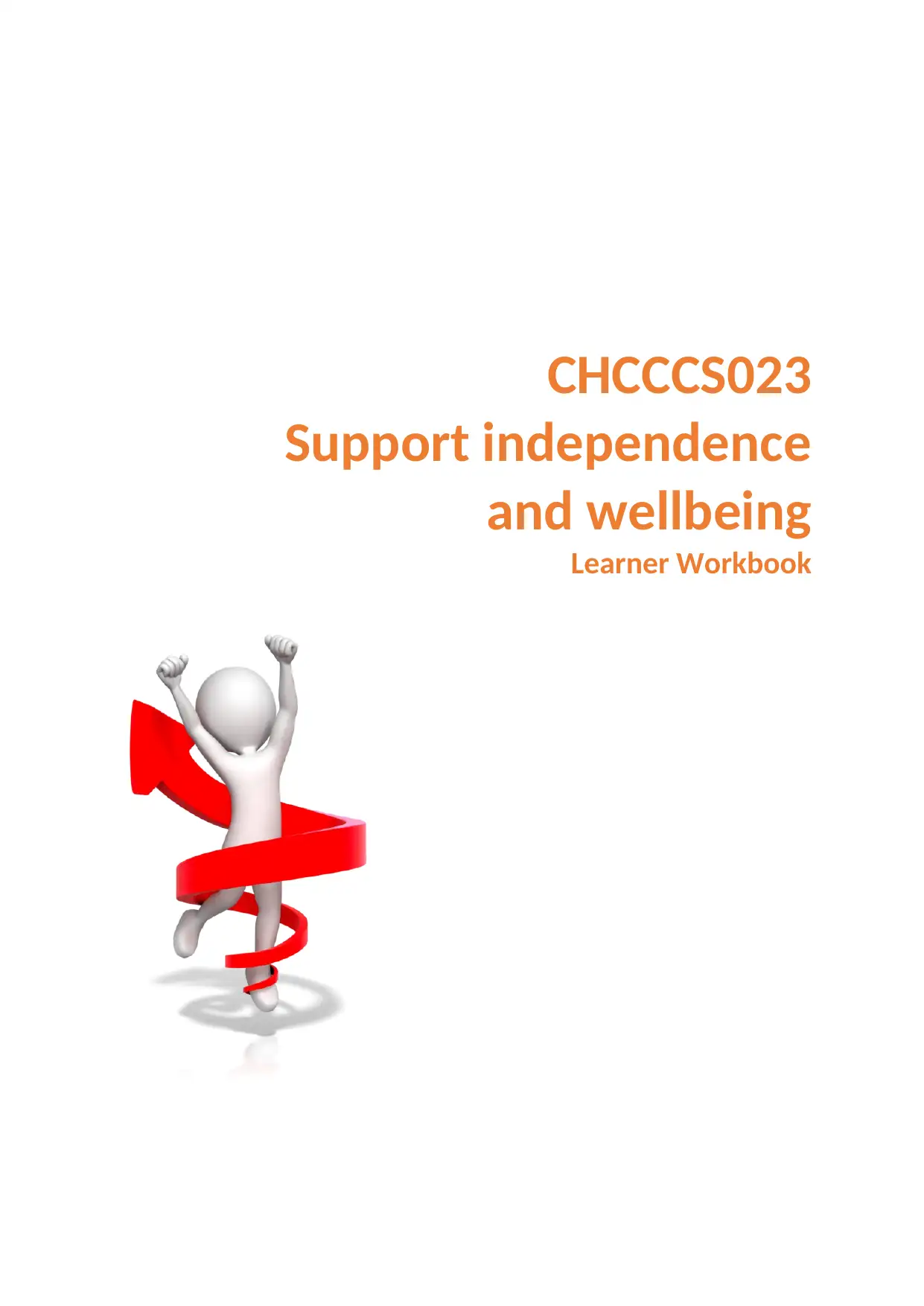
CHCCCS023
Support independence
and wellbeing
Learner Workbook
Support independence
and wellbeing
Learner Workbook
Secure Best Marks with AI Grader
Need help grading? Try our AI Grader for instant feedback on your assignments.
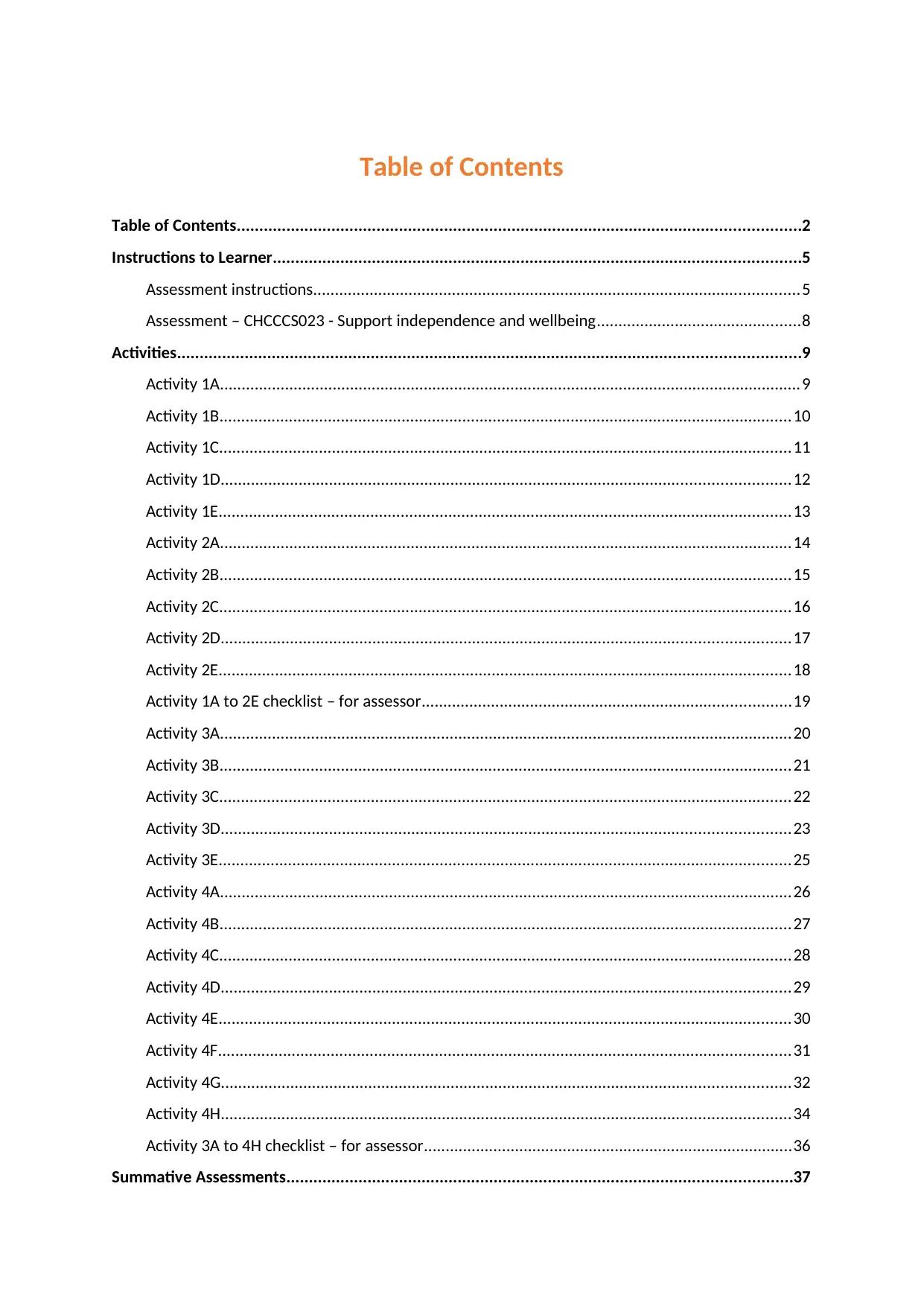
Table of Contents
Table of Contents.............................................................................................................................2
Instructions to Learner.....................................................................................................................5
Assessment instructions................................................................................................................5
Assessment – CHCCCS023 - Support independence and wellbeing...............................................8
Activities..........................................................................................................................................9
Activity 1A......................................................................................................................................9
Activity 1B....................................................................................................................................10
Activity 1C....................................................................................................................................11
Activity 1D...................................................................................................................................12
Activity 1E....................................................................................................................................13
Activity 2A....................................................................................................................................14
Activity 2B....................................................................................................................................15
Activity 2C....................................................................................................................................16
Activity 2D...................................................................................................................................17
Activity 2E....................................................................................................................................18
Activity 1A to 2E checklist – for assessor.....................................................................................19
Activity 3A....................................................................................................................................20
Activity 3B....................................................................................................................................21
Activity 3C....................................................................................................................................22
Activity 3D...................................................................................................................................23
Activity 3E....................................................................................................................................25
Activity 4A....................................................................................................................................26
Activity 4B....................................................................................................................................27
Activity 4C....................................................................................................................................28
Activity 4D...................................................................................................................................29
Activity 4E....................................................................................................................................30
Activity 4F....................................................................................................................................31
Activity 4G...................................................................................................................................32
Activity 4H...................................................................................................................................34
Activity 3A to 4H checklist – for assessor.....................................................................................36
Summative Assessments................................................................................................................37
Table of Contents.............................................................................................................................2
Instructions to Learner.....................................................................................................................5
Assessment instructions................................................................................................................5
Assessment – CHCCCS023 - Support independence and wellbeing...............................................8
Activities..........................................................................................................................................9
Activity 1A......................................................................................................................................9
Activity 1B....................................................................................................................................10
Activity 1C....................................................................................................................................11
Activity 1D...................................................................................................................................12
Activity 1E....................................................................................................................................13
Activity 2A....................................................................................................................................14
Activity 2B....................................................................................................................................15
Activity 2C....................................................................................................................................16
Activity 2D...................................................................................................................................17
Activity 2E....................................................................................................................................18
Activity 1A to 2E checklist – for assessor.....................................................................................19
Activity 3A....................................................................................................................................20
Activity 3B....................................................................................................................................21
Activity 3C....................................................................................................................................22
Activity 3D...................................................................................................................................23
Activity 3E....................................................................................................................................25
Activity 4A....................................................................................................................................26
Activity 4B....................................................................................................................................27
Activity 4C....................................................................................................................................28
Activity 4D...................................................................................................................................29
Activity 4E....................................................................................................................................30
Activity 4F....................................................................................................................................31
Activity 4G...................................................................................................................................32
Activity 4H...................................................................................................................................34
Activity 3A to 4H checklist – for assessor.....................................................................................36
Summative Assessments................................................................................................................37
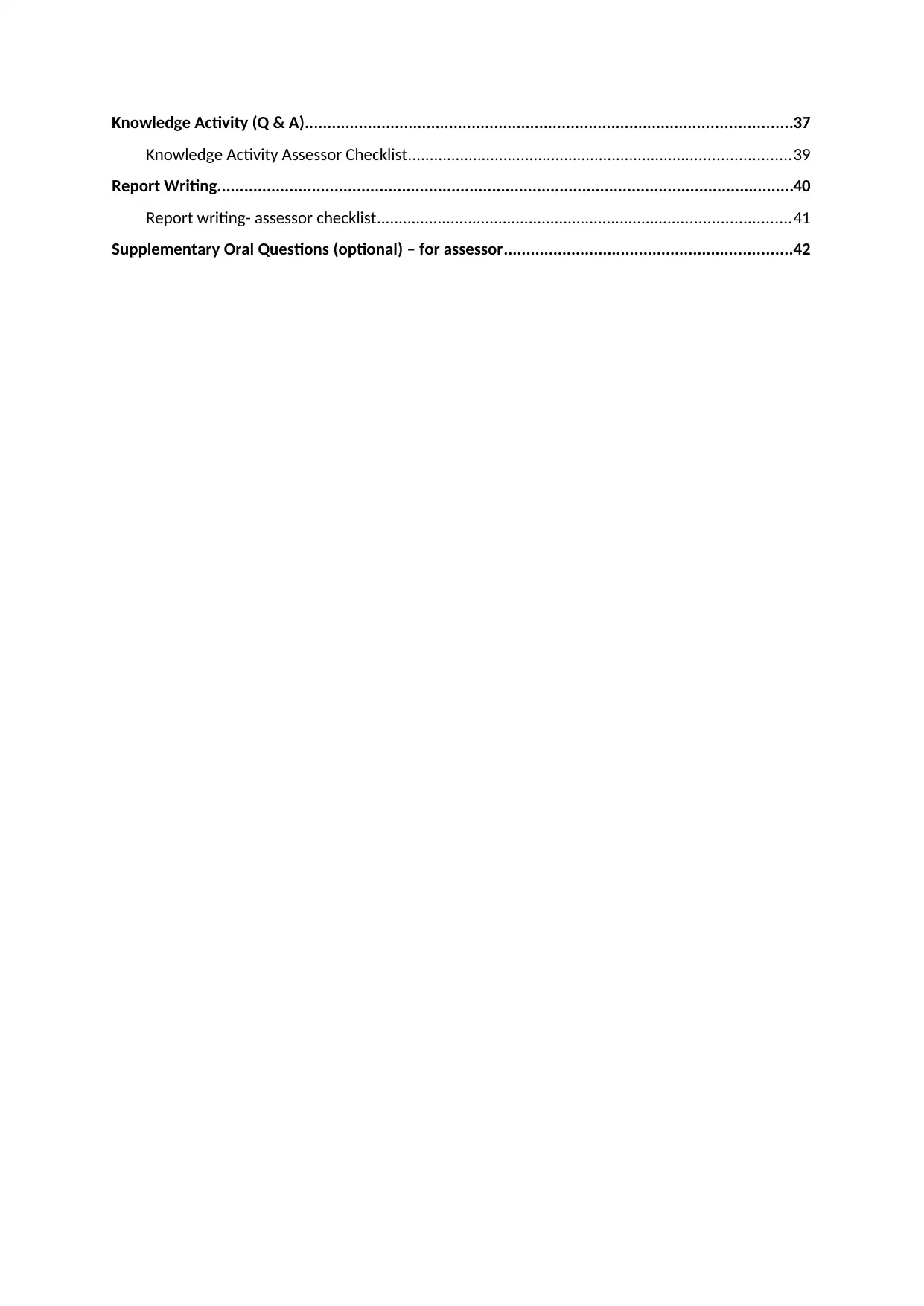
Knowledge Activity (Q & A)............................................................................................................37
Knowledge Activity Assessor Checklist........................................................................................39
Report Writing................................................................................................................................40
Report writing- assessor checklist...............................................................................................41
Supplementary Oral Questions (optional) – for assessor................................................................42
Knowledge Activity Assessor Checklist........................................................................................39
Report Writing................................................................................................................................40
Report writing- assessor checklist...............................................................................................41
Supplementary Oral Questions (optional) – for assessor................................................................42

Secure Best Marks with AI Grader
Need help grading? Try our AI Grader for instant feedback on your assignments.
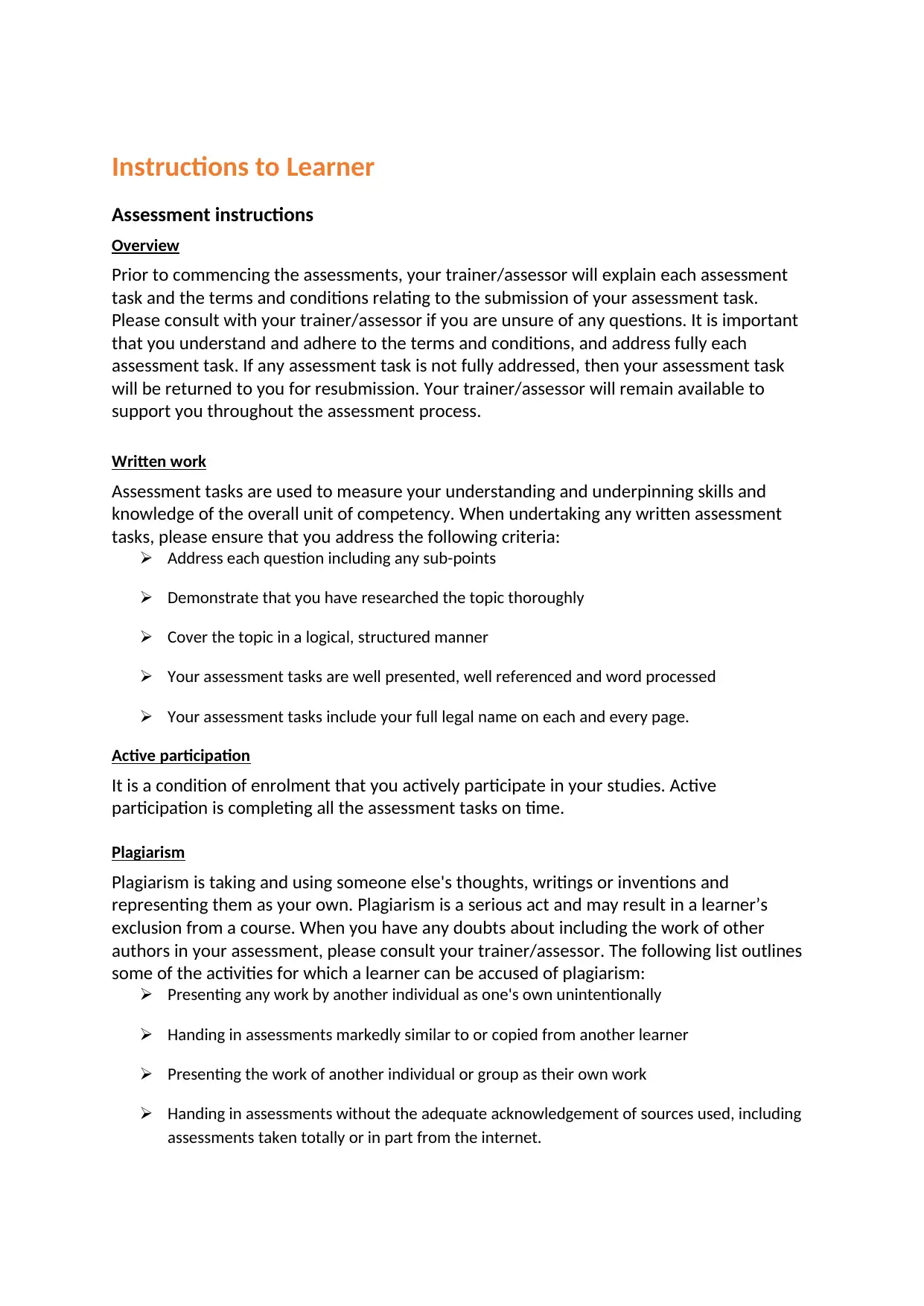
Instructions to Learner
Assessment instructions
Overview
Prior to commencing the assessments, your trainer/assessor will explain each assessment
task and the terms and conditions relating to the submission of your assessment task.
Please consult with your trainer/assessor if you are unsure of any questions. It is important
that you understand and adhere to the terms and conditions, and address fully each
assessment task. If any assessment task is not fully addressed, then your assessment task
will be returned to you for resubmission. Your trainer/assessor will remain available to
support you throughout the assessment process.
Written work
Assessment tasks are used to measure your understanding and underpinning skills and
knowledge of the overall unit of competency. When undertaking any written assessment
tasks, please ensure that you address the following criteria:
Address each question including any sub-points
Demonstrate that you have researched the topic thoroughly
Cover the topic in a logical, structured manner
Your assessment tasks are well presented, well referenced and word processed
Your assessment tasks include your full legal name on each and every page.
Active participation
It is a condition of enrolment that you actively participate in your studies. Active
participation is completing all the assessment tasks on time.
Plagiarism
Plagiarism is taking and using someone else's thoughts, writings or inventions and
representing them as your own. Plagiarism is a serious act and may result in a learner’s
exclusion from a course. When you have any doubts about including the work of other
authors in your assessment, please consult your trainer/assessor. The following list outlines
some of the activities for which a learner can be accused of plagiarism:
Presenting any work by another individual as one's own unintentionally
Handing in assessments markedly similar to or copied from another learner
Presenting the work of another individual or group as their own work
Handing in assessments without the adequate acknowledgement of sources used, including
assessments taken totally or in part from the internet.
Assessment instructions
Overview
Prior to commencing the assessments, your trainer/assessor will explain each assessment
task and the terms and conditions relating to the submission of your assessment task.
Please consult with your trainer/assessor if you are unsure of any questions. It is important
that you understand and adhere to the terms and conditions, and address fully each
assessment task. If any assessment task is not fully addressed, then your assessment task
will be returned to you for resubmission. Your trainer/assessor will remain available to
support you throughout the assessment process.
Written work
Assessment tasks are used to measure your understanding and underpinning skills and
knowledge of the overall unit of competency. When undertaking any written assessment
tasks, please ensure that you address the following criteria:
Address each question including any sub-points
Demonstrate that you have researched the topic thoroughly
Cover the topic in a logical, structured manner
Your assessment tasks are well presented, well referenced and word processed
Your assessment tasks include your full legal name on each and every page.
Active participation
It is a condition of enrolment that you actively participate in your studies. Active
participation is completing all the assessment tasks on time.
Plagiarism
Plagiarism is taking and using someone else's thoughts, writings or inventions and
representing them as your own. Plagiarism is a serious act and may result in a learner’s
exclusion from a course. When you have any doubts about including the work of other
authors in your assessment, please consult your trainer/assessor. The following list outlines
some of the activities for which a learner can be accused of plagiarism:
Presenting any work by another individual as one's own unintentionally
Handing in assessments markedly similar to or copied from another learner
Presenting the work of another individual or group as their own work
Handing in assessments without the adequate acknowledgement of sources used, including
assessments taken totally or in part from the internet.
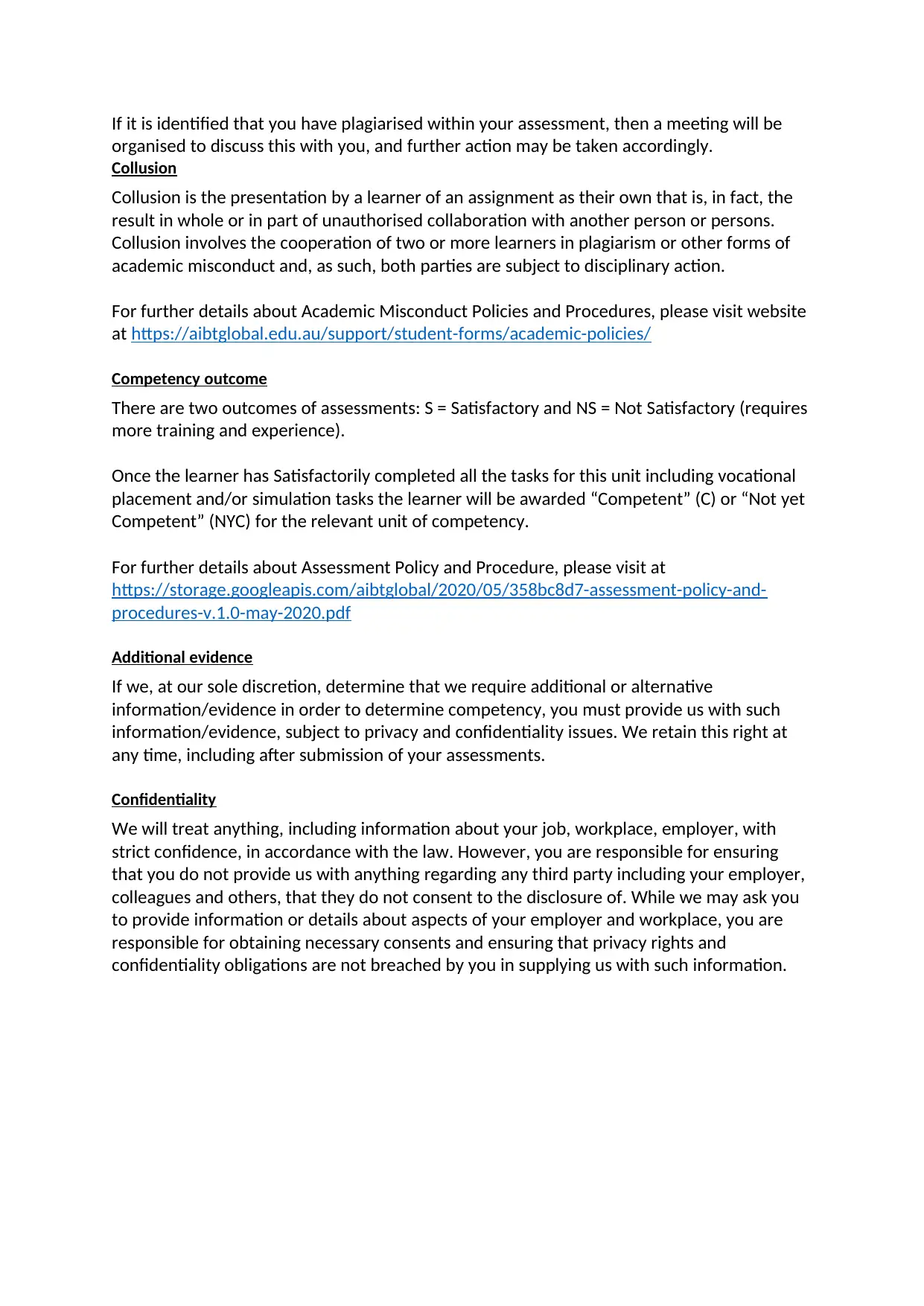
If it is identified that you have plagiarised within your assessment, then a meeting will be
organised to discuss this with you, and further action may be taken accordingly.
Collusion
Collusion is the presentation by a learner of an assignment as their own that is, in fact, the
result in whole or in part of unauthorised collaboration with another person or persons.
Collusion involves the cooperation of two or more learners in plagiarism or other forms of
academic misconduct and, as such, both parties are subject to disciplinary action.
For further details about Academic Misconduct Policies and Procedures, please visit website
at https://aibtglobal.edu.au/support/student-forms/academic-policies/
Competency outcome
There are two outcomes of assessments: S = Satisfactory and NS = Not Satisfactory (requires
more training and experience).
Once the learner has Satisfactorily completed all the tasks for this unit including vocational
placement and/or simulation tasks the learner will be awarded “Competent” (C) or “Not yet
Competent” (NYC) for the relevant unit of competency.
For further details about Assessment Policy and Procedure, please visit at
https://storage.googleapis.com/aibtglobal/2020/05/358bc8d7-assessment-policy-and-
procedures-v.1.0-may-2020.pdf
Additional evidence
If we, at our sole discretion, determine that we require additional or alternative
information/evidence in order to determine competency, you must provide us with such
information/evidence, subject to privacy and confidentiality issues. We retain this right at
any time, including after submission of your assessments.
Confidentiality
We will treat anything, including information about your job, workplace, employer, with
strict confidence, in accordance with the law. However, you are responsible for ensuring
that you do not provide us with anything regarding any third party including your employer,
colleagues and others, that they do not consent to the disclosure of. While we may ask you
to provide information or details about aspects of your employer and workplace, you are
responsible for obtaining necessary consents and ensuring that privacy rights and
confidentiality obligations are not breached by you in supplying us with such information.
organised to discuss this with you, and further action may be taken accordingly.
Collusion
Collusion is the presentation by a learner of an assignment as their own that is, in fact, the
result in whole or in part of unauthorised collaboration with another person or persons.
Collusion involves the cooperation of two or more learners in plagiarism or other forms of
academic misconduct and, as such, both parties are subject to disciplinary action.
For further details about Academic Misconduct Policies and Procedures, please visit website
at https://aibtglobal.edu.au/support/student-forms/academic-policies/
Competency outcome
There are two outcomes of assessments: S = Satisfactory and NS = Not Satisfactory (requires
more training and experience).
Once the learner has Satisfactorily completed all the tasks for this unit including vocational
placement and/or simulation tasks the learner will be awarded “Competent” (C) or “Not yet
Competent” (NYC) for the relevant unit of competency.
For further details about Assessment Policy and Procedure, please visit at
https://storage.googleapis.com/aibtglobal/2020/05/358bc8d7-assessment-policy-and-
procedures-v.1.0-may-2020.pdf
Additional evidence
If we, at our sole discretion, determine that we require additional or alternative
information/evidence in order to determine competency, you must provide us with such
information/evidence, subject to privacy and confidentiality issues. We retain this right at
any time, including after submission of your assessments.
Confidentiality
We will treat anything, including information about your job, workplace, employer, with
strict confidence, in accordance with the law. However, you are responsible for ensuring
that you do not provide us with anything regarding any third party including your employer,
colleagues and others, that they do not consent to the disclosure of. While we may ask you
to provide information or details about aspects of your employer and workplace, you are
responsible for obtaining necessary consents and ensuring that privacy rights and
confidentiality obligations are not breached by you in supplying us with such information.
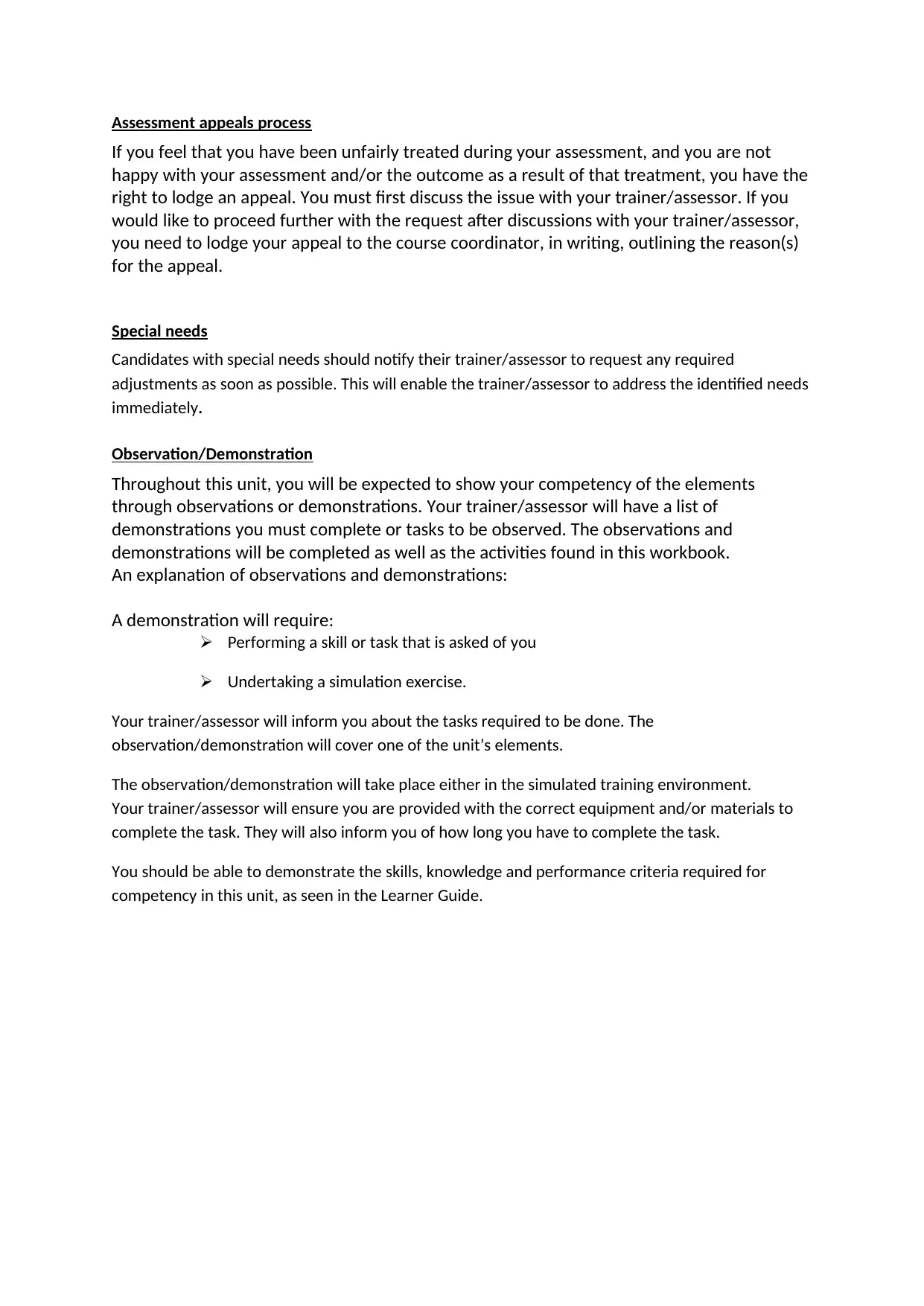
Assessment appeals process
If you feel that you have been unfairly treated during your assessment, and you are not
happy with your assessment and/or the outcome as a result of that treatment, you have the
right to lodge an appeal. You must first discuss the issue with your trainer/assessor. If you
would like to proceed further with the request after discussions with your trainer/assessor,
you need to lodge your appeal to the course coordinator, in writing, outlining the reason(s)
for the appeal.
Special needs
Candidates with special needs should notify their trainer/assessor to request any required
adjustments as soon as possible. This will enable the trainer/assessor to address the identified needs
immediately .
Observation/Demonstration
Throughout this unit, you will be expected to show your competency of the elements
through observations or demonstrations. Your trainer/assessor will have a list of
demonstrations you must complete or tasks to be observed. The observations and
demonstrations will be completed as well as the activities found in this workbook.
An explanation of observations and demonstrations:
A demonstration will require:
Performing a skill or task that is asked of you
Undertaking a simulation exercise.
Your trainer/assessor will inform you about the tasks required to be done. The
observation/demonstration will cover one of the unit’s elements.
The observation/demonstration will take place either in the simulated training environment.
Your trainer/assessor will ensure you are provided with the correct equipment and/or materials to
complete the task. They will also inform you of how long you have to complete the task.
You should be able to demonstrate the skills, knowledge and performance criteria required for
competency in this unit, as seen in the Learner Guide.
If you feel that you have been unfairly treated during your assessment, and you are not
happy with your assessment and/or the outcome as a result of that treatment, you have the
right to lodge an appeal. You must first discuss the issue with your trainer/assessor. If you
would like to proceed further with the request after discussions with your trainer/assessor,
you need to lodge your appeal to the course coordinator, in writing, outlining the reason(s)
for the appeal.
Special needs
Candidates with special needs should notify their trainer/assessor to request any required
adjustments as soon as possible. This will enable the trainer/assessor to address the identified needs
immediately .
Observation/Demonstration
Throughout this unit, you will be expected to show your competency of the elements
through observations or demonstrations. Your trainer/assessor will have a list of
demonstrations you must complete or tasks to be observed. The observations and
demonstrations will be completed as well as the activities found in this workbook.
An explanation of observations and demonstrations:
A demonstration will require:
Performing a skill or task that is asked of you
Undertaking a simulation exercise.
Your trainer/assessor will inform you about the tasks required to be done. The
observation/demonstration will cover one of the unit’s elements.
The observation/demonstration will take place either in the simulated training environment.
Your trainer/assessor will ensure you are provided with the correct equipment and/or materials to
complete the task. They will also inform you of how long you have to complete the task.
You should be able to demonstrate the skills, knowledge and performance criteria required for
competency in this unit, as seen in the Learner Guide.
Paraphrase This Document
Need a fresh take? Get an instant paraphrase of this document with our AI Paraphraser
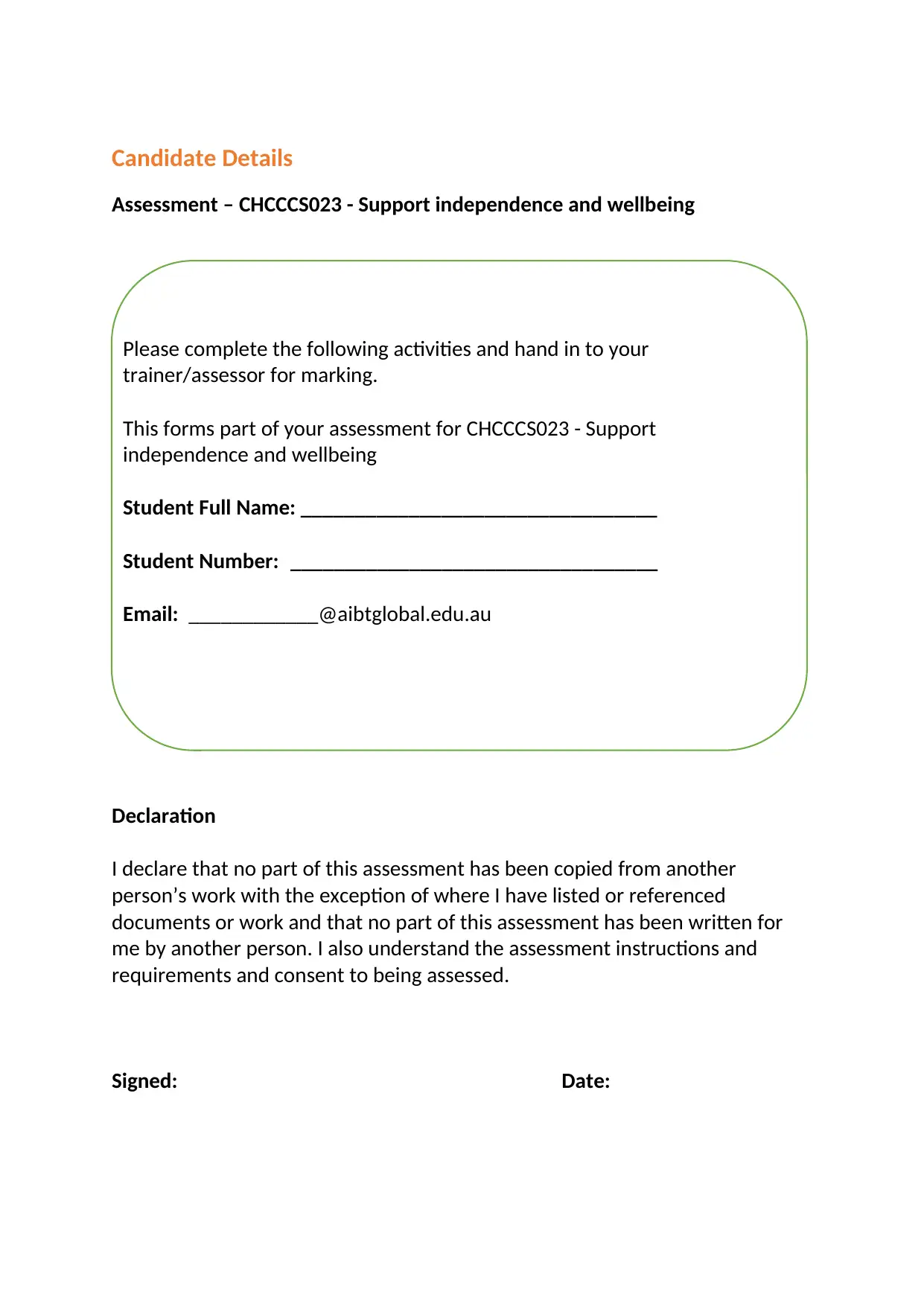
Candidate Details
Assessment – CHCCCS023 - Support independence and wellbeing
Declaration
I declare that no part of this assessment has been copied from another
person’s work with the exception of where I have listed or referenced
documents or work and that no part of this assessment has been written for
me by another person. I also understand the assessment instructions and
requirements and consent to being assessed.
Signed: Date:
Please complete the following activities and hand in to your
trainer/assessor for marking.
This forms part of your assessment for CHCCCS023 - Support
independence and wellbeing
Student Full Name: _________________________________
Student Number: __________________________________
Email: ____________@aibtglobal.edu.au
Assessment – CHCCCS023 - Support independence and wellbeing
Declaration
I declare that no part of this assessment has been copied from another
person’s work with the exception of where I have listed or referenced
documents or work and that no part of this assessment has been written for
me by another person. I also understand the assessment instructions and
requirements and consent to being assessed.
Signed: Date:
Please complete the following activities and hand in to your
trainer/assessor for marking.
This forms part of your assessment for CHCCCS023 - Support
independence and wellbeing
Student Full Name: _________________________________
Student Number: __________________________________
Email: ____________@aibtglobal.edu.au
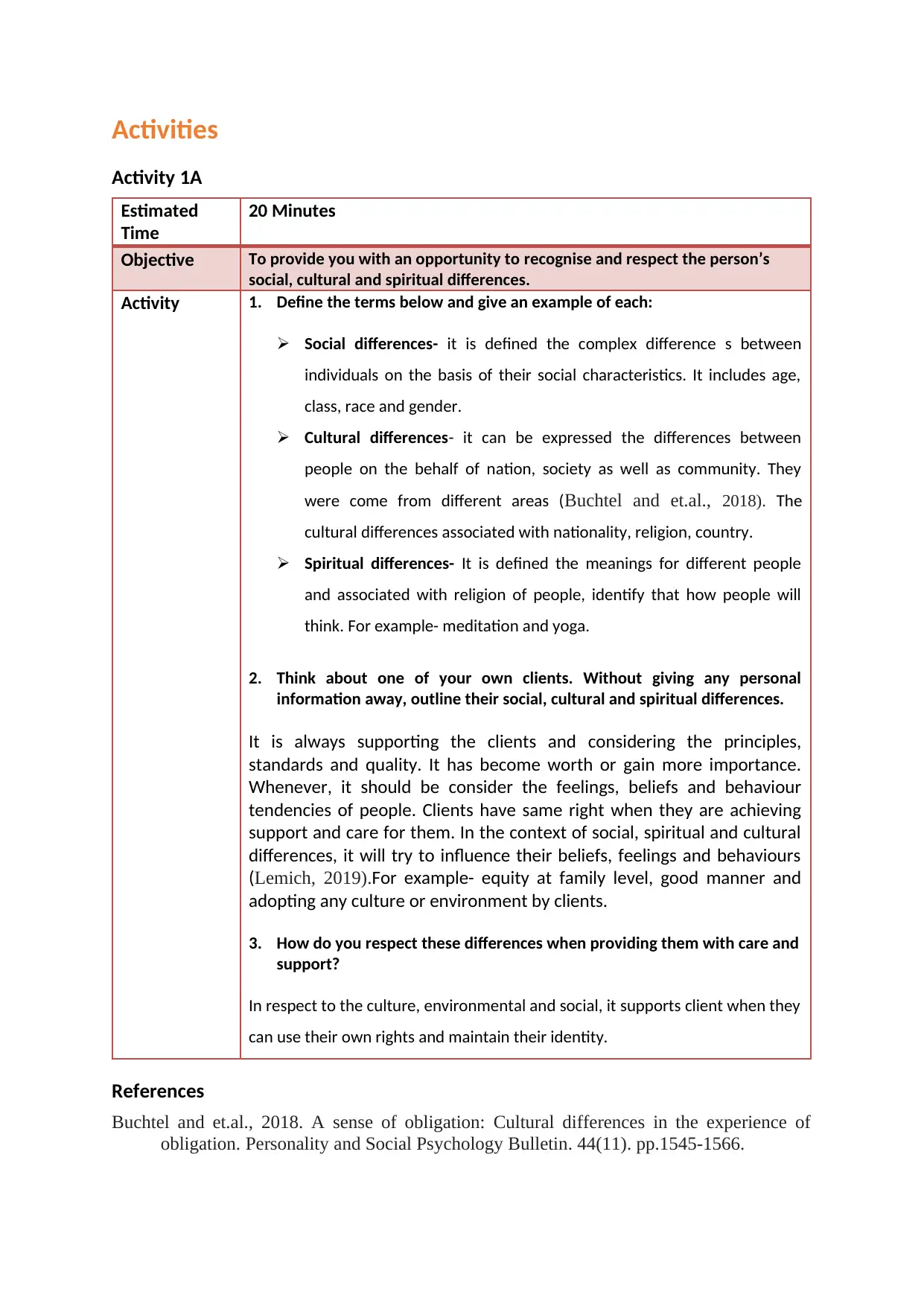
Activities
Activity 1A
Estimated
Time
20 Minutes
Objective To provide you with an opportunity to recognise and respect the person’s
social, cultural and spiritual differences.
Activity 1. Define the terms below and give an example of each:
Social differences- it is defined the complex difference s between
individuals on the basis of their social characteristics. It includes age,
class, race and gender.
Cultural differences- it can be expressed the differences between
people on the behalf of nation, society as well as community. They
were come from different areas (Buchtel and et.al., 2018). The
cultural differences associated with nationality, religion, country.
Spiritual differences- It is defined the meanings for different people
and associated with religion of people, identify that how people will
think. For example- meditation and yoga.
2. Think about one of your own clients. Without giving any personal
information away, outline their social, cultural and spiritual differences.
It is always supporting the clients and considering the principles,
standards and quality. It has become worth or gain more importance.
Whenever, it should be consider the feelings, beliefs and behaviour
tendencies of people. Clients have same right when they are achieving
support and care for them. In the context of social, spiritual and cultural
differences, it will try to influence their beliefs, feelings and behaviours
(Lemich, 2019).For example- equity at family level, good manner and
adopting any culture or environment by clients.
3. How do you respect these differences when providing them with care and
support?
In respect to the culture, environmental and social, it supports client when they
can use their own rights and maintain their identity.
References
Buchtel and et.al., 2018. A sense of obligation: Cultural differences in the experience of
obligation. Personality and Social Psychology Bulletin. 44(11). pp.1545-1566.
Activity 1A
Estimated
Time
20 Minutes
Objective To provide you with an opportunity to recognise and respect the person’s
social, cultural and spiritual differences.
Activity 1. Define the terms below and give an example of each:
Social differences- it is defined the complex difference s between
individuals on the basis of their social characteristics. It includes age,
class, race and gender.
Cultural differences- it can be expressed the differences between
people on the behalf of nation, society as well as community. They
were come from different areas (Buchtel and et.al., 2018). The
cultural differences associated with nationality, religion, country.
Spiritual differences- It is defined the meanings for different people
and associated with religion of people, identify that how people will
think. For example- meditation and yoga.
2. Think about one of your own clients. Without giving any personal
information away, outline their social, cultural and spiritual differences.
It is always supporting the clients and considering the principles,
standards and quality. It has become worth or gain more importance.
Whenever, it should be consider the feelings, beliefs and behaviour
tendencies of people. Clients have same right when they are achieving
support and care for them. In the context of social, spiritual and cultural
differences, it will try to influence their beliefs, feelings and behaviours
(Lemich, 2019).For example- equity at family level, good manner and
adopting any culture or environment by clients.
3. How do you respect these differences when providing them with care and
support?
In respect to the culture, environmental and social, it supports client when they
can use their own rights and maintain their identity.
References
Buchtel and et.al., 2018. A sense of obligation: Cultural differences in the experience of
obligation. Personality and Social Psychology Bulletin. 44(11). pp.1545-1566.

Lemich, G.C., 2019. Comparing Higher Order Value Differences By Religious and Spiritual
Association and Implications for Counseling: An Exploratory Study (Doctoral
dissertation, Old Dominion University).
Association and Implications for Counseling: An Exploratory Study (Doctoral
dissertation, Old Dominion University).
Secure Best Marks with AI Grader
Need help grading? Try our AI Grader for instant feedback on your assignments.
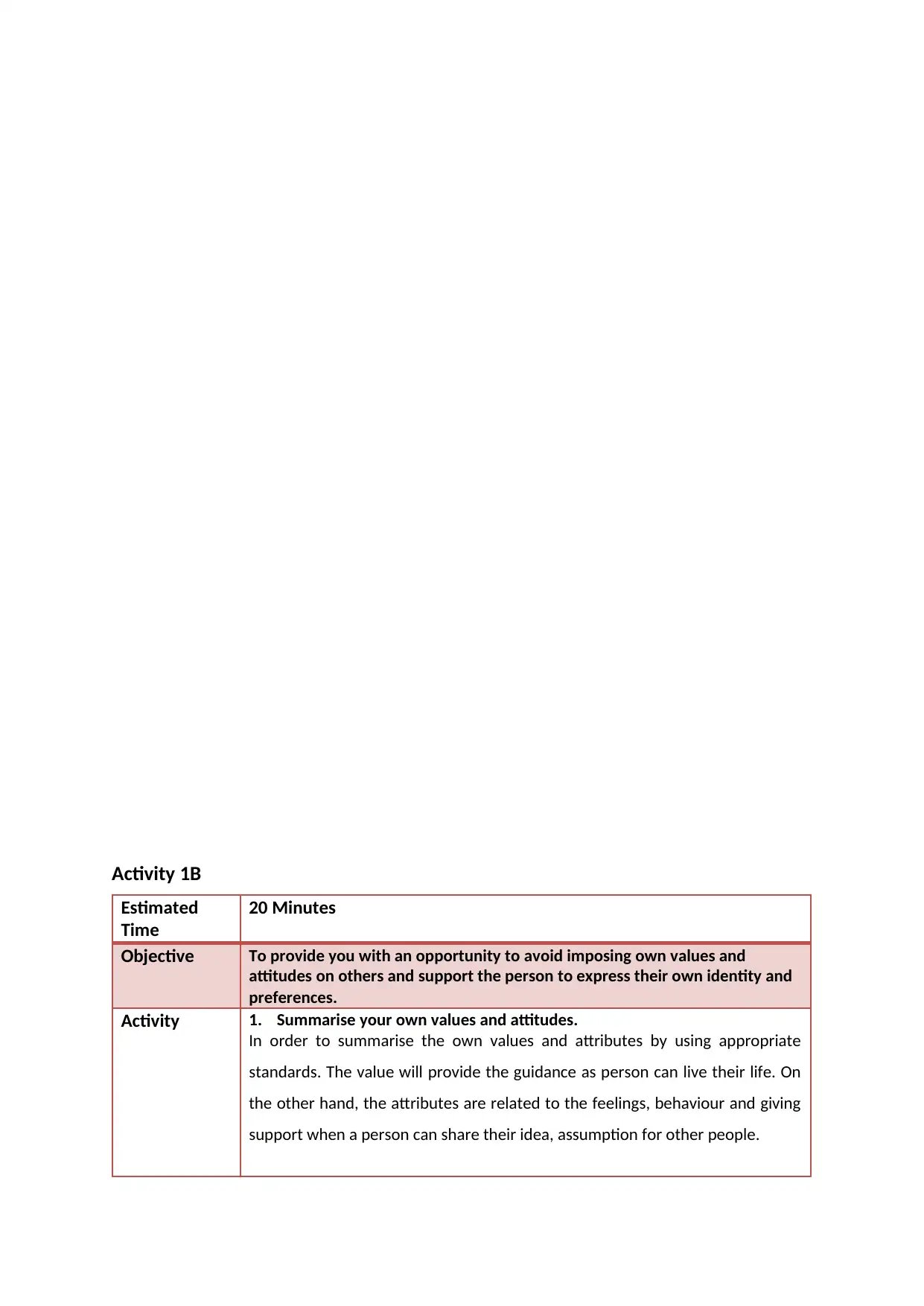
Activity 1B
Estimated
Time
20 Minutes
Objective To provide you with an opportunity to avoid imposing own values and
attitudes on others and support the person to express their own identity and
preferences.
Activity 1. Summarise your own values and attitudes.
In order to summarise the own values and attributes by using appropriate
standards. The value will provide the guidance as person can live their life. On
the other hand, the attributes are related to the feelings, behaviour and giving
support when a person can share their idea, assumption for other people.
Estimated
Time
20 Minutes
Objective To provide you with an opportunity to avoid imposing own values and
attitudes on others and support the person to express their own identity and
preferences.
Activity 1. Summarise your own values and attitudes.
In order to summarise the own values and attributes by using appropriate
standards. The value will provide the guidance as person can live their life. On
the other hand, the attributes are related to the feelings, behaviour and giving
support when a person can share their idea, assumption for other people.
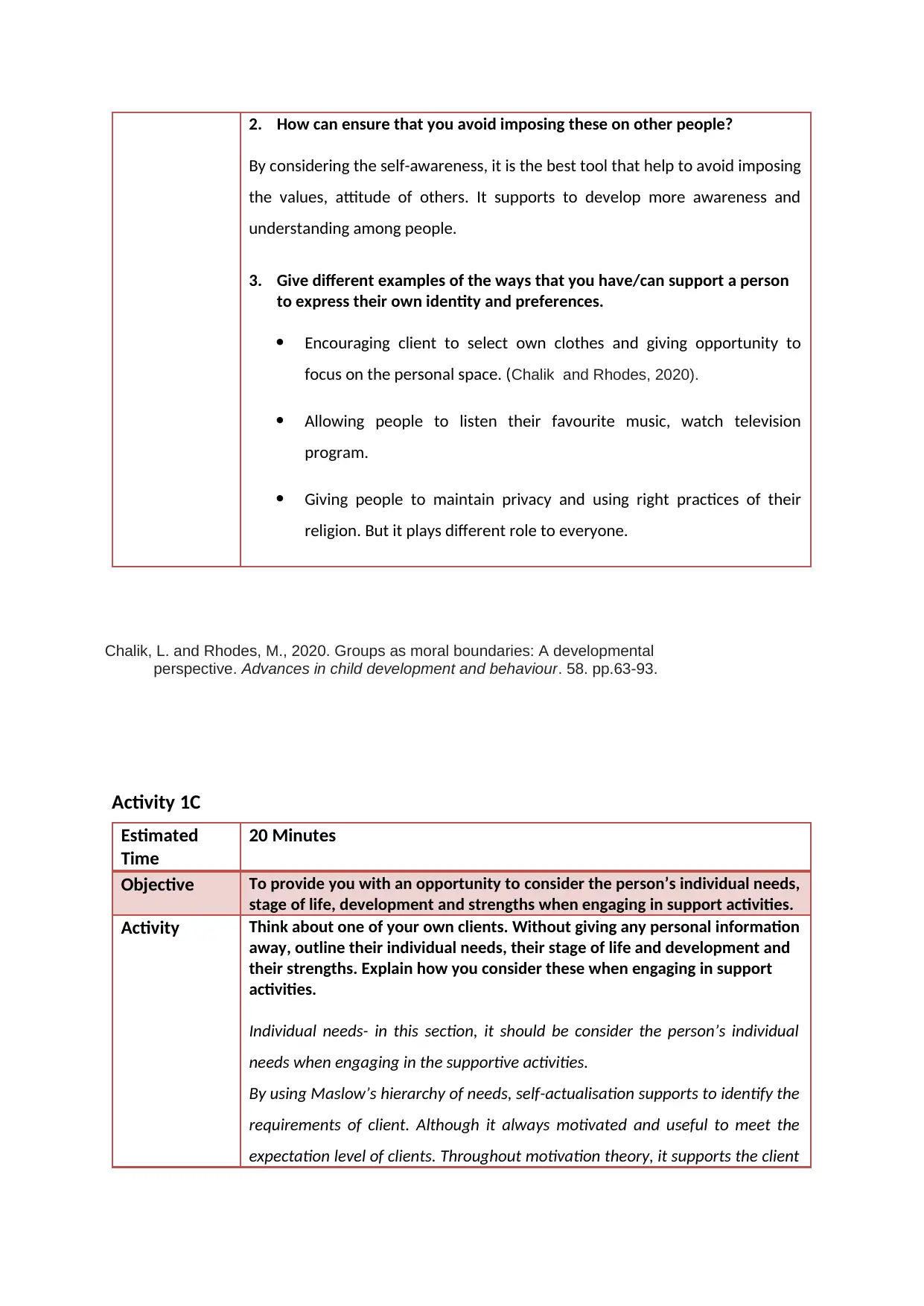
2. How can ensure that you avoid imposing these on other people?
By considering the self-awareness, it is the best tool that help to avoid imposing
the values, attitude of others. It supports to develop more awareness and
understanding among people.
3. Give different examples of the ways that you have/can support a person
to express their own identity and preferences.
Encouraging client to select own clothes and giving opportunity to
focus on the personal space. (Chalik and Rhodes, 2020).
Allowing people to listen their favourite music, watch television
program.
Giving people to maintain privacy and using right practices of their
religion. But it plays different role to everyone.
Chalik, L. and Rhodes, M., 2020. Groups as moral boundaries: A developmental
perspective. Advances in child development and behaviour. 58. pp.63-93.
Activity 1C
Estimated
Time
20 Minutes
Objective To provide you with an opportunity to consider the person’s individual needs,
stage of life, development and strengths when engaging in support activities.
Activity Think about one of your own clients. Without giving any personal information
away, outline their individual needs, their stage of life and development and
their strengths. Explain how you consider these when engaging in support
activities.
Individual needs- in this section, it should be consider the person’s individual
needs when engaging in the supportive activities.
By using Maslow’s hierarchy of needs, self-actualisation supports to identify the
requirements of client. Although it always motivated and useful to meet the
expectation level of clients. Throughout motivation theory, it supports the client
By considering the self-awareness, it is the best tool that help to avoid imposing
the values, attitude of others. It supports to develop more awareness and
understanding among people.
3. Give different examples of the ways that you have/can support a person
to express their own identity and preferences.
Encouraging client to select own clothes and giving opportunity to
focus on the personal space. (Chalik and Rhodes, 2020).
Allowing people to listen their favourite music, watch television
program.
Giving people to maintain privacy and using right practices of their
religion. But it plays different role to everyone.
Chalik, L. and Rhodes, M., 2020. Groups as moral boundaries: A developmental
perspective. Advances in child development and behaviour. 58. pp.63-93.
Activity 1C
Estimated
Time
20 Minutes
Objective To provide you with an opportunity to consider the person’s individual needs,
stage of life, development and strengths when engaging in support activities.
Activity Think about one of your own clients. Without giving any personal information
away, outline their individual needs, their stage of life and development and
their strengths. Explain how you consider these when engaging in support
activities.
Individual needs- in this section, it should be consider the person’s individual
needs when engaging in the supportive activities.
By using Maslow’s hierarchy of needs, self-actualisation supports to identify the
requirements of client. Although it always motivated and useful to meet the
expectation level of clients. Throughout motivation theory, it supports the client

and targeted the audience, fulfil all needs such as meals. It also helping to
follow a safety aspect and associated with health, well-being. On the other
hand, esteem needs associated with client and developing the positive feelings.
It also developing the confidence among people.
follow a safety aspect and associated with health, well-being. On the other
hand, esteem needs associated with client and developing the positive feelings.
It also developing the confidence among people.
Paraphrase This Document
Need a fresh take? Get an instant paraphrase of this document with our AI Paraphraser
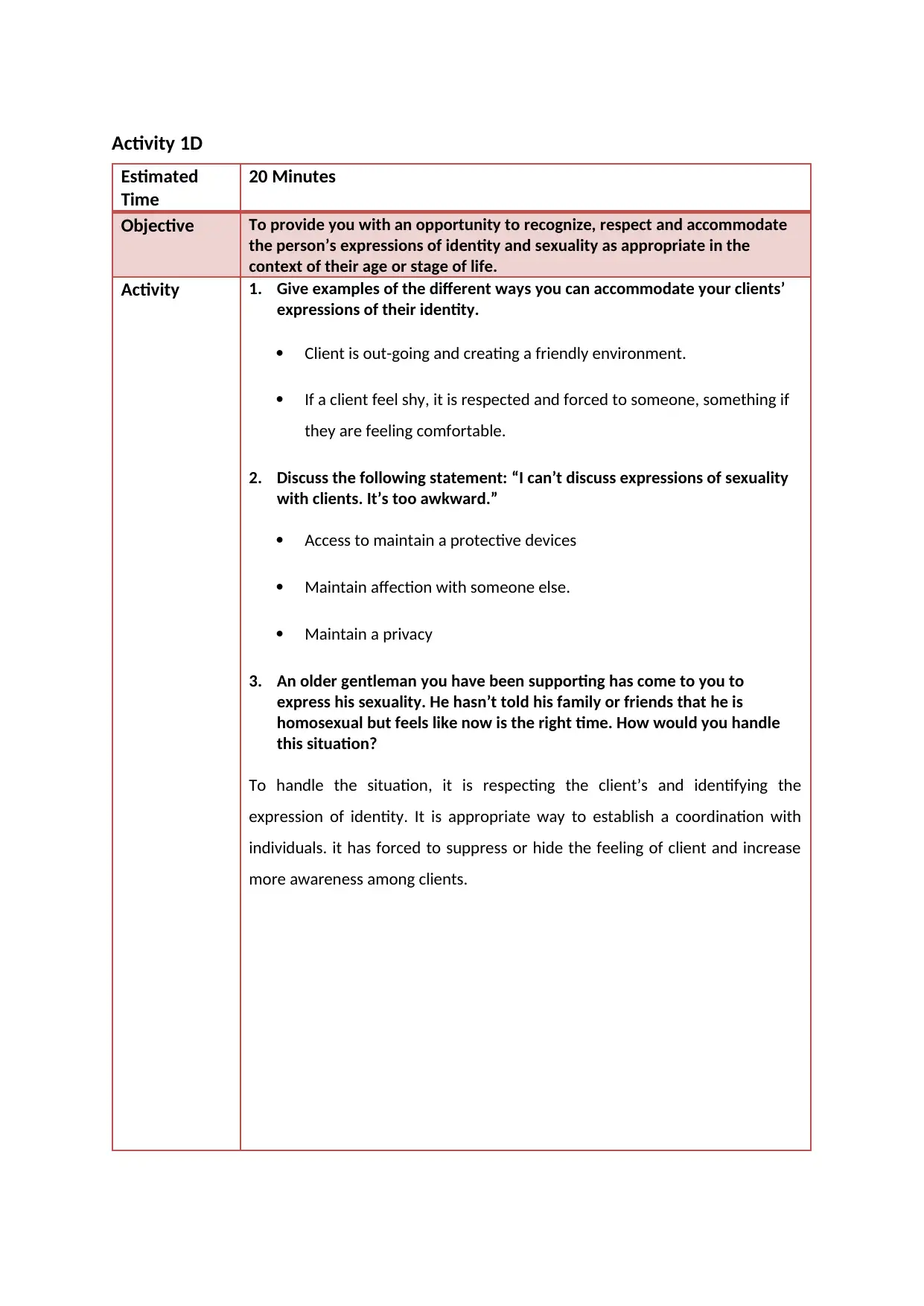
Activity 1D
Estimated
Time
20 Minutes
Objective To provide you with an opportunity to recognize, respect and accommodate
the person’s expressions of identity and sexuality as appropriate in the
context of their age or stage of life.
Activity 1. Give examples of the different ways you can accommodate your clients’
expressions of their identity.
Client is out-going and creating a friendly environment.
If a client feel shy, it is respected and forced to someone, something if
they are feeling comfortable.
2. Discuss the following statement: “I can’t discuss expressions of sexuality
with clients. It’s too awkward.”
Access to maintain a protective devices
Maintain affection with someone else.
Maintain a privacy
3. An older gentleman you have been supporting has come to you to
express his sexuality. He hasn’t told his family or friends that he is
homosexual but feels like now is the right time. How would you handle
this situation?
To handle the situation, it is respecting the client’s and identifying the
expression of identity. It is appropriate way to establish a coordination with
individuals. it has forced to suppress or hide the feeling of client and increase
more awareness among clients.
Estimated
Time
20 Minutes
Objective To provide you with an opportunity to recognize, respect and accommodate
the person’s expressions of identity and sexuality as appropriate in the
context of their age or stage of life.
Activity 1. Give examples of the different ways you can accommodate your clients’
expressions of their identity.
Client is out-going and creating a friendly environment.
If a client feel shy, it is respected and forced to someone, something if
they are feeling comfortable.
2. Discuss the following statement: “I can’t discuss expressions of sexuality
with clients. It’s too awkward.”
Access to maintain a protective devices
Maintain affection with someone else.
Maintain a privacy
3. An older gentleman you have been supporting has come to you to
express his sexuality. He hasn’t told his family or friends that he is
homosexual but feels like now is the right time. How would you handle
this situation?
To handle the situation, it is respecting the client’s and identifying the
expression of identity. It is appropriate way to establish a coordination with
individuals. it has forced to suppress or hide the feeling of client and increase
more awareness among clients.
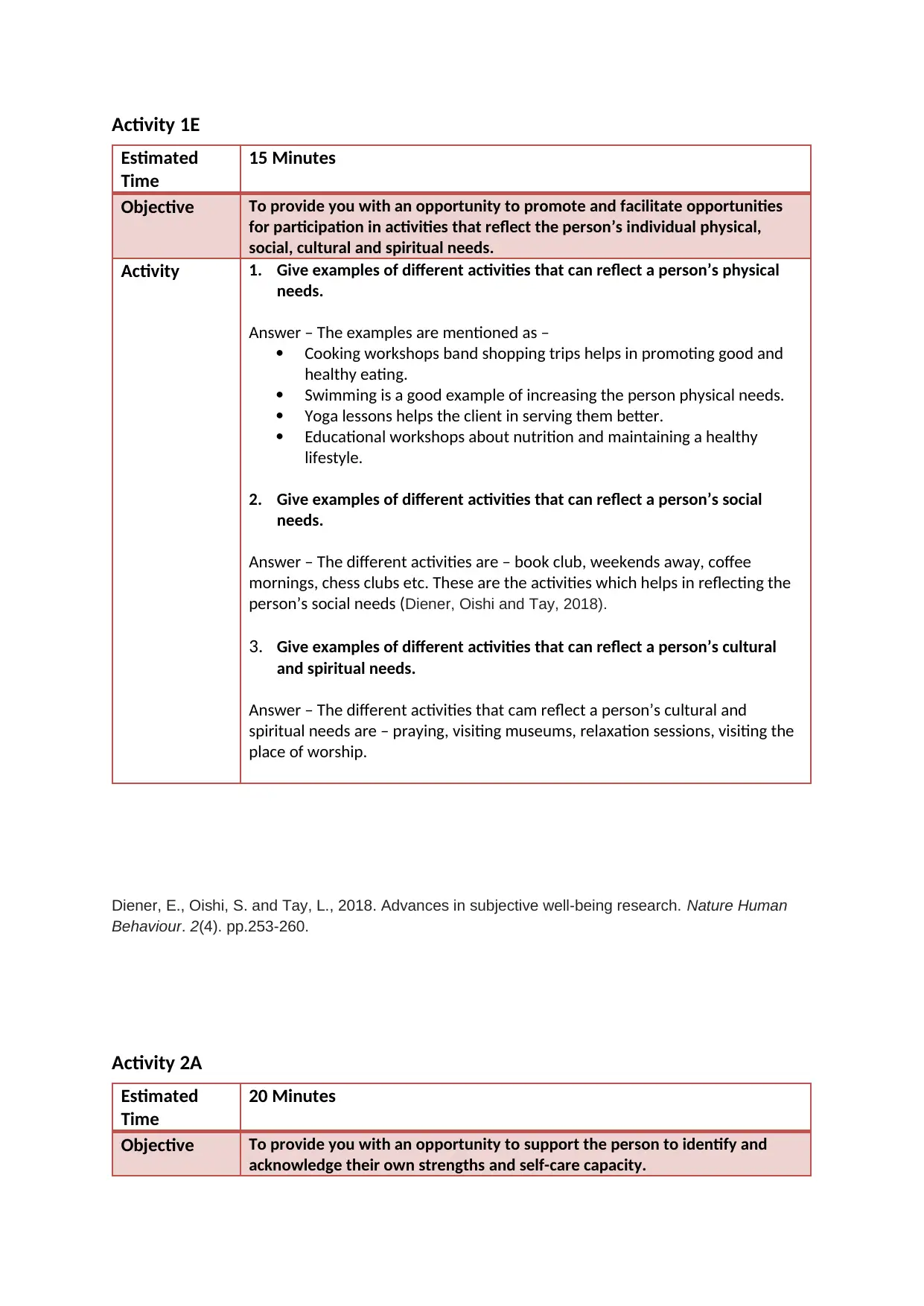
Activity 1E
Estimated
Time
15 Minutes
Objective To provide you with an opportunity to promote and facilitate opportunities
for participation in activities that reflect the person’s individual physical,
social, cultural and spiritual needs.
Activity 1. Give examples of different activities that can reflect a person’s physical
needs.
Answer – The examples are mentioned as –
Cooking workshops band shopping trips helps in promoting good and
healthy eating.
Swimming is a good example of increasing the person physical needs.
Yoga lessons helps the client in serving them better.
Educational workshops about nutrition and maintaining a healthy
lifestyle.
2. Give examples of different activities that can reflect a person’s social
needs.
Answer – The different activities are – book club, weekends away, coffee
mornings, chess clubs etc. These are the activities which helps in reflecting the
person’s social needs (Diener, Oishi and Tay, 2018).
3. Give examples of different activities that can reflect a person’s cultural
and spiritual needs.
Answer – The different activities that cam reflect a person’s cultural and
spiritual needs are – praying, visiting museums, relaxation sessions, visiting the
place of worship.
Diener, E., Oishi, S. and Tay, L., 2018. Advances in subjective well-being research. Nature Human
Behaviour. 2(4). pp.253-260.
Activity 2A
Estimated
Time
20 Minutes
Objective To provide you with an opportunity to support the person to identify and
acknowledge their own strengths and self-care capacity.
Estimated
Time
15 Minutes
Objective To provide you with an opportunity to promote and facilitate opportunities
for participation in activities that reflect the person’s individual physical,
social, cultural and spiritual needs.
Activity 1. Give examples of different activities that can reflect a person’s physical
needs.
Answer – The examples are mentioned as –
Cooking workshops band shopping trips helps in promoting good and
healthy eating.
Swimming is a good example of increasing the person physical needs.
Yoga lessons helps the client in serving them better.
Educational workshops about nutrition and maintaining a healthy
lifestyle.
2. Give examples of different activities that can reflect a person’s social
needs.
Answer – The different activities are – book club, weekends away, coffee
mornings, chess clubs etc. These are the activities which helps in reflecting the
person’s social needs (Diener, Oishi and Tay, 2018).
3. Give examples of different activities that can reflect a person’s cultural
and spiritual needs.
Answer – The different activities that cam reflect a person’s cultural and
spiritual needs are – praying, visiting museums, relaxation sessions, visiting the
place of worship.
Diener, E., Oishi, S. and Tay, L., 2018. Advances in subjective well-being research. Nature Human
Behaviour. 2(4). pp.253-260.
Activity 2A
Estimated
Time
20 Minutes
Objective To provide you with an opportunity to support the person to identify and
acknowledge their own strengths and self-care capacity.
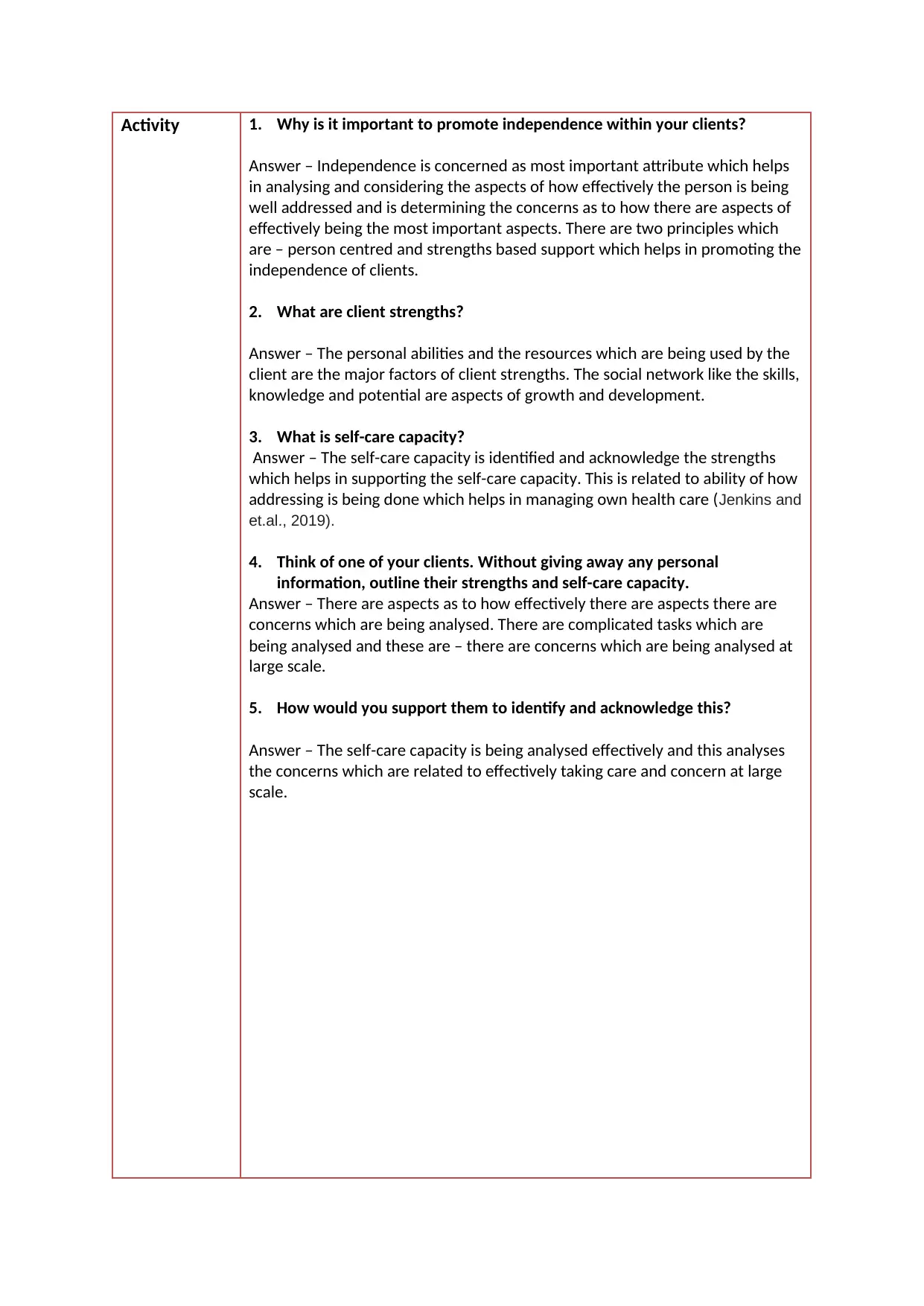
Activity 1. Why is it important to promote independence within your clients?
Answer – Independence is concerned as most important attribute which helps
in analysing and considering the aspects of how effectively the person is being
well addressed and is determining the concerns as to how there are aspects of
effectively being the most important aspects. There are two principles which
are – person centred and strengths based support which helps in promoting the
independence of clients.
2. What are client strengths?
Answer – The personal abilities and the resources which are being used by the
client are the major factors of client strengths. The social network like the skills,
knowledge and potential are aspects of growth and development.
3. What is self-care capacity?
Answer – The self-care capacity is identified and acknowledge the strengths
which helps in supporting the self-care capacity. This is related to ability of how
addressing is being done which helps in managing own health care (Jenkins and
et.al., 2019).
4. Think of one of your clients. Without giving away any personal
information, outline their strengths and self-care capacity.
Answer – There are aspects as to how effectively there are aspects there are
concerns which are being analysed. There are complicated tasks which are
being analysed and these are – there are concerns which are being analysed at
large scale.
5. How would you support them to identify and acknowledge this?
Answer – The self-care capacity is being analysed effectively and this analyses
the concerns which are related to effectively taking care and concern at large
scale.
Answer – Independence is concerned as most important attribute which helps
in analysing and considering the aspects of how effectively the person is being
well addressed and is determining the concerns as to how there are aspects of
effectively being the most important aspects. There are two principles which
are – person centred and strengths based support which helps in promoting the
independence of clients.
2. What are client strengths?
Answer – The personal abilities and the resources which are being used by the
client are the major factors of client strengths. The social network like the skills,
knowledge and potential are aspects of growth and development.
3. What is self-care capacity?
Answer – The self-care capacity is identified and acknowledge the strengths
which helps in supporting the self-care capacity. This is related to ability of how
addressing is being done which helps in managing own health care (Jenkins and
et.al., 2019).
4. Think of one of your clients. Without giving away any personal
information, outline their strengths and self-care capacity.
Answer – There are aspects as to how effectively there are aspects there are
concerns which are being analysed. There are complicated tasks which are
being analysed and these are – there are concerns which are being analysed at
large scale.
5. How would you support them to identify and acknowledge this?
Answer – The self-care capacity is being analysed effectively and this analyses
the concerns which are related to effectively taking care and concern at large
scale.
Secure Best Marks with AI Grader
Need help grading? Try our AI Grader for instant feedback on your assignments.
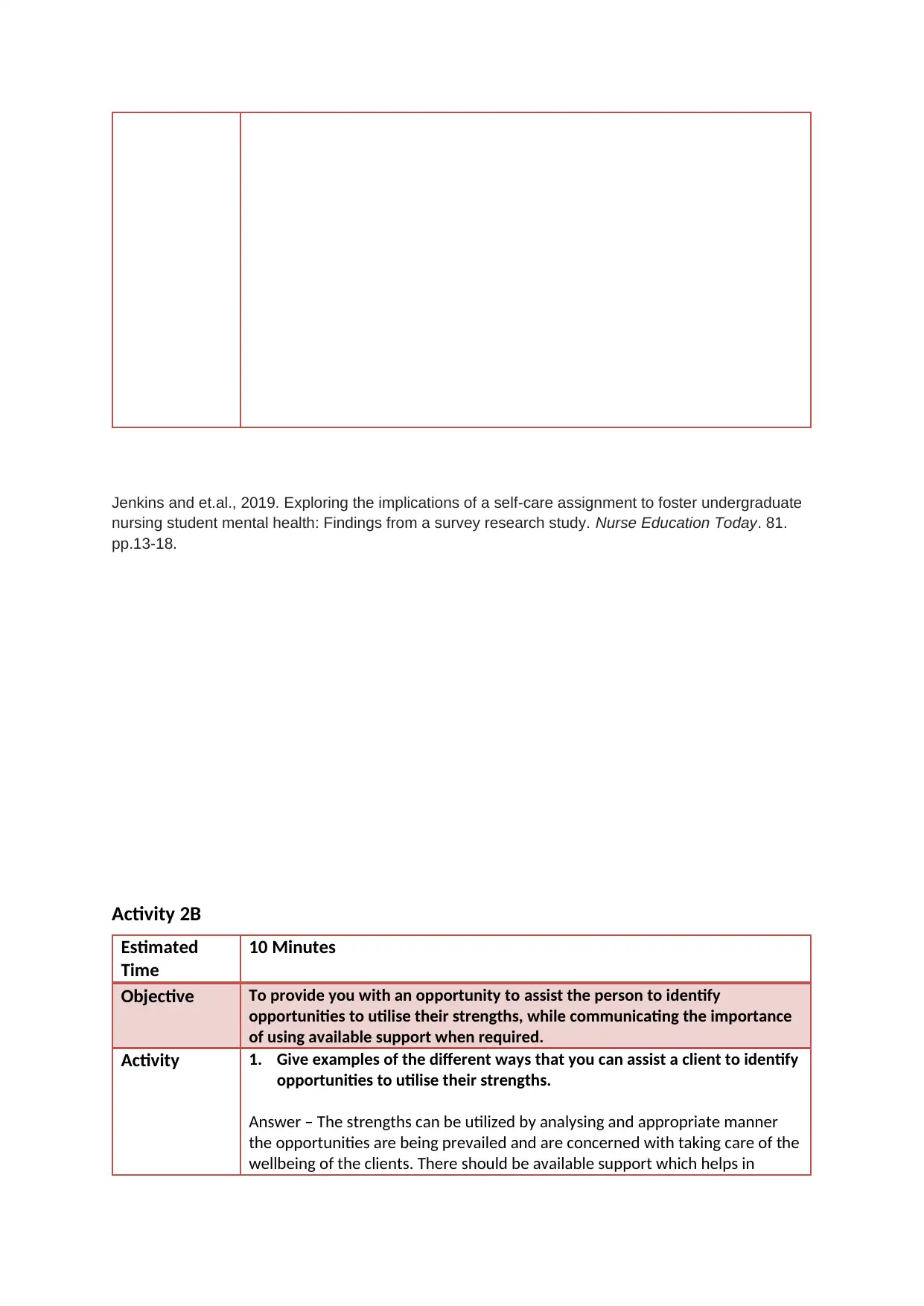
Jenkins and et.al., 2019. Exploring the implications of a self-care assignment to foster undergraduate
nursing student mental health: Findings from a survey research study. Nurse Education Today. 81.
pp.13-18.
Activity 2B
Estimated
Time
10 Minutes
Objective To provide you with an opportunity to assist the person to identify
opportunities to utilise their strengths, while communicating the importance
of using available support when required.
Activity 1. Give examples of the different ways that you can assist a client to identify
opportunities to utilise their strengths.
Answer – The strengths can be utilized by analysing and appropriate manner
the opportunities are being prevailed and are concerned with taking care of the
wellbeing of the clients. There should be available support which helps in
nursing student mental health: Findings from a survey research study. Nurse Education Today. 81.
pp.13-18.
Activity 2B
Estimated
Time
10 Minutes
Objective To provide you with an opportunity to assist the person to identify
opportunities to utilise their strengths, while communicating the importance
of using available support when required.
Activity 1. Give examples of the different ways that you can assist a client to identify
opportunities to utilise their strengths.
Answer – The strengths can be utilized by analysing and appropriate manner
the opportunities are being prevailed and are concerned with taking care of the
wellbeing of the clients. There should be available support which helps in
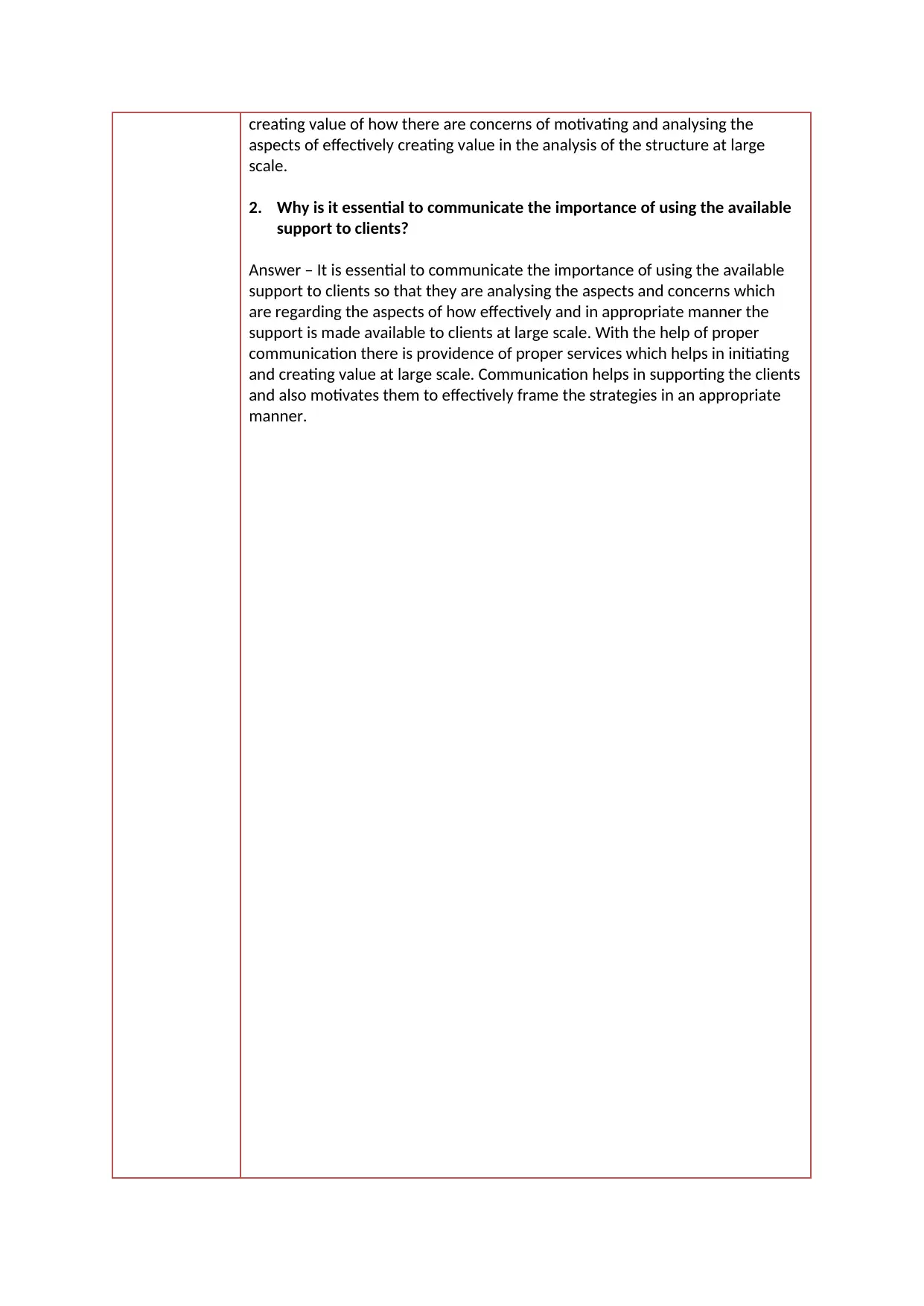
creating value of how there are concerns of motivating and analysing the
aspects of effectively creating value in the analysis of the structure at large
scale.
2. Why is it essential to communicate the importance of using the available
support to clients?
Answer – It is essential to communicate the importance of using the available
support to clients so that they are analysing the aspects and concerns which
are regarding the aspects of how effectively and in appropriate manner the
support is made available to clients at large scale. With the help of proper
communication there is providence of proper services which helps in initiating
and creating value at large scale. Communication helps in supporting the clients
and also motivates them to effectively frame the strategies in an appropriate
manner.
aspects of effectively creating value in the analysis of the structure at large
scale.
2. Why is it essential to communicate the importance of using the available
support to clients?
Answer – It is essential to communicate the importance of using the available
support to clients so that they are analysing the aspects and concerns which
are regarding the aspects of how effectively and in appropriate manner the
support is made available to clients at large scale. With the help of proper
communication there is providence of proper services which helps in initiating
and creating value at large scale. Communication helps in supporting the clients
and also motivates them to effectively frame the strategies in an appropriate
manner.
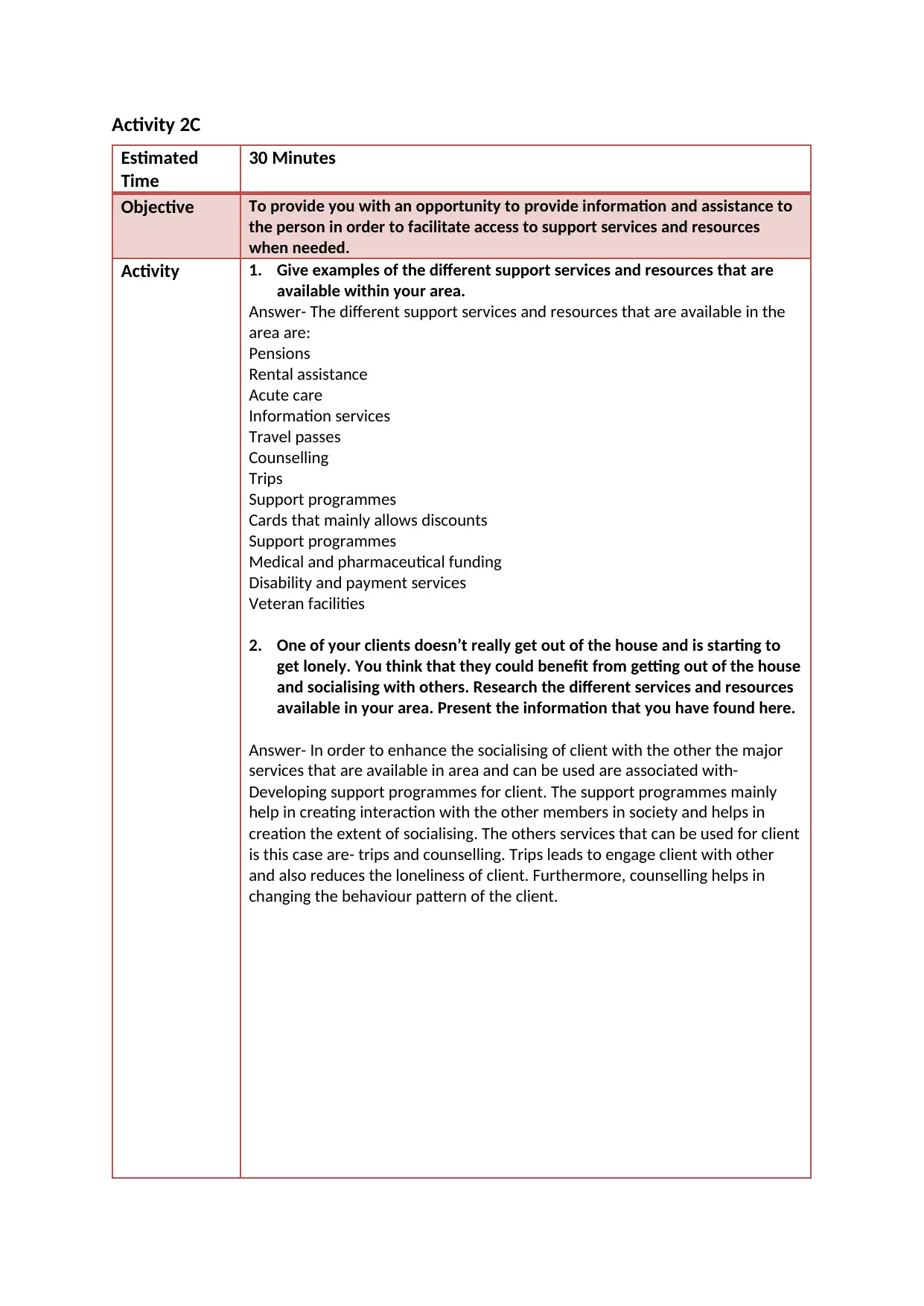
Activity 2C
Estimated
Time
30 Minutes
Objective To provide you with an opportunity to provide information and assistance to
the person in order to facilitate access to support services and resources
when needed.
Activity 1. Give examples of the different support services and resources that are
available within your area.
Answer- The different support services and resources that are available in the
area are:
Pensions
Rental assistance
Acute care
Information services
Travel passes
Counselling
Trips
Support programmes
Cards that mainly allows discounts
Support programmes
Medical and pharmaceutical funding
Disability and payment services
Veteran facilities
2. One of your clients doesn’t really get out of the house and is starting to
get lonely. You think that they could benefit from getting out of the house
and socialising with others. Research the different services and resources
available in your area. Present the information that you have found here.
Answer- In order to enhance the socialising of client with the other the major
services that are available in area and can be used are associated with-
Developing support programmes for client. The support programmes mainly
help in creating interaction with the other members in society and helps in
creation the extent of socialising. The others services that can be used for client
is this case are- trips and counselling. Trips leads to engage client with other
and also reduces the loneliness of client. Furthermore, counselling helps in
changing the behaviour pattern of the client.
Estimated
Time
30 Minutes
Objective To provide you with an opportunity to provide information and assistance to
the person in order to facilitate access to support services and resources
when needed.
Activity 1. Give examples of the different support services and resources that are
available within your area.
Answer- The different support services and resources that are available in the
area are:
Pensions
Rental assistance
Acute care
Information services
Travel passes
Counselling
Trips
Support programmes
Cards that mainly allows discounts
Support programmes
Medical and pharmaceutical funding
Disability and payment services
Veteran facilities
2. One of your clients doesn’t really get out of the house and is starting to
get lonely. You think that they could benefit from getting out of the house
and socialising with others. Research the different services and resources
available in your area. Present the information that you have found here.
Answer- In order to enhance the socialising of client with the other the major
services that are available in area and can be used are associated with-
Developing support programmes for client. The support programmes mainly
help in creating interaction with the other members in society and helps in
creation the extent of socialising. The others services that can be used for client
is this case are- trips and counselling. Trips leads to engage client with other
and also reduces the loneliness of client. Furthermore, counselling helps in
changing the behaviour pattern of the client.
Paraphrase This Document
Need a fresh take? Get an instant paraphrase of this document with our AI Paraphraser
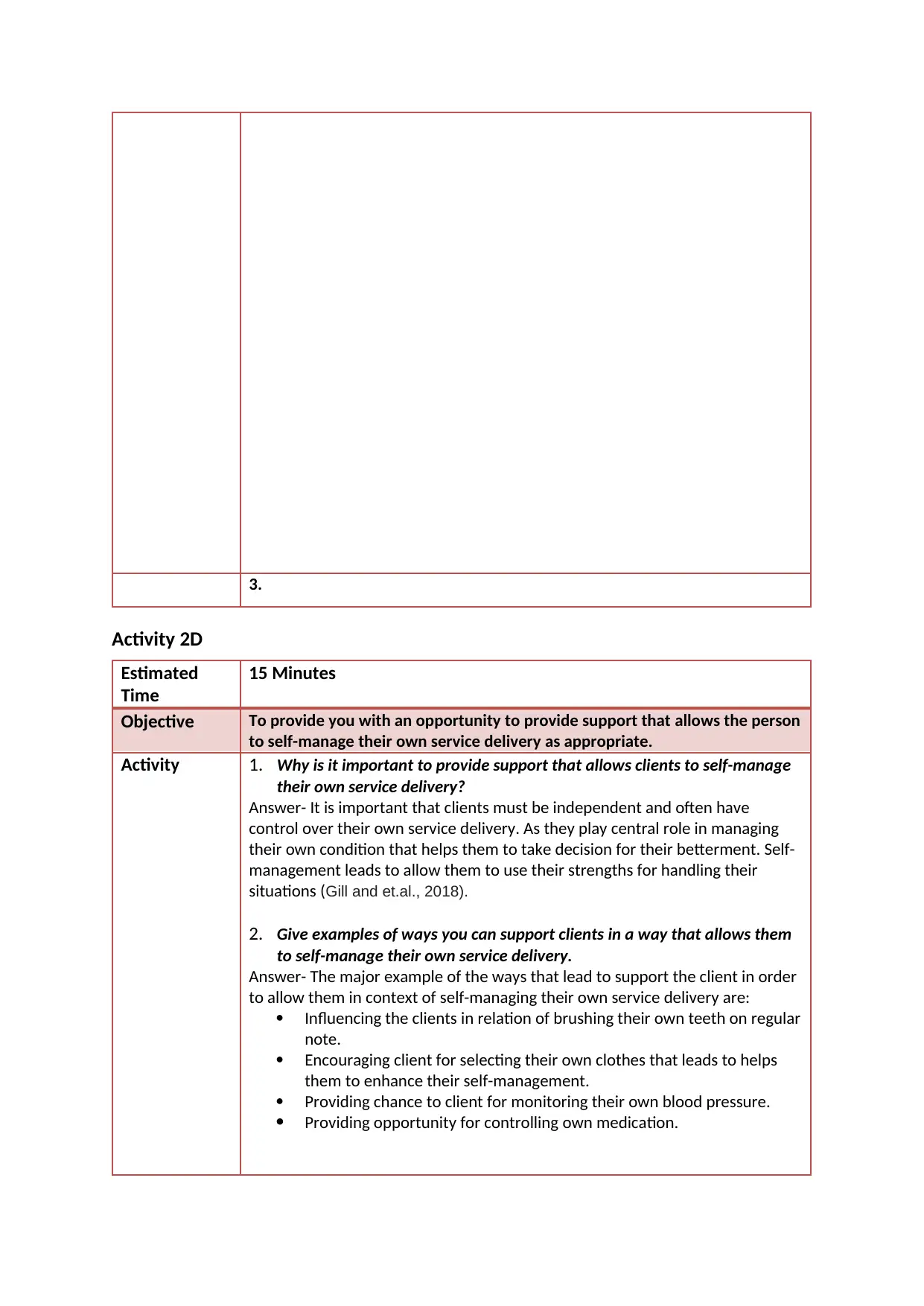
3.
Activity 2D
Estimated
Time
15 Minutes
Objective To provide you with an opportunity to provide support that allows the person
to self-manage their own service delivery as appropriate.
Activity 1. Why is it important to provide support that allows clients to self-manage
their own service delivery?
Answer- It is important that clients must be independent and often have
control over their own service delivery. As they play central role in managing
their own condition that helps them to take decision for their betterment. Self-
management leads to allow them to use their strengths for handling their
situations (Gill and et.al., 2018).
2. Give examples of ways you can support clients in a way that allows them
to self-manage their own service delivery.
Answer- The major example of the ways that lead to support the client in order
to allow them in context of self-managing their own service delivery are:
Influencing the clients in relation of brushing their own teeth on regular
note.
Encouraging client for selecting their own clothes that leads to helps
them to enhance their self-management.
Providing chance to client for monitoring their own blood pressure.
Providing opportunity for controlling own medication.
Activity 2D
Estimated
Time
15 Minutes
Objective To provide you with an opportunity to provide support that allows the person
to self-manage their own service delivery as appropriate.
Activity 1. Why is it important to provide support that allows clients to self-manage
their own service delivery?
Answer- It is important that clients must be independent and often have
control over their own service delivery. As they play central role in managing
their own condition that helps them to take decision for their betterment. Self-
management leads to allow them to use their strengths for handling their
situations (Gill and et.al., 2018).
2. Give examples of ways you can support clients in a way that allows them
to self-manage their own service delivery.
Answer- The major example of the ways that lead to support the client in order
to allow them in context of self-managing their own service delivery are:
Influencing the clients in relation of brushing their own teeth on regular
note.
Encouraging client for selecting their own clothes that leads to helps
them to enhance their self-management.
Providing chance to client for monitoring their own blood pressure.
Providing opportunity for controlling own medication.
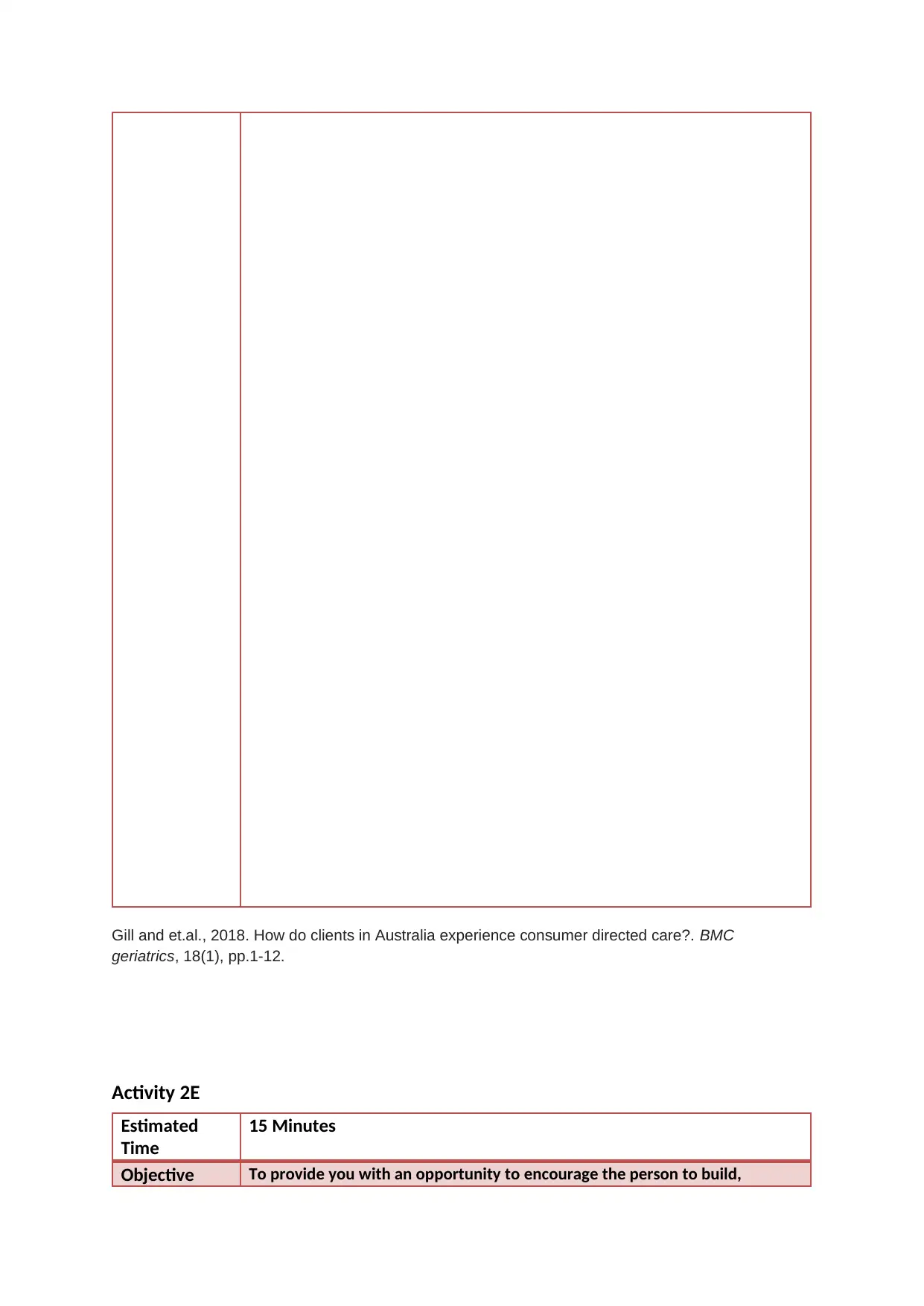
Gill and et.al., 2018. How do clients in Australia experience consumer directed care?. BMC
geriatrics, 18(1), pp.1-12.
Activity 2E
Estimated
Time
15 Minutes
Objective To provide you with an opportunity to encourage the person to build,
geriatrics, 18(1), pp.1-12.
Activity 2E
Estimated
Time
15 Minutes
Objective To provide you with an opportunity to encourage the person to build,
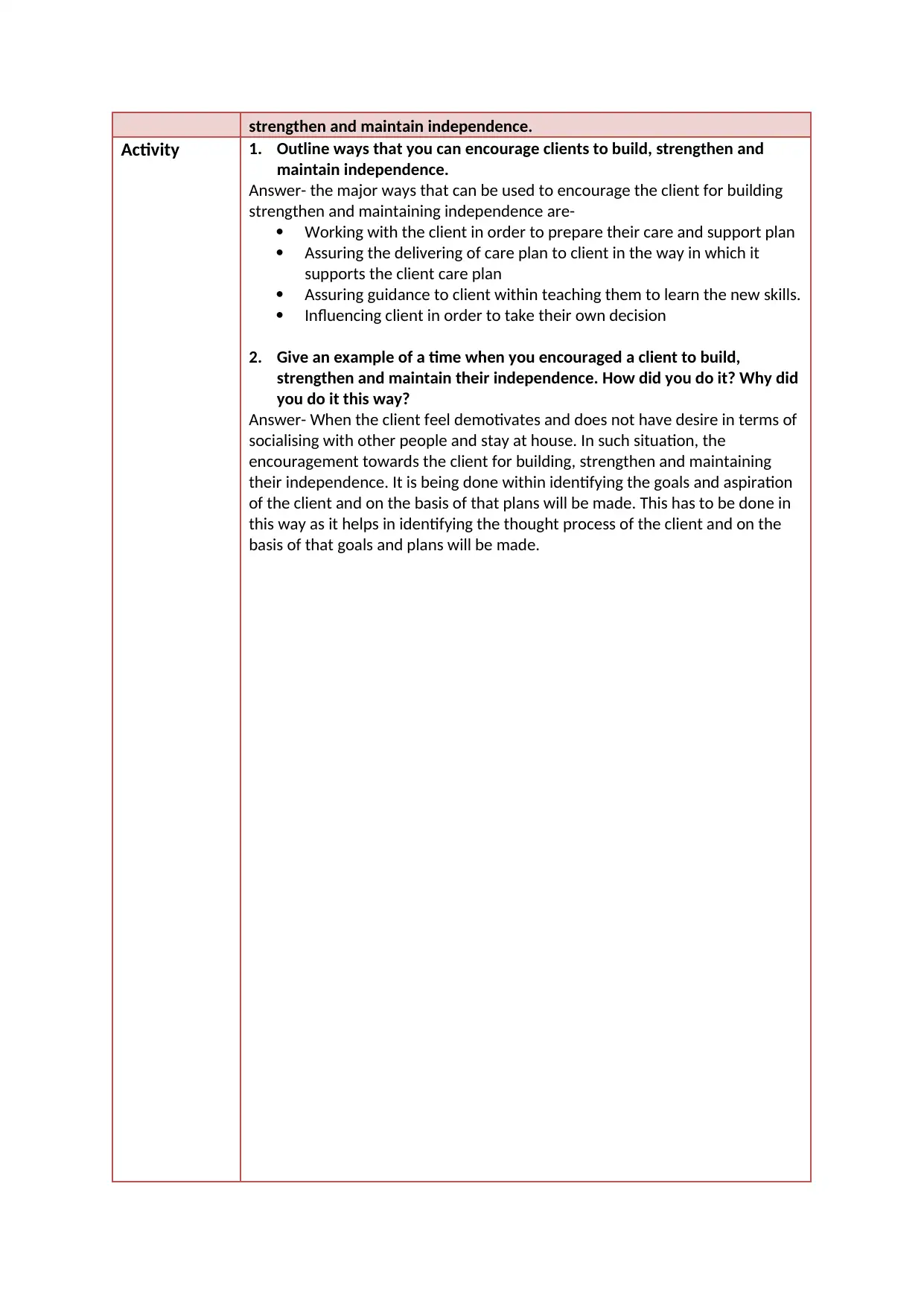
strengthen and maintain independence.
Activity 1. Outline ways that you can encourage clients to build, strengthen and
maintain independence.
Answer- the major ways that can be used to encourage the client for building
strengthen and maintaining independence are-
Working with the client in order to prepare their care and support plan
Assuring the delivering of care plan to client in the way in which it
supports the client care plan
Assuring guidance to client within teaching them to learn the new skills.
Influencing client in order to take their own decision
2. Give an example of a time when you encouraged a client to build,
strengthen and maintain their independence. How did you do it? Why did
you do it this way?
Answer- When the client feel demotivates and does not have desire in terms of
socialising with other people and stay at house. In such situation, the
encouragement towards the client for building, strengthen and maintaining
their independence. It is being done within identifying the goals and aspiration
of the client and on the basis of that plans will be made. This has to be done in
this way as it helps in identifying the thought process of the client and on the
basis of that goals and plans will be made.
Activity 1. Outline ways that you can encourage clients to build, strengthen and
maintain independence.
Answer- the major ways that can be used to encourage the client for building
strengthen and maintaining independence are-
Working with the client in order to prepare their care and support plan
Assuring the delivering of care plan to client in the way in which it
supports the client care plan
Assuring guidance to client within teaching them to learn the new skills.
Influencing client in order to take their own decision
2. Give an example of a time when you encouraged a client to build,
strengthen and maintain their independence. How did you do it? Why did
you do it this way?
Answer- When the client feel demotivates and does not have desire in terms of
socialising with other people and stay at house. In such situation, the
encouragement towards the client for building, strengthen and maintaining
their independence. It is being done within identifying the goals and aspiration
of the client and on the basis of that plans will be made. This has to be done in
this way as it helps in identifying the thought process of the client and on the
basis of that goals and plans will be made.
Secure Best Marks with AI Grader
Need help grading? Try our AI Grader for instant feedback on your assignments.
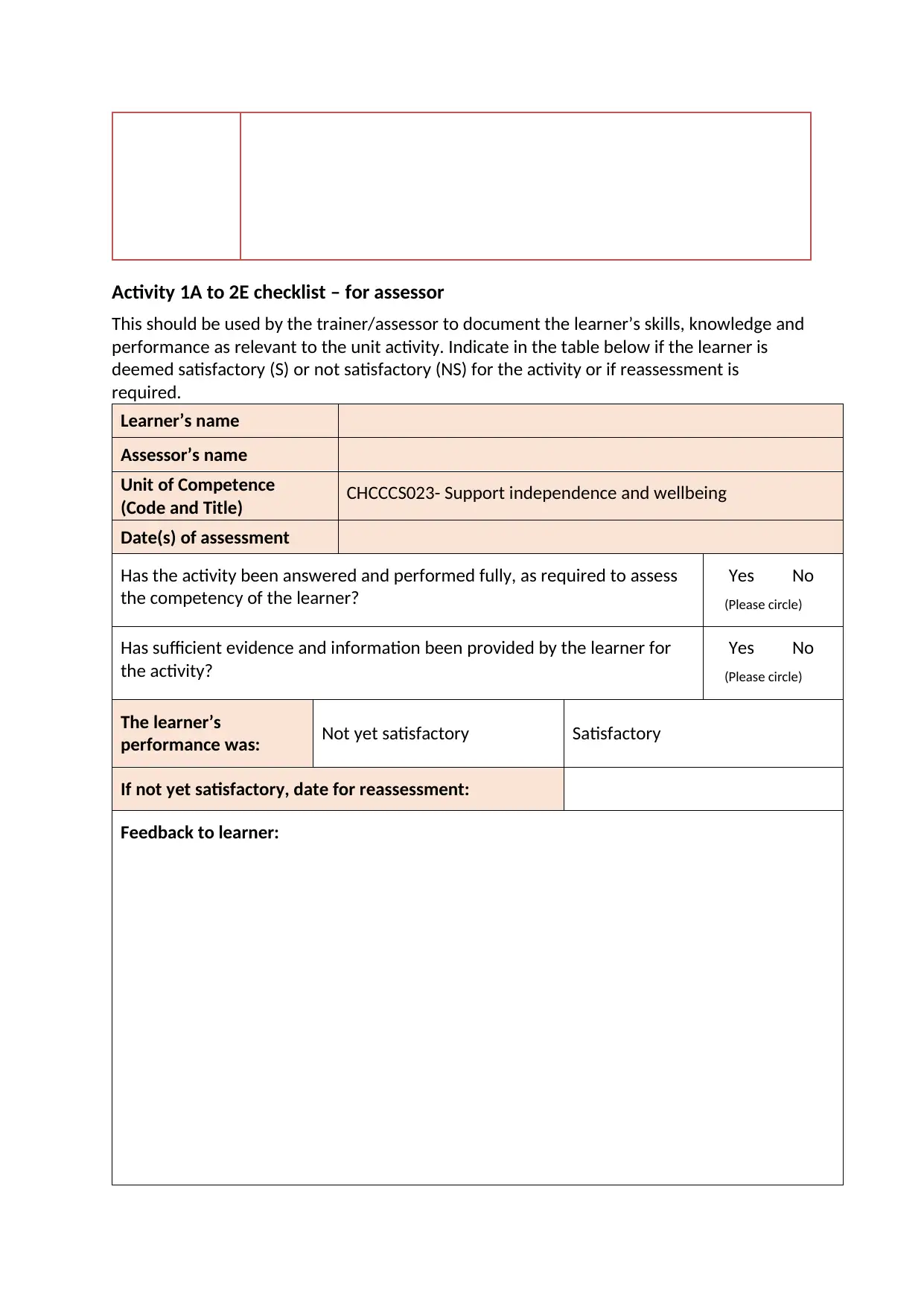
Activity 1A to 2E checklist – for assessor
This should be used by the trainer/assessor to document the learner’s skills, knowledge and
performance as relevant to the unit activity. Indicate in the table below if the learner is
deemed satisfactory (S) or not satisfactory (NS) for the activity or if reassessment is
required.
Learner’s name
Assessor’s name
Unit of Competence
(Code and Title) CHCCCS023- Support independence and wellbeing
Date(s) of assessment
Has the activity been answered and performed fully, as required to assess
the competency of the learner?
Yes No
(Please circle)
Has sufficient evidence and information been provided by the learner for
the activity?
Yes No
(Please circle)
The learner’s
performance was: Not yet satisfactory Satisfactory
If not yet satisfactory, date for reassessment:
Feedback to learner:
This should be used by the trainer/assessor to document the learner’s skills, knowledge and
performance as relevant to the unit activity. Indicate in the table below if the learner is
deemed satisfactory (S) or not satisfactory (NS) for the activity or if reassessment is
required.
Learner’s name
Assessor’s name
Unit of Competence
(Code and Title) CHCCCS023- Support independence and wellbeing
Date(s) of assessment
Has the activity been answered and performed fully, as required to assess
the competency of the learner?
Yes No
(Please circle)
Has sufficient evidence and information been provided by the learner for
the activity?
Yes No
(Please circle)
The learner’s
performance was: Not yet satisfactory Satisfactory
If not yet satisfactory, date for reassessment:
Feedback to learner:
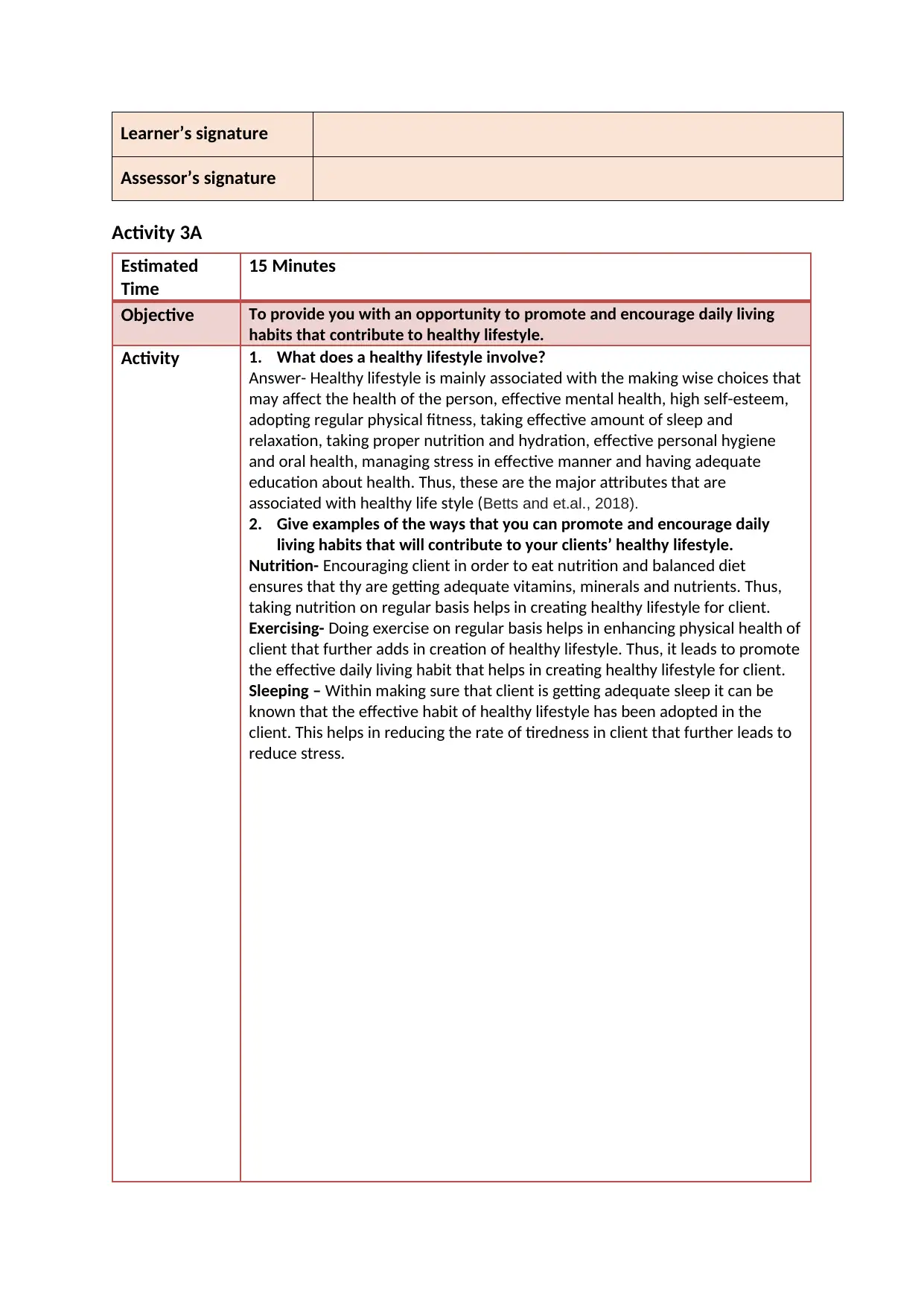
Learner’s signature
Assessor’s signature
Activity 3A
Estimated
Time
15 Minutes
Objective To provide you with an opportunity to promote and encourage daily living
habits that contribute to healthy lifestyle.
Activity 1. What does a healthy lifestyle involve?
Answer- Healthy lifestyle is mainly associated with the making wise choices that
may affect the health of the person, effective mental health, high self-esteem,
adopting regular physical fitness, taking effective amount of sleep and
relaxation, taking proper nutrition and hydration, effective personal hygiene
and oral health, managing stress in effective manner and having adequate
education about health. Thus, these are the major attributes that are
associated with healthy life style (Betts and et.al., 2018).
2. Give examples of the ways that you can promote and encourage daily
living habits that will contribute to your clients’ healthy lifestyle.
Nutrition- Encouraging client in order to eat nutrition and balanced diet
ensures that thy are getting adequate vitamins, minerals and nutrients. Thus,
taking nutrition on regular basis helps in creating healthy lifestyle for client.
Exercising- Doing exercise on regular basis helps in enhancing physical health of
client that further adds in creation of healthy lifestyle. Thus, it leads to promote
the effective daily living habit that helps in creating healthy lifestyle for client.
Sleeping – Within making sure that client is getting adequate sleep it can be
known that the effective habit of healthy lifestyle has been adopted in the
client. This helps in reducing the rate of tiredness in client that further leads to
reduce stress.
Assessor’s signature
Activity 3A
Estimated
Time
15 Minutes
Objective To provide you with an opportunity to promote and encourage daily living
habits that contribute to healthy lifestyle.
Activity 1. What does a healthy lifestyle involve?
Answer- Healthy lifestyle is mainly associated with the making wise choices that
may affect the health of the person, effective mental health, high self-esteem,
adopting regular physical fitness, taking effective amount of sleep and
relaxation, taking proper nutrition and hydration, effective personal hygiene
and oral health, managing stress in effective manner and having adequate
education about health. Thus, these are the major attributes that are
associated with healthy life style (Betts and et.al., 2018).
2. Give examples of the ways that you can promote and encourage daily
living habits that will contribute to your clients’ healthy lifestyle.
Nutrition- Encouraging client in order to eat nutrition and balanced diet
ensures that thy are getting adequate vitamins, minerals and nutrients. Thus,
taking nutrition on regular basis helps in creating healthy lifestyle for client.
Exercising- Doing exercise on regular basis helps in enhancing physical health of
client that further adds in creation of healthy lifestyle. Thus, it leads to promote
the effective daily living habit that helps in creating healthy lifestyle for client.
Sleeping – Within making sure that client is getting adequate sleep it can be
known that the effective habit of healthy lifestyle has been adopted in the
client. This helps in reducing the rate of tiredness in client that further leads to
reduce stress.
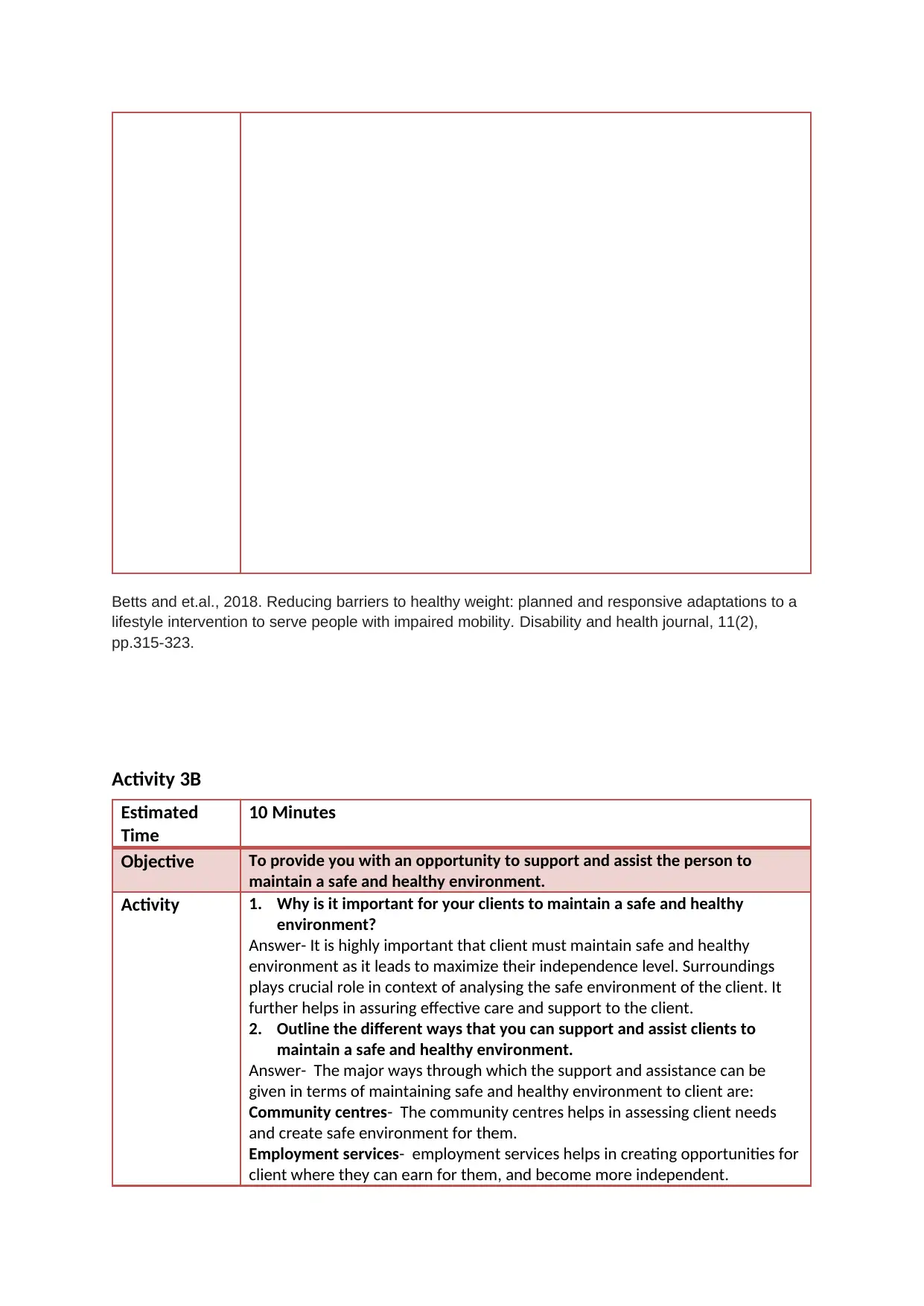
Betts and et.al., 2018. Reducing barriers to healthy weight: planned and responsive adaptations to a
lifestyle intervention to serve people with impaired mobility. Disability and health journal, 11(2),
pp.315-323.
Activity 3B
Estimated
Time
10 Minutes
Objective To provide you with an opportunity to support and assist the person to
maintain a safe and healthy environment.
Activity 1. Why is it important for your clients to maintain a safe and healthy
environment?
Answer- It is highly important that client must maintain safe and healthy
environment as it leads to maximize their independence level. Surroundings
plays crucial role in context of analysing the safe environment of the client. It
further helps in assuring effective care and support to the client.
2. Outline the different ways that you can support and assist clients to
maintain a safe and healthy environment.
Answer- The major ways through which the support and assistance can be
given in terms of maintaining safe and healthy environment to client are:
Community centres- The community centres helps in assessing client needs
and create safe environment for them.
Employment services- employment services helps in creating opportunities for
client where they can earn for them, and become more independent.
lifestyle intervention to serve people with impaired mobility. Disability and health journal, 11(2),
pp.315-323.
Activity 3B
Estimated
Time
10 Minutes
Objective To provide you with an opportunity to support and assist the person to
maintain a safe and healthy environment.
Activity 1. Why is it important for your clients to maintain a safe and healthy
environment?
Answer- It is highly important that client must maintain safe and healthy
environment as it leads to maximize their independence level. Surroundings
plays crucial role in context of analysing the safe environment of the client. It
further helps in assuring effective care and support to the client.
2. Outline the different ways that you can support and assist clients to
maintain a safe and healthy environment.
Answer- The major ways through which the support and assistance can be
given in terms of maintaining safe and healthy environment to client are:
Community centres- The community centres helps in assessing client needs
and create safe environment for them.
Employment services- employment services helps in creating opportunities for
client where they can earn for them, and become more independent.
Paraphrase This Document
Need a fresh take? Get an instant paraphrase of this document with our AI Paraphraser
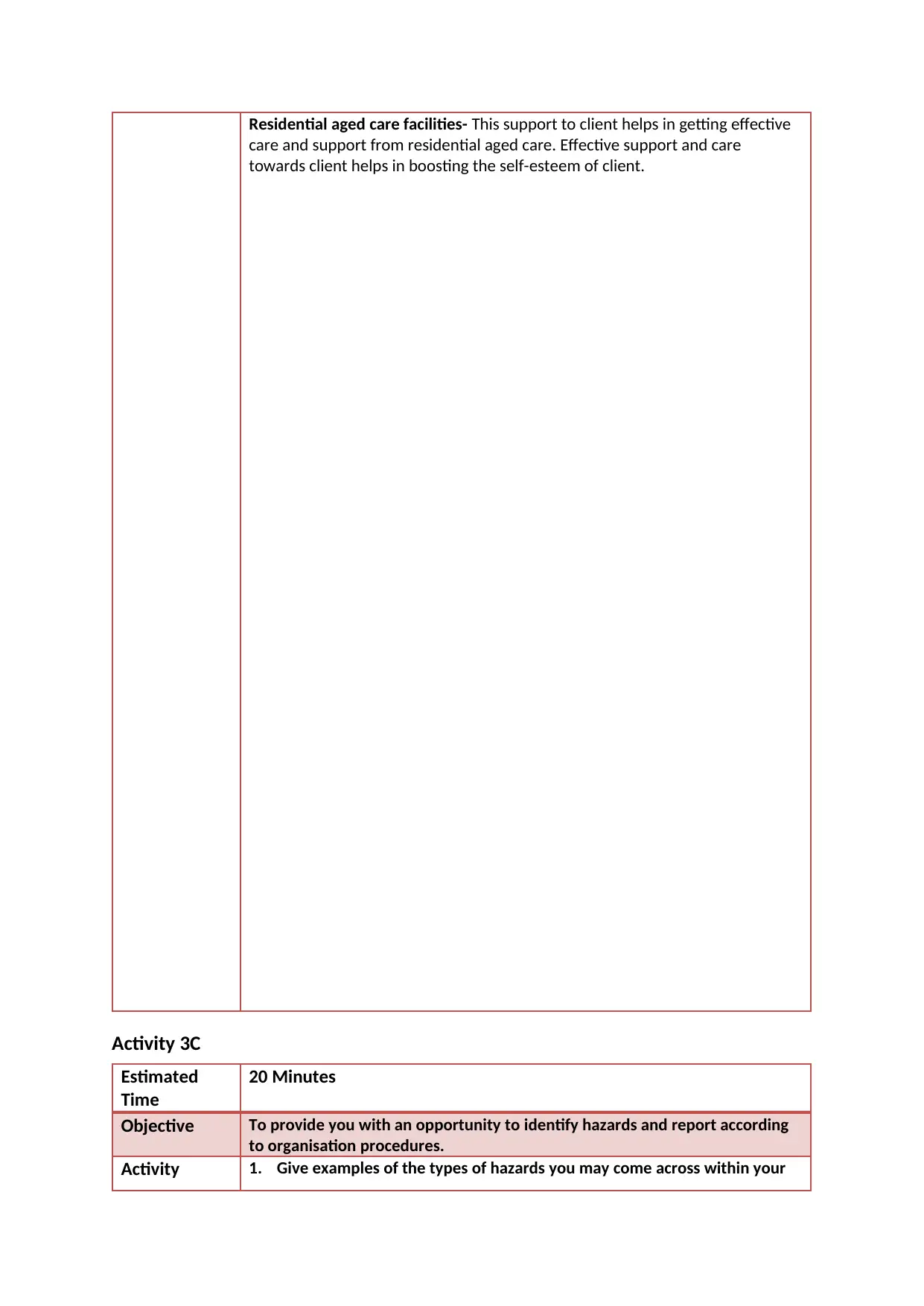
Residential aged care facilities- This support to client helps in getting effective
care and support from residential aged care. Effective support and care
towards client helps in boosting the self-esteem of client.
Activity 3C
Estimated
Time
20 Minutes
Objective To provide you with an opportunity to identify hazards and report according
to organisation procedures.
Activity 1. Give examples of the types of hazards you may come across within your
care and support from residential aged care. Effective support and care
towards client helps in boosting the self-esteem of client.
Activity 3C
Estimated
Time
20 Minutes
Objective To provide you with an opportunity to identify hazards and report according
to organisation procedures.
Activity 1. Give examples of the types of hazards you may come across within your
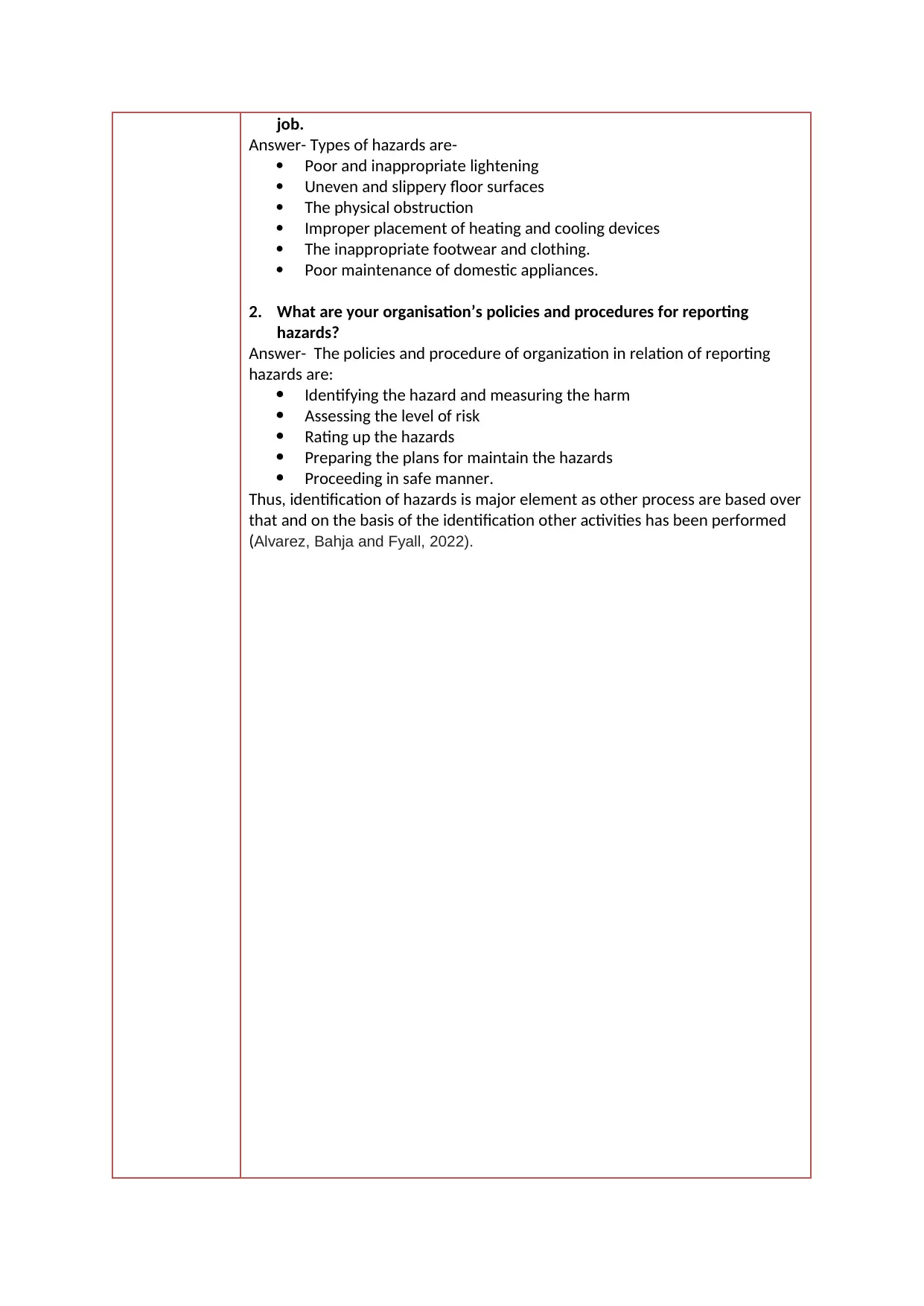
job.
Answer- Types of hazards are-
Poor and inappropriate lightening
Uneven and slippery floor surfaces
The physical obstruction
Improper placement of heating and cooling devices
The inappropriate footwear and clothing.
Poor maintenance of domestic appliances.
2. What are your organisation’s policies and procedures for reporting
hazards?
Answer- The policies and procedure of organization in relation of reporting
hazards are:
Identifying the hazard and measuring the harm
Assessing the level of risk
Rating up the hazards
Preparing the plans for maintain the hazards
Proceeding in safe manner.
Thus, identification of hazards is major element as other process are based over
that and on the basis of the identification other activities has been performed
(Alvarez, Bahja and Fyall, 2022).
Answer- Types of hazards are-
Poor and inappropriate lightening
Uneven and slippery floor surfaces
The physical obstruction
Improper placement of heating and cooling devices
The inappropriate footwear and clothing.
Poor maintenance of domestic appliances.
2. What are your organisation’s policies and procedures for reporting
hazards?
Answer- The policies and procedure of organization in relation of reporting
hazards are:
Identifying the hazard and measuring the harm
Assessing the level of risk
Rating up the hazards
Preparing the plans for maintain the hazards
Proceeding in safe manner.
Thus, identification of hazards is major element as other process are based over
that and on the basis of the identification other activities has been performed
(Alvarez, Bahja and Fyall, 2022).
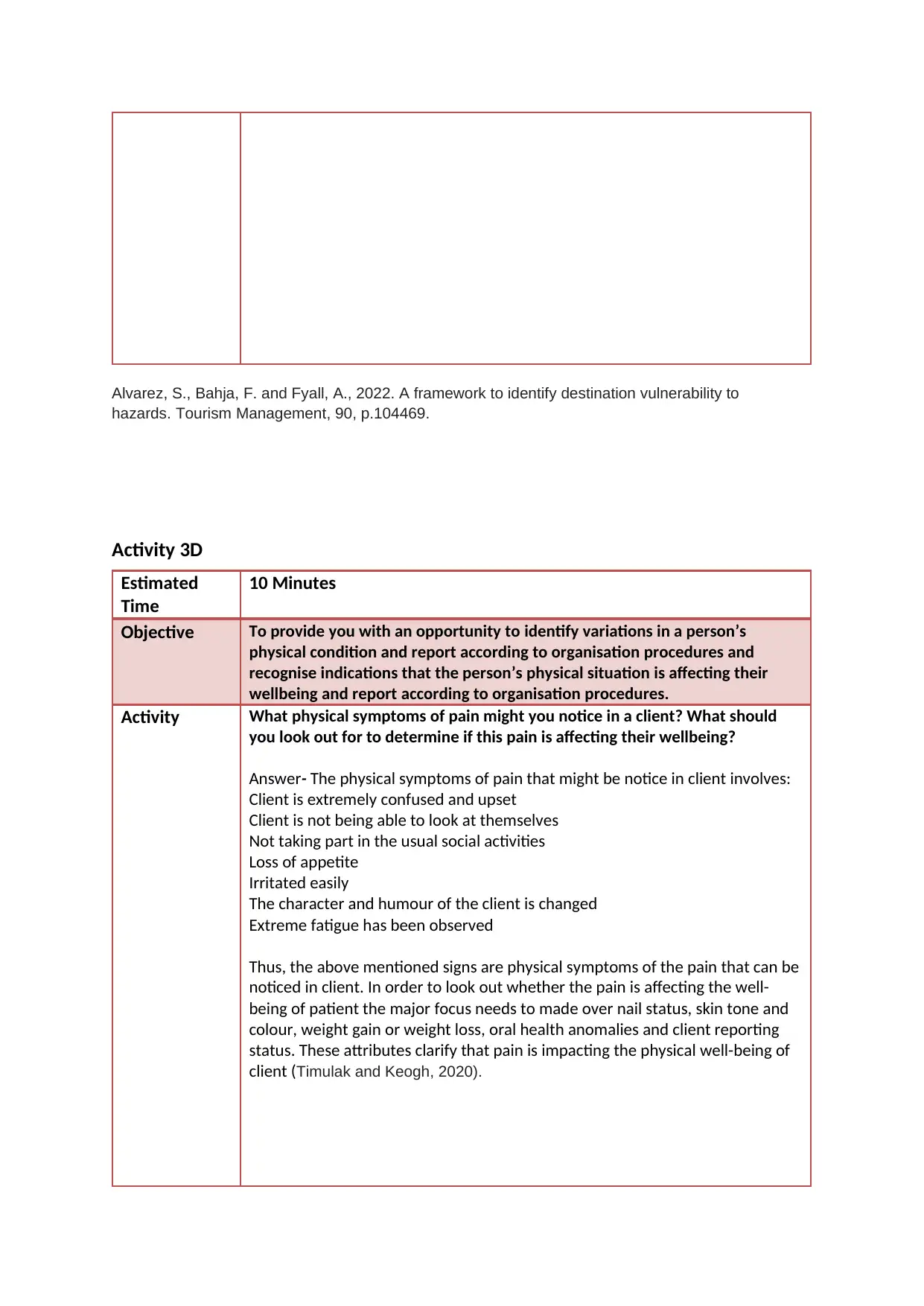
Alvarez, S., Bahja, F. and Fyall, A., 2022. A framework to identify destination vulnerability to
hazards. Tourism Management, 90, p.104469.
Activity 3D
Estimated
Time
10 Minutes
Objective To provide you with an opportunity to identify variations in a person’s
physical condition and report according to organisation procedures and
recognise indications that the person’s physical situation is affecting their
wellbeing and report according to organisation procedures.
Activity What physical symptoms of pain might you notice in a client? What should
you look out for to determine if this pain is affecting their wellbeing?
Answer- The physical symptoms of pain that might be notice in client involves:
Client is extremely confused and upset
Client is not being able to look at themselves
Not taking part in the usual social activities
Loss of appetite
Irritated easily
The character and humour of the client is changed
Extreme fatigue has been observed
Thus, the above mentioned signs are physical symptoms of the pain that can be
noticed in client. In order to look out whether the pain is affecting the well-
being of patient the major focus needs to made over nail status, skin tone and
colour, weight gain or weight loss, oral health anomalies and client reporting
status. These attributes clarify that pain is impacting the physical well-being of
client (Timulak and Keogh, 2020).
hazards. Tourism Management, 90, p.104469.
Activity 3D
Estimated
Time
10 Minutes
Objective To provide you with an opportunity to identify variations in a person’s
physical condition and report according to organisation procedures and
recognise indications that the person’s physical situation is affecting their
wellbeing and report according to organisation procedures.
Activity What physical symptoms of pain might you notice in a client? What should
you look out for to determine if this pain is affecting their wellbeing?
Answer- The physical symptoms of pain that might be notice in client involves:
Client is extremely confused and upset
Client is not being able to look at themselves
Not taking part in the usual social activities
Loss of appetite
Irritated easily
The character and humour of the client is changed
Extreme fatigue has been observed
Thus, the above mentioned signs are physical symptoms of the pain that can be
noticed in client. In order to look out whether the pain is affecting the well-
being of patient the major focus needs to made over nail status, skin tone and
colour, weight gain or weight loss, oral health anomalies and client reporting
status. These attributes clarify that pain is impacting the physical well-being of
client (Timulak and Keogh, 2020).
Secure Best Marks with AI Grader
Need help grading? Try our AI Grader for instant feedback on your assignments.
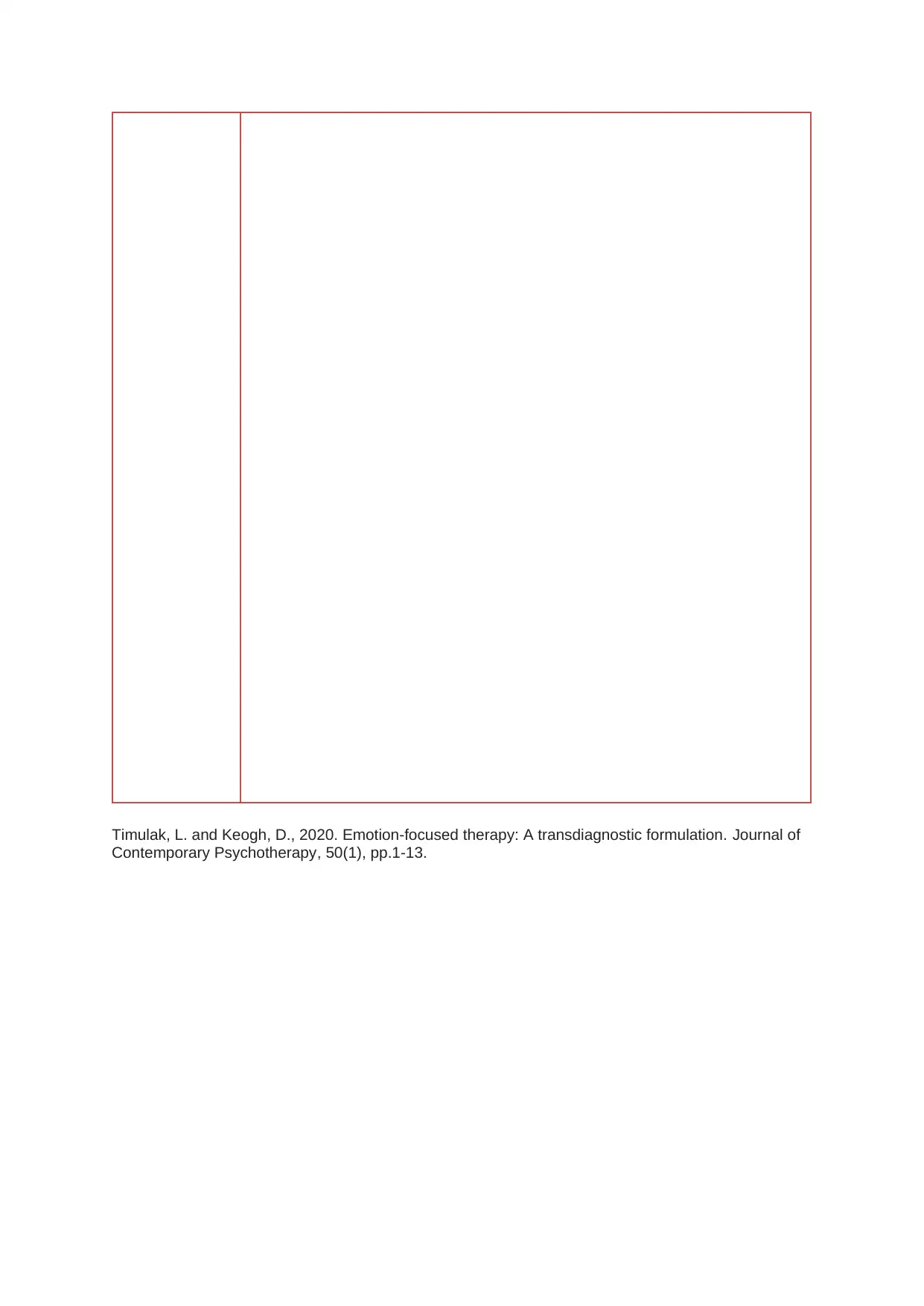
Timulak, L. and Keogh, D., 2020. Emotion-focused therapy: A transdiagnostic formulation. Journal of
Contemporary Psychotherapy, 50(1), pp.1-13.
Contemporary Psychotherapy, 50(1), pp.1-13.
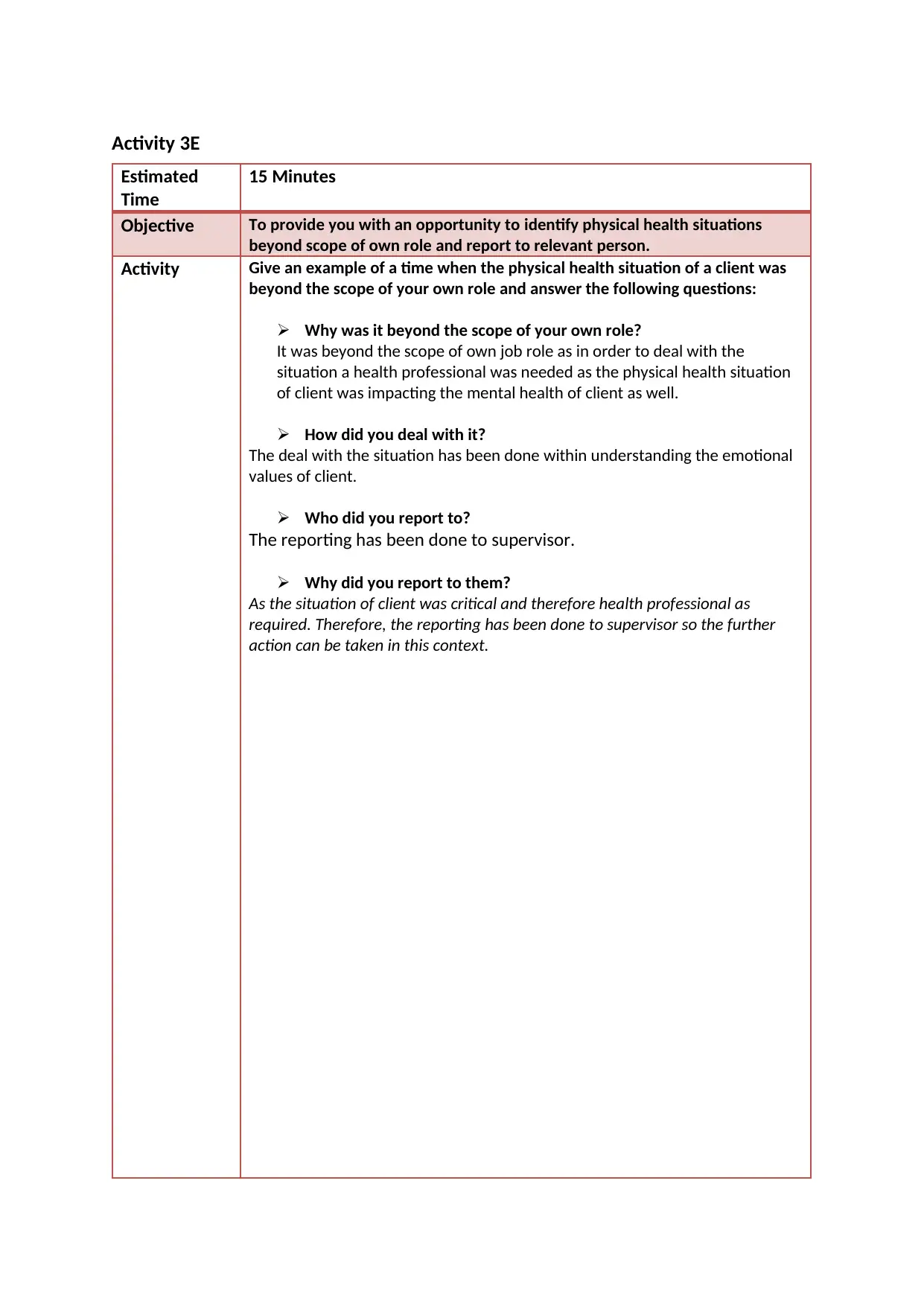
Activity 3E
Estimated
Time
15 Minutes
Objective To provide you with an opportunity to identify physical health situations
beyond scope of own role and report to relevant person.
Activity Give an example of a time when the physical health situation of a client was
beyond the scope of your own role and answer the following questions:
Why was it beyond the scope of your own role?
It was beyond the scope of own job role as in order to deal with the
situation a health professional was needed as the physical health situation
of client was impacting the mental health of client as well.
How did you deal with it?
The deal with the situation has been done within understanding the emotional
values of client.
Who did you report to?
The reporting has been done to supervisor.
Why did you report to them?
As the situation of client was critical and therefore health professional as
required. Therefore, the reporting has been done to supervisor so the further
action can be taken in this context.
Estimated
Time
15 Minutes
Objective To provide you with an opportunity to identify physical health situations
beyond scope of own role and report to relevant person.
Activity Give an example of a time when the physical health situation of a client was
beyond the scope of your own role and answer the following questions:
Why was it beyond the scope of your own role?
It was beyond the scope of own job role as in order to deal with the
situation a health professional was needed as the physical health situation
of client was impacting the mental health of client as well.
How did you deal with it?
The deal with the situation has been done within understanding the emotional
values of client.
Who did you report to?
The reporting has been done to supervisor.
Why did you report to them?
As the situation of client was critical and therefore health professional as
required. Therefore, the reporting has been done to supervisor so the further
action can be taken in this context.
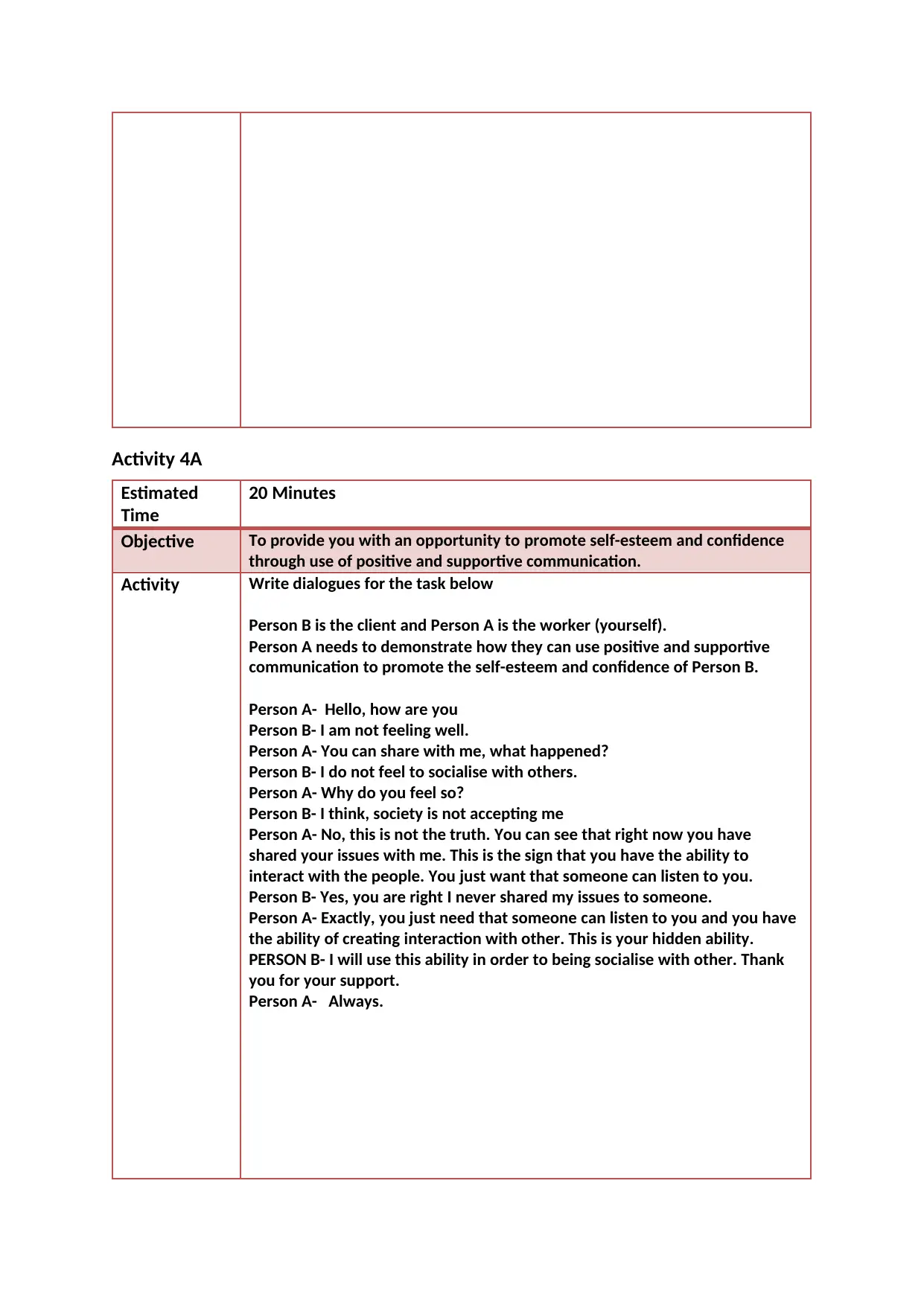
Activity 4A
Estimated
Time
20 Minutes
Objective To provide you with an opportunity to promote self-esteem and confidence
through use of positive and supportive communication.
Activity Write dialogues for the task below
Person B is the client and Person A is the worker (yourself).
Person A needs to demonstrate how they can use positive and supportive
communication to promote the self-esteem and confidence of Person B.
Person A- Hello, how are you
Person B- I am not feeling well.
Person A- You can share with me, what happened?
Person B- I do not feel to socialise with others.
Person A- Why do you feel so?
Person B- I think, society is not accepting me
Person A- No, this is not the truth. You can see that right now you have
shared your issues with me. This is the sign that you have the ability to
interact with the people. You just want that someone can listen to you.
Person B- Yes, you are right I never shared my issues to someone.
Person A- Exactly, you just need that someone can listen to you and you have
the ability of creating interaction with other. This is your hidden ability.
PERSON B- I will use this ability in order to being socialise with other. Thank
you for your support.
Person A- Always.
Estimated
Time
20 Minutes
Objective To provide you with an opportunity to promote self-esteem and confidence
through use of positive and supportive communication.
Activity Write dialogues for the task below
Person B is the client and Person A is the worker (yourself).
Person A needs to demonstrate how they can use positive and supportive
communication to promote the self-esteem and confidence of Person B.
Person A- Hello, how are you
Person B- I am not feeling well.
Person A- You can share with me, what happened?
Person B- I do not feel to socialise with others.
Person A- Why do you feel so?
Person B- I think, society is not accepting me
Person A- No, this is not the truth. You can see that right now you have
shared your issues with me. This is the sign that you have the ability to
interact with the people. You just want that someone can listen to you.
Person B- Yes, you are right I never shared my issues to someone.
Person A- Exactly, you just need that someone can listen to you and you have
the ability of creating interaction with other. This is your hidden ability.
PERSON B- I will use this ability in order to being socialise with other. Thank
you for your support.
Person A- Always.
Paraphrase This Document
Need a fresh take? Get an instant paraphrase of this document with our AI Paraphraser
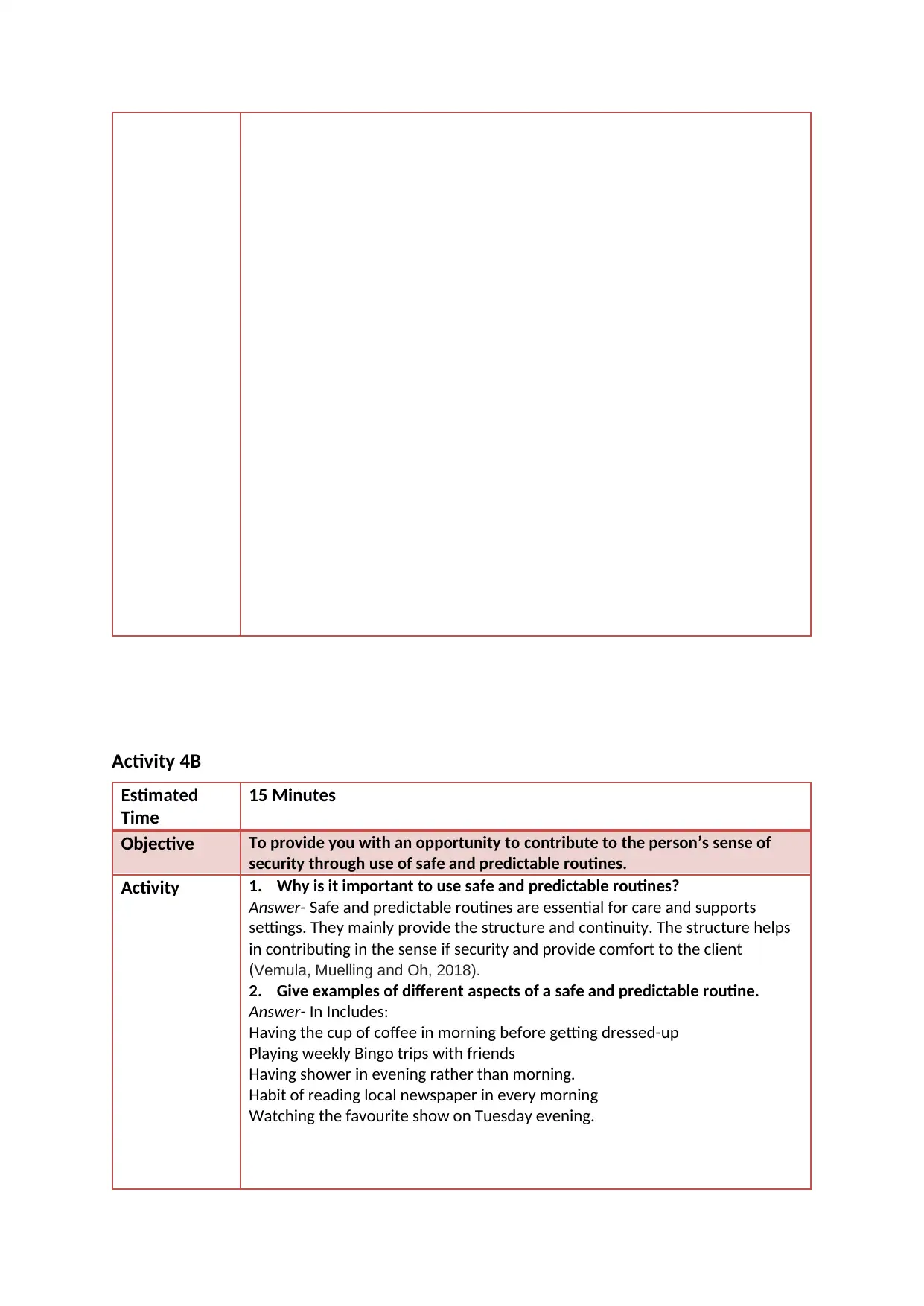
Activity 4B
Estimated
Time
15 Minutes
Objective To provide you with an opportunity to contribute to the person’s sense of
security through use of safe and predictable routines.
Activity 1. Why is it important to use safe and predictable routines?
Answer- Safe and predictable routines are essential for care and supports
settings. They mainly provide the structure and continuity. The structure helps
in contributing in the sense if security and provide comfort to the client
(Vemula, Muelling and Oh, 2018).
2. Give examples of different aspects of a safe and predictable routine.
Answer- In Includes:
Having the cup of coffee in morning before getting dressed-up
Playing weekly Bingo trips with friends
Having shower in evening rather than morning.
Habit of reading local newspaper in every morning
Watching the favourite show on Tuesday evening.
Estimated
Time
15 Minutes
Objective To provide you with an opportunity to contribute to the person’s sense of
security through use of safe and predictable routines.
Activity 1. Why is it important to use safe and predictable routines?
Answer- Safe and predictable routines are essential for care and supports
settings. They mainly provide the structure and continuity. The structure helps
in contributing in the sense if security and provide comfort to the client
(Vemula, Muelling and Oh, 2018).
2. Give examples of different aspects of a safe and predictable routine.
Answer- In Includes:
Having the cup of coffee in morning before getting dressed-up
Playing weekly Bingo trips with friends
Having shower in evening rather than morning.
Habit of reading local newspaper in every morning
Watching the favourite show on Tuesday evening.

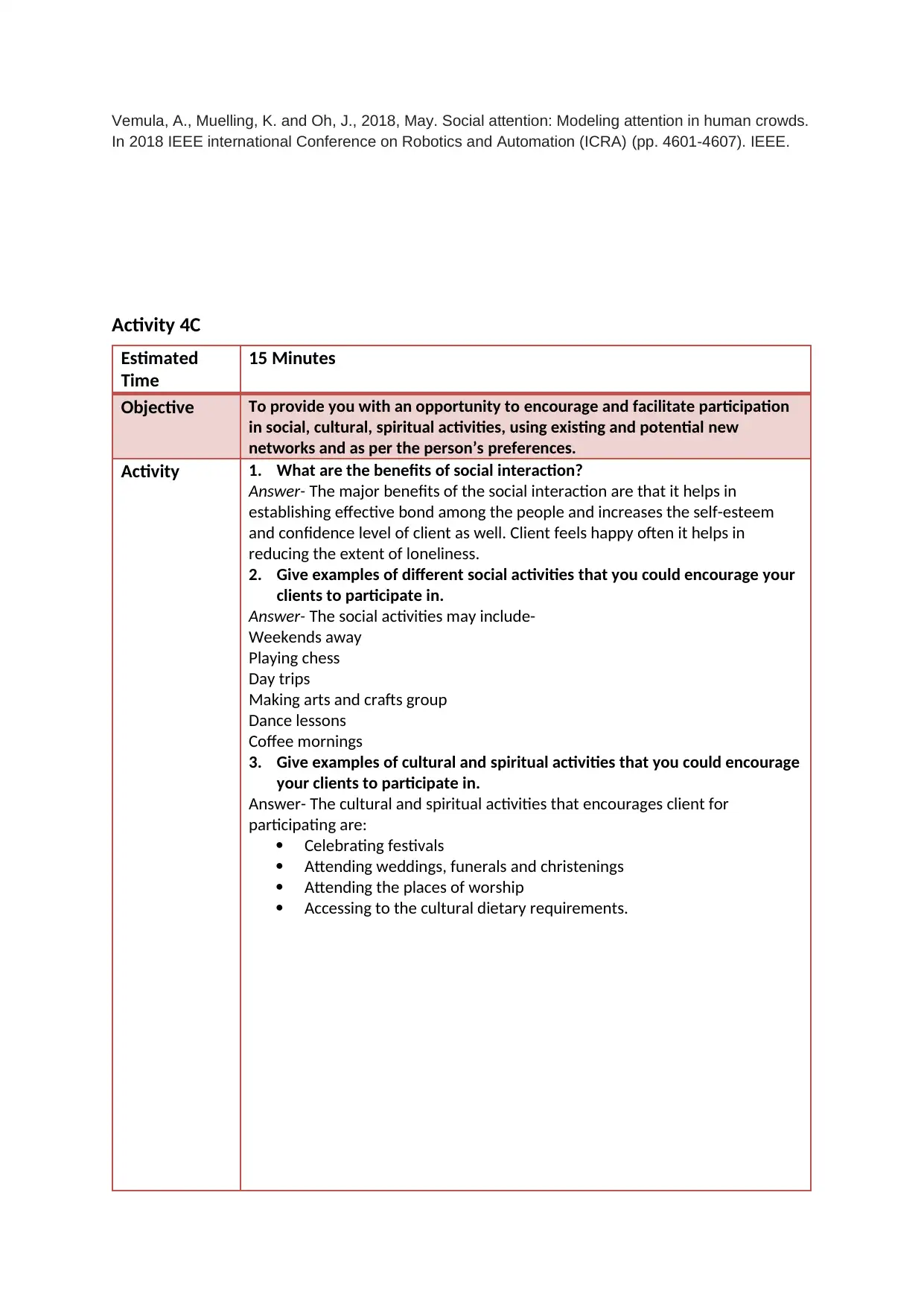
Vemula, A., Muelling, K. and Oh, J., 2018, May. Social attention: Modeling attention in human crowds.
In 2018 IEEE international Conference on Robotics and Automation (ICRA) (pp. 4601-4607). IEEE.
Activity 4C
Estimated
Time
15 Minutes
Objective To provide you with an opportunity to encourage and facilitate participation
in social, cultural, spiritual activities, using existing and potential new
networks and as per the person’s preferences.
Activity 1. What are the benefits of social interaction?
Answer- The major benefits of the social interaction are that it helps in
establishing effective bond among the people and increases the self-esteem
and confidence level of client as well. Client feels happy often it helps in
reducing the extent of loneliness.
2. Give examples of different social activities that you could encourage your
clients to participate in.
Answer- The social activities may include-
Weekends away
Playing chess
Day trips
Making arts and crafts group
Dance lessons
Coffee mornings
3. Give examples of cultural and spiritual activities that you could encourage
your clients to participate in.
Answer- The cultural and spiritual activities that encourages client for
participating are:
Celebrating festivals
Attending weddings, funerals and christenings
Attending the places of worship
Accessing to the cultural dietary requirements.
In 2018 IEEE international Conference on Robotics and Automation (ICRA) (pp. 4601-4607). IEEE.
Activity 4C
Estimated
Time
15 Minutes
Objective To provide you with an opportunity to encourage and facilitate participation
in social, cultural, spiritual activities, using existing and potential new
networks and as per the person’s preferences.
Activity 1. What are the benefits of social interaction?
Answer- The major benefits of the social interaction are that it helps in
establishing effective bond among the people and increases the self-esteem
and confidence level of client as well. Client feels happy often it helps in
reducing the extent of loneliness.
2. Give examples of different social activities that you could encourage your
clients to participate in.
Answer- The social activities may include-
Weekends away
Playing chess
Day trips
Making arts and crafts group
Dance lessons
Coffee mornings
3. Give examples of cultural and spiritual activities that you could encourage
your clients to participate in.
Answer- The cultural and spiritual activities that encourages client for
participating are:
Celebrating festivals
Attending weddings, funerals and christenings
Attending the places of worship
Accessing to the cultural dietary requirements.
Secure Best Marks with AI Grader
Need help grading? Try our AI Grader for instant feedback on your assignments.
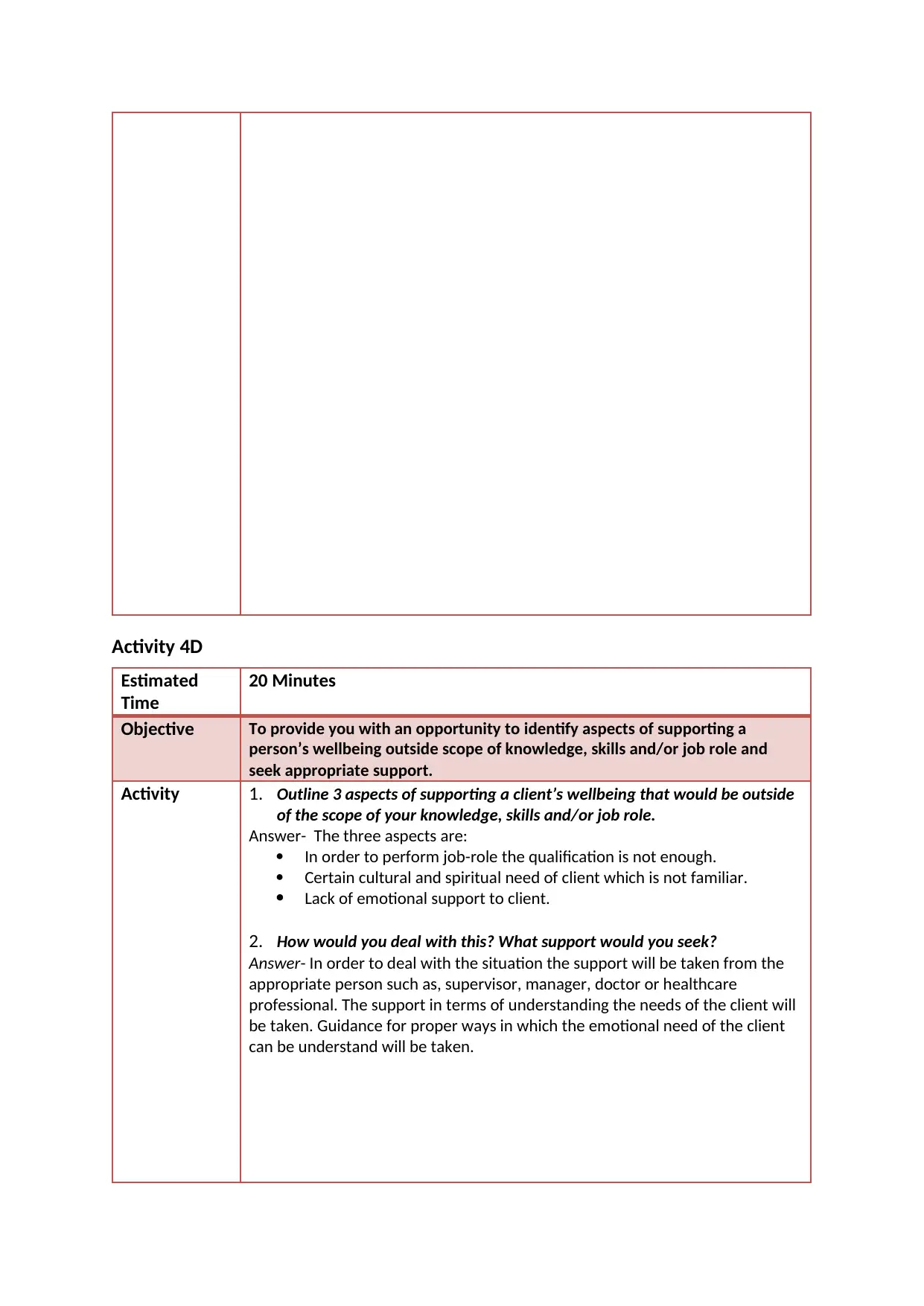
Activity 4D
Estimated
Time
20 Minutes
Objective To provide you with an opportunity to identify aspects of supporting a
person’s wellbeing outside scope of knowledge, skills and/or job role and
seek appropriate support.
Activity 1. Outline 3 aspects of supporting a client’s wellbeing that would be outside
of the scope of your knowledge, skills and/or job role.
Answer- The three aspects are:
In order to perform job-role the qualification is not enough.
Certain cultural and spiritual need of client which is not familiar.
Lack of emotional support to client.
2. How would you deal with this? What support would you seek?
Answer- In order to deal with the situation the support will be taken from the
appropriate person such as, supervisor, manager, doctor or healthcare
professional. The support in terms of understanding the needs of the client will
be taken. Guidance for proper ways in which the emotional need of the client
can be understand will be taken.
Estimated
Time
20 Minutes
Objective To provide you with an opportunity to identify aspects of supporting a
person’s wellbeing outside scope of knowledge, skills and/or job role and
seek appropriate support.
Activity 1. Outline 3 aspects of supporting a client’s wellbeing that would be outside
of the scope of your knowledge, skills and/or job role.
Answer- The three aspects are:
In order to perform job-role the qualification is not enough.
Certain cultural and spiritual need of client which is not familiar.
Lack of emotional support to client.
2. How would you deal with this? What support would you seek?
Answer- In order to deal with the situation the support will be taken from the
appropriate person such as, supervisor, manager, doctor or healthcare
professional. The support in terms of understanding the needs of the client will
be taken. Guidance for proper ways in which the emotional need of the client
can be understand will be taken.
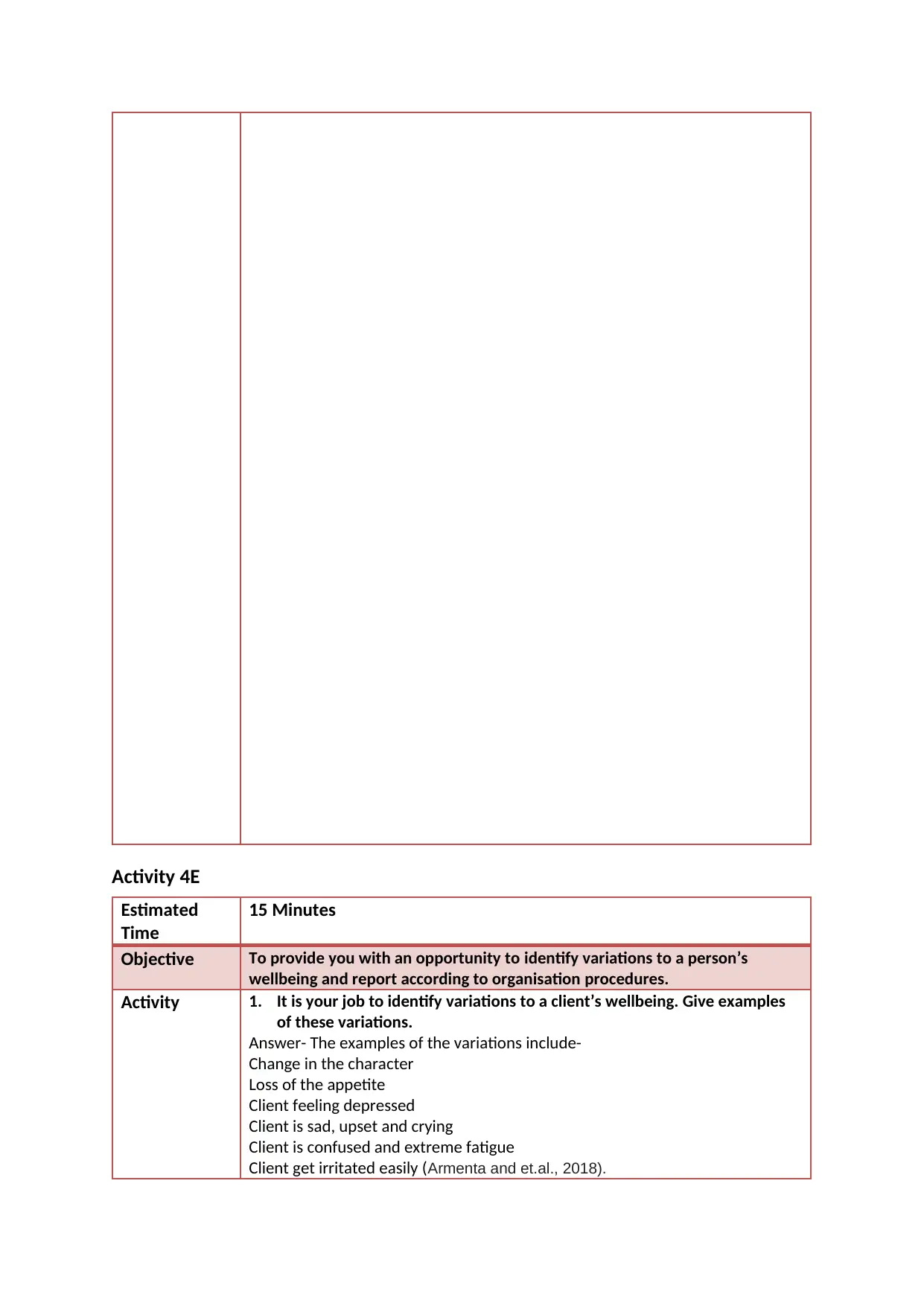
Activity 4E
Estimated
Time
15 Minutes
Objective To provide you with an opportunity to identify variations to a person’s
wellbeing and report according to organisation procedures.
Activity 1. It is your job to identify variations to a client’s wellbeing. Give examples
of these variations.
Answer- The examples of the variations include-
Change in the character
Loss of the appetite
Client feeling depressed
Client is sad, upset and crying
Client is confused and extreme fatigue
Client get irritated easily (Armenta and et.al., 2018).
Estimated
Time
15 Minutes
Objective To provide you with an opportunity to identify variations to a person’s
wellbeing and report according to organisation procedures.
Activity 1. It is your job to identify variations to a client’s wellbeing. Give examples
of these variations.
Answer- The examples of the variations include-
Change in the character
Loss of the appetite
Client feeling depressed
Client is sad, upset and crying
Client is confused and extreme fatigue
Client get irritated easily (Armenta and et.al., 2018).
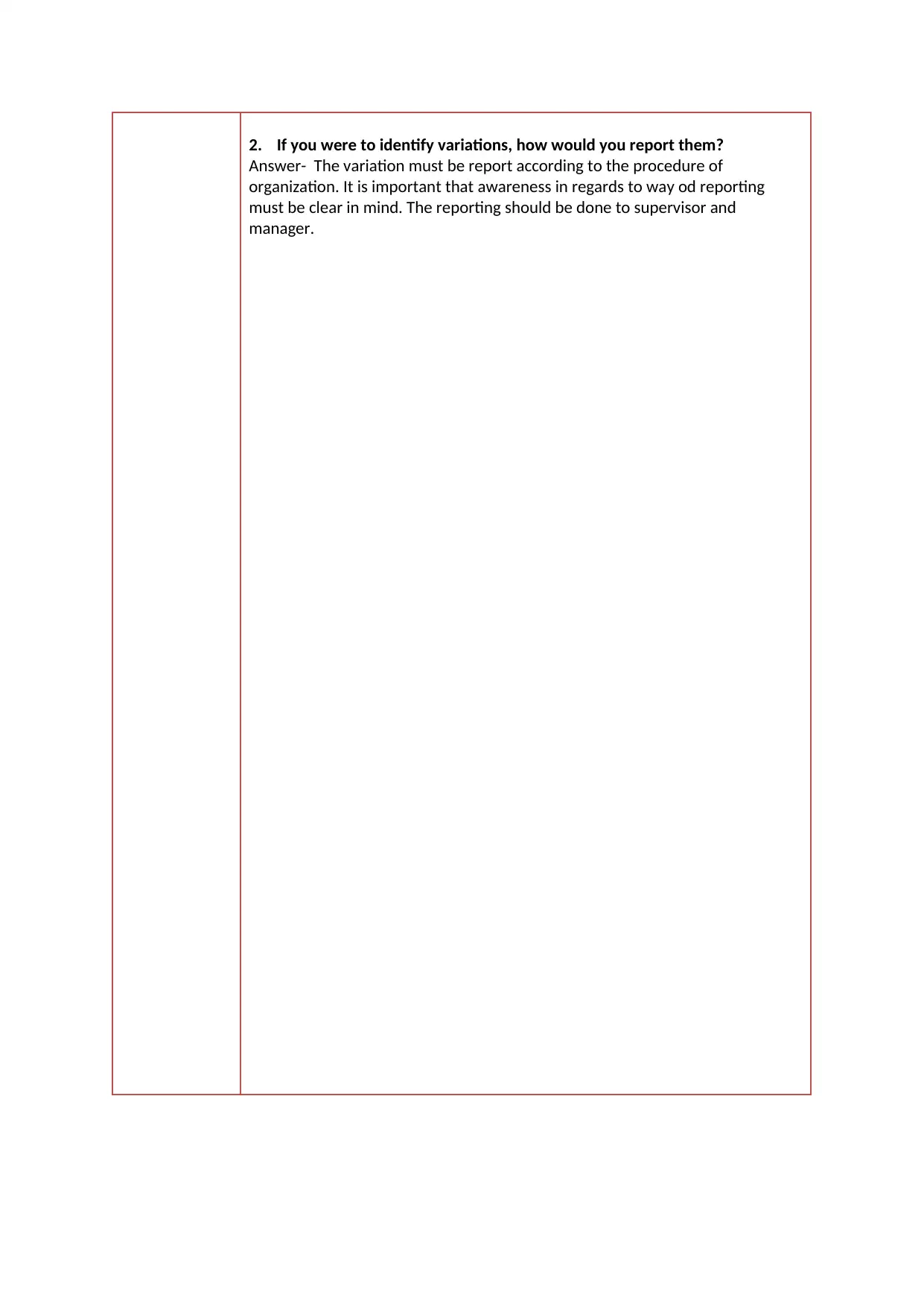
2. If you were to identify variations, how would you report them?
Answer- The variation must be report according to the procedure of
organization. It is important that awareness in regards to way od reporting
must be clear in mind. The reporting should be done to supervisor and
manager.
Answer- The variation must be report according to the procedure of
organization. It is important that awareness in regards to way od reporting
must be clear in mind. The reporting should be done to supervisor and
manager.
Paraphrase This Document
Need a fresh take? Get an instant paraphrase of this document with our AI Paraphraser
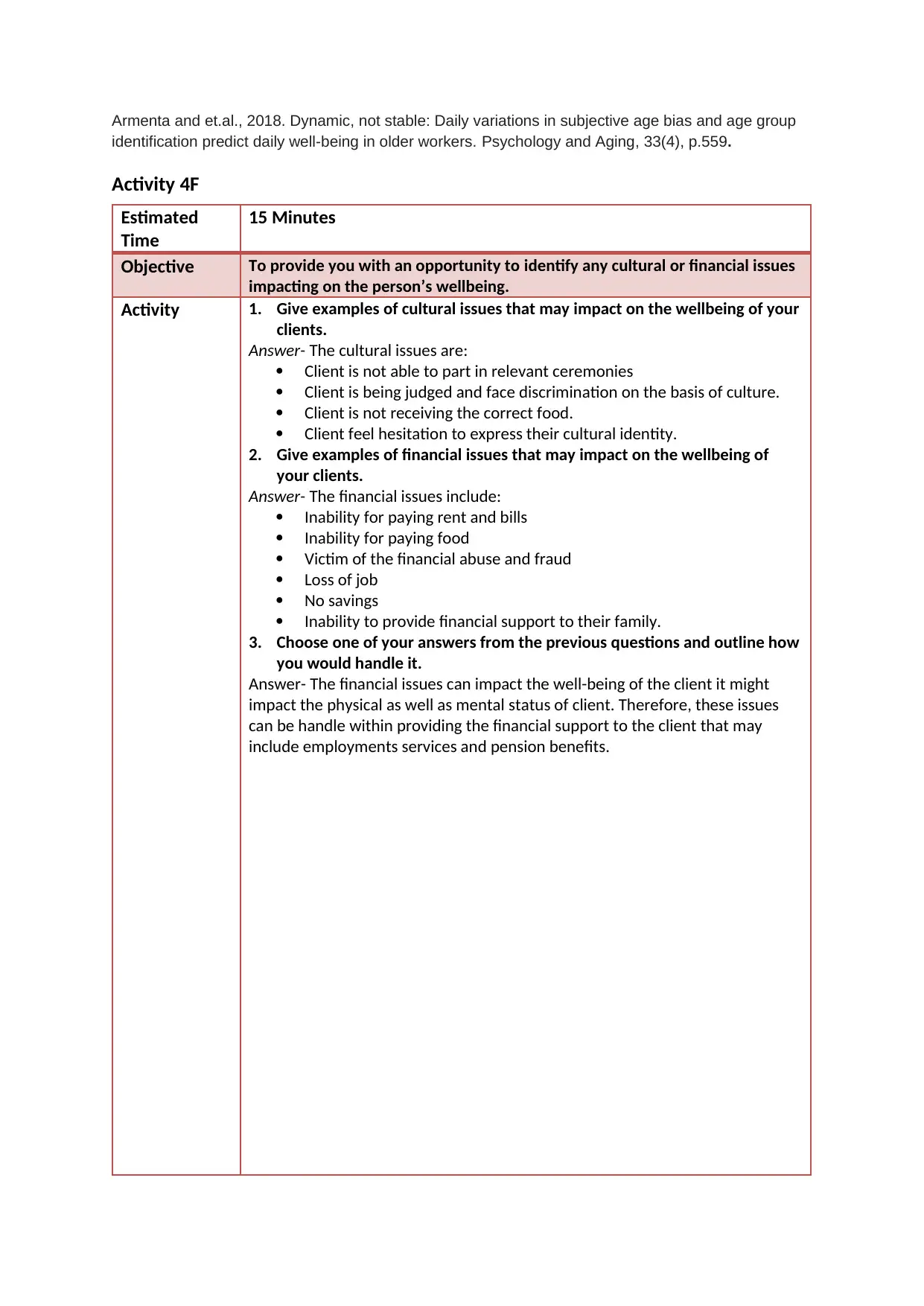
Armenta and et.al., 2018. Dynamic, not stable: Daily variations in subjective age bias and age group
identification predict daily well-being in older workers. Psychology and Aging, 33(4), p.559.
Activity 4F
Estimated
Time
15 Minutes
Objective To provide you with an opportunity to identify any cultural or financial issues
impacting on the person’s wellbeing.
Activity 1. Give examples of cultural issues that may impact on the wellbeing of your
clients.
Answer- The cultural issues are:
Client is not able to part in relevant ceremonies
Client is being judged and face discrimination on the basis of culture.
Client is not receiving the correct food.
Client feel hesitation to express their cultural identity.
2. Give examples of financial issues that may impact on the wellbeing of
your clients.
Answer- The financial issues include:
Inability for paying rent and bills
Inability for paying food
Victim of the financial abuse and fraud
Loss of job
No savings
Inability to provide financial support to their family.
3. Choose one of your answers from the previous questions and outline how
you would handle it.
Answer- The financial issues can impact the well-being of the client it might
impact the physical as well as mental status of client. Therefore, these issues
can be handle within providing the financial support to the client that may
include employments services and pension benefits.
identification predict daily well-being in older workers. Psychology and Aging, 33(4), p.559.
Activity 4F
Estimated
Time
15 Minutes
Objective To provide you with an opportunity to identify any cultural or financial issues
impacting on the person’s wellbeing.
Activity 1. Give examples of cultural issues that may impact on the wellbeing of your
clients.
Answer- The cultural issues are:
Client is not able to part in relevant ceremonies
Client is being judged and face discrimination on the basis of culture.
Client is not receiving the correct food.
Client feel hesitation to express their cultural identity.
2. Give examples of financial issues that may impact on the wellbeing of
your clients.
Answer- The financial issues include:
Inability for paying rent and bills
Inability for paying food
Victim of the financial abuse and fraud
Loss of job
No savings
Inability to provide financial support to their family.
3. Choose one of your answers from the previous questions and outline how
you would handle it.
Answer- The financial issues can impact the well-being of the client it might
impact the physical as well as mental status of client. Therefore, these issues
can be handle within providing the financial support to the client that may
include employments services and pension benefits.
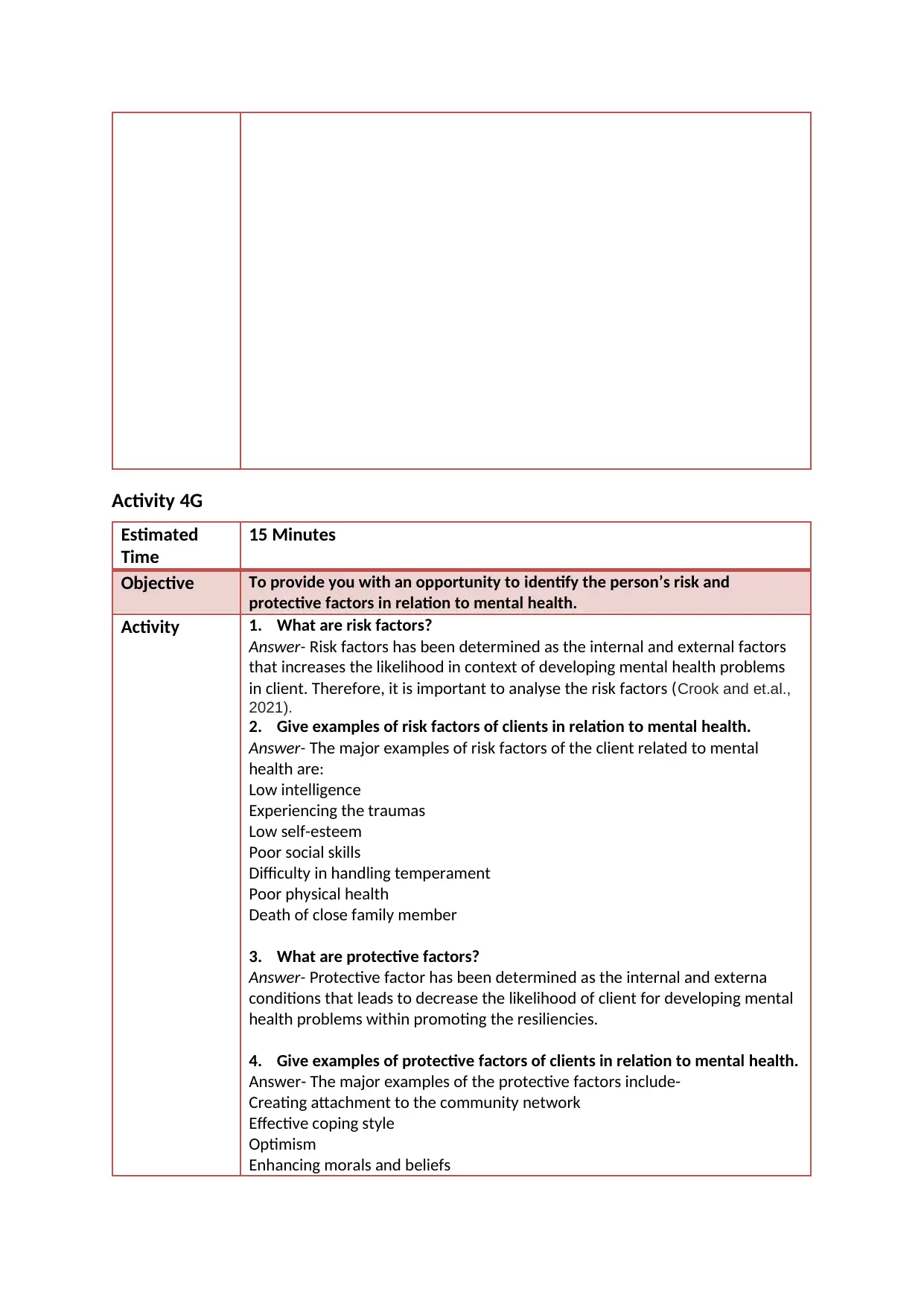
Activity 4G
Estimated
Time
15 Minutes
Objective To provide you with an opportunity to identify the person’s risk and
protective factors in relation to mental health.
Activity 1. What are risk factors?
Answer- Risk factors has been determined as the internal and external factors
that increases the likelihood in context of developing mental health problems
in client. Therefore, it is important to analyse the risk factors (Crook and et.al.,
2021).
2. Give examples of risk factors of clients in relation to mental health.
Answer- The major examples of risk factors of the client related to mental
health are:
Low intelligence
Experiencing the traumas
Low self-esteem
Poor social skills
Difficulty in handling temperament
Poor physical health
Death of close family member
3. What are protective factors?
Answer- Protective factor has been determined as the internal and externa
conditions that leads to decrease the likelihood of client for developing mental
health problems within promoting the resiliencies.
4. Give examples of protective factors of clients in relation to mental health.
Answer- The major examples of the protective factors include-
Creating attachment to the community network
Effective coping style
Optimism
Enhancing morals and beliefs
Estimated
Time
15 Minutes
Objective To provide you with an opportunity to identify the person’s risk and
protective factors in relation to mental health.
Activity 1. What are risk factors?
Answer- Risk factors has been determined as the internal and external factors
that increases the likelihood in context of developing mental health problems
in client. Therefore, it is important to analyse the risk factors (Crook and et.al.,
2021).
2. Give examples of risk factors of clients in relation to mental health.
Answer- The major examples of risk factors of the client related to mental
health are:
Low intelligence
Experiencing the traumas
Low self-esteem
Poor social skills
Difficulty in handling temperament
Poor physical health
Death of close family member
3. What are protective factors?
Answer- Protective factor has been determined as the internal and externa
conditions that leads to decrease the likelihood of client for developing mental
health problems within promoting the resiliencies.
4. Give examples of protective factors of clients in relation to mental health.
Answer- The major examples of the protective factors include-
Creating attachment to the community network
Effective coping style
Optimism
Enhancing morals and beliefs
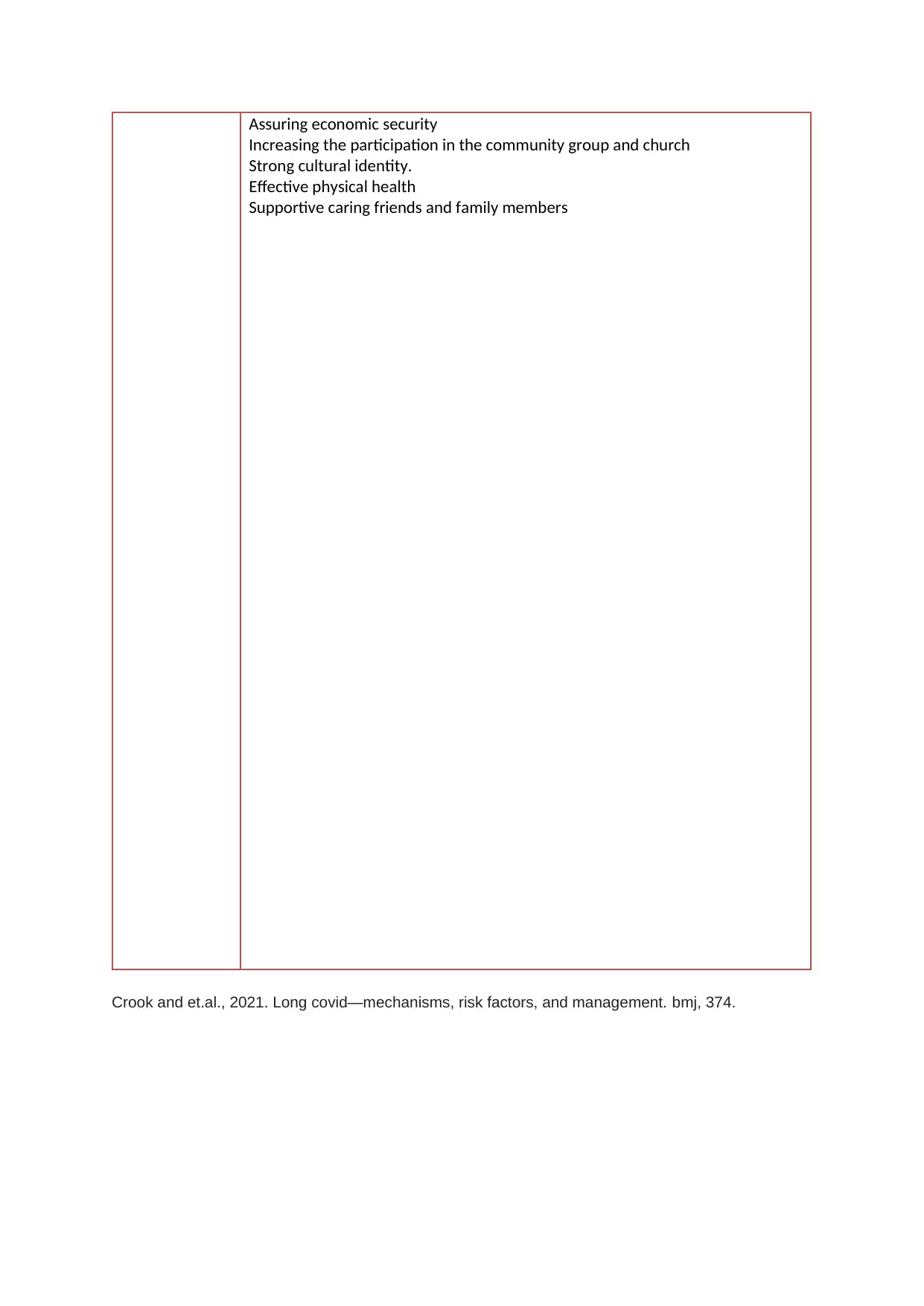
Assuring economic security
Increasing the participation in the community group and church
Strong cultural identity.
Effective physical health
Supportive caring friends and family members
Crook and et.al., 2021. Long covid—mechanisms, risk factors, and management. bmj, 374.
Increasing the participation in the community group and church
Strong cultural identity.
Effective physical health
Supportive caring friends and family members
Crook and et.al., 2021. Long covid—mechanisms, risk factors, and management. bmj, 374.
Secure Best Marks with AI Grader
Need help grading? Try our AI Grader for instant feedback on your assignments.
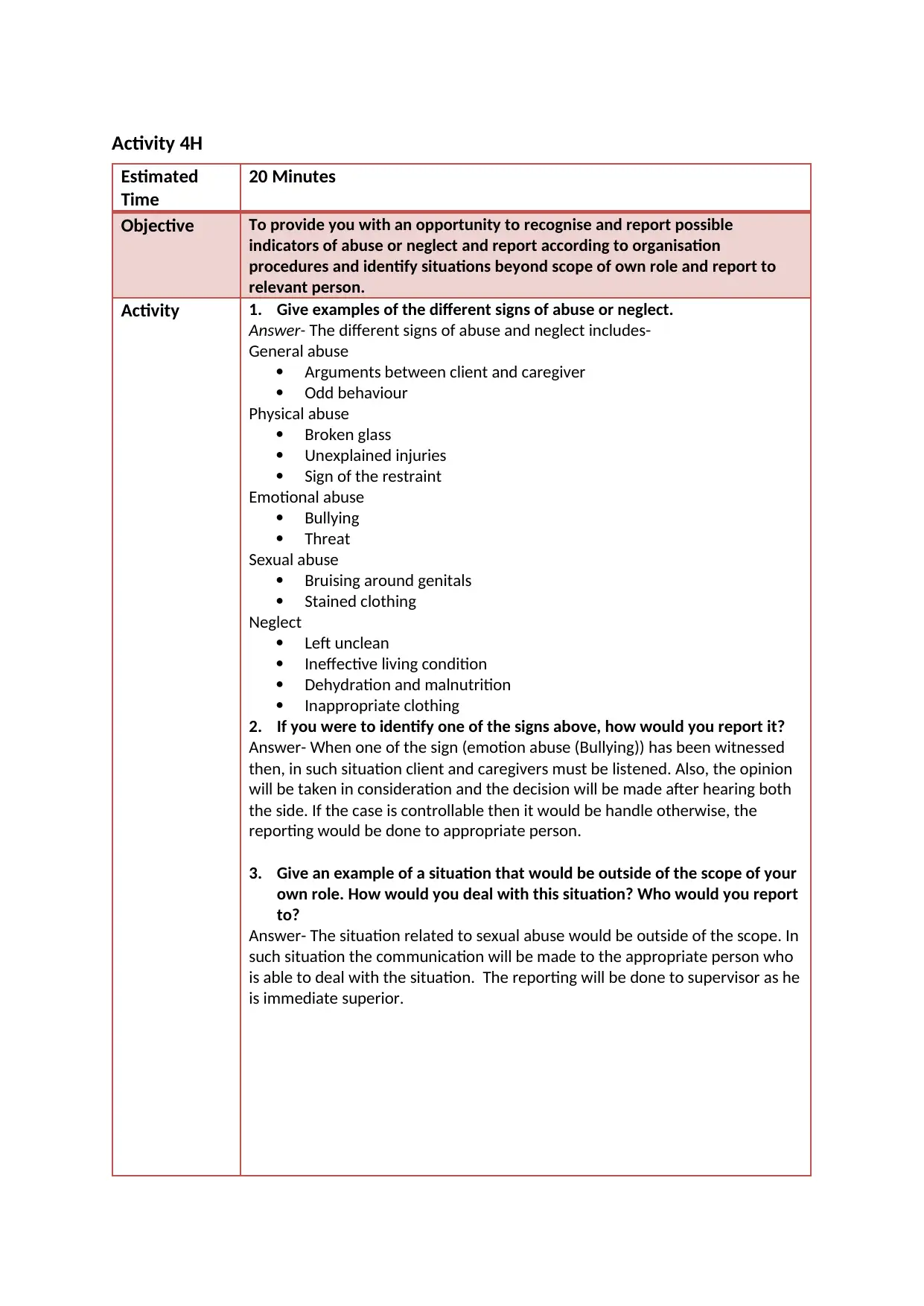
Activity 4H
Estimated
Time
20 Minutes
Objective To provide you with an opportunity to recognise and report possible
indicators of abuse or neglect and report according to organisation
procedures and identify situations beyond scope of own role and report to
relevant person.
Activity 1. Give examples of the different signs of abuse or neglect.
Answer- The different signs of abuse and neglect includes-
General abuse
Arguments between client and caregiver
Odd behaviour
Physical abuse
Broken glass
Unexplained injuries
Sign of the restraint
Emotional abuse
Bullying
Threat
Sexual abuse
Bruising around genitals
Stained clothing
Neglect
Left unclean
Ineffective living condition
Dehydration and malnutrition
Inappropriate clothing
2. If you were to identify one of the signs above, how would you report it?
Answer- When one of the sign (emotion abuse (Bullying)) has been witnessed
then, in such situation client and caregivers must be listened. Also, the opinion
will be taken in consideration and the decision will be made after hearing both
the side. If the case is controllable then it would be handle otherwise, the
reporting would be done to appropriate person.
3. Give an example of a situation that would be outside of the scope of your
own role. How would you deal with this situation? Who would you report
to?
Answer- The situation related to sexual abuse would be outside of the scope. In
such situation the communication will be made to the appropriate person who
is able to deal with the situation. The reporting will be done to supervisor as he
is immediate superior.
Estimated
Time
20 Minutes
Objective To provide you with an opportunity to recognise and report possible
indicators of abuse or neglect and report according to organisation
procedures and identify situations beyond scope of own role and report to
relevant person.
Activity 1. Give examples of the different signs of abuse or neglect.
Answer- The different signs of abuse and neglect includes-
General abuse
Arguments between client and caregiver
Odd behaviour
Physical abuse
Broken glass
Unexplained injuries
Sign of the restraint
Emotional abuse
Bullying
Threat
Sexual abuse
Bruising around genitals
Stained clothing
Neglect
Left unclean
Ineffective living condition
Dehydration and malnutrition
Inappropriate clothing
2. If you were to identify one of the signs above, how would you report it?
Answer- When one of the sign (emotion abuse (Bullying)) has been witnessed
then, in such situation client and caregivers must be listened. Also, the opinion
will be taken in consideration and the decision will be made after hearing both
the side. If the case is controllable then it would be handle otherwise, the
reporting would be done to appropriate person.
3. Give an example of a situation that would be outside of the scope of your
own role. How would you deal with this situation? Who would you report
to?
Answer- The situation related to sexual abuse would be outside of the scope. In
such situation the communication will be made to the appropriate person who
is able to deal with the situation. The reporting will be done to supervisor as he
is immediate superior.

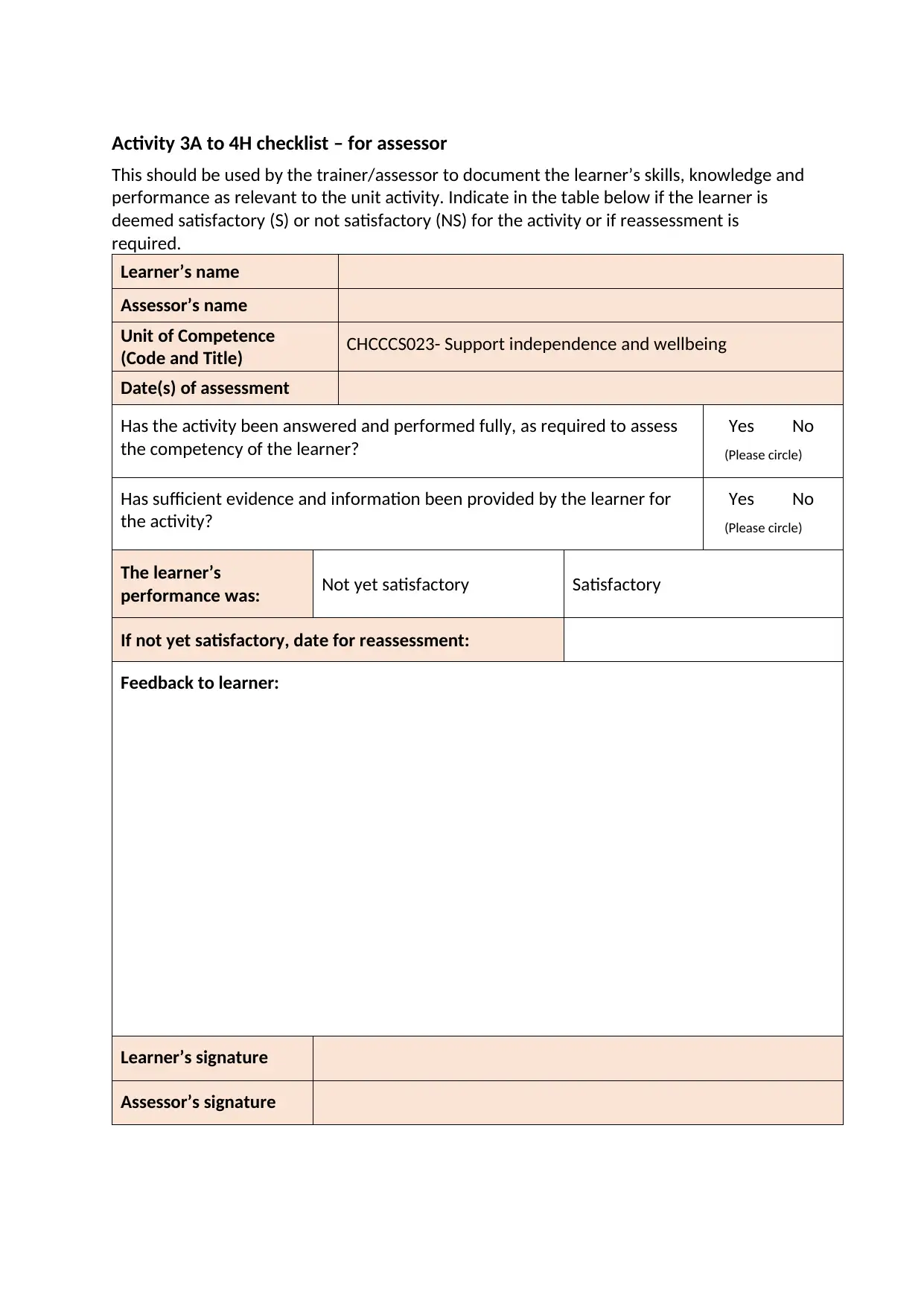
Activity 3A to 4H checklist – for assessor
This should be used by the trainer/assessor to document the learner’s skills, knowledge and
performance as relevant to the unit activity. Indicate in the table below if the learner is
deemed satisfactory (S) or not satisfactory (NS) for the activity or if reassessment is
required.
Learner’s name
Assessor’s name
Unit of Competence
(Code and Title) CHCCCS023- Support independence and wellbeing
Date(s) of assessment
Has the activity been answered and performed fully, as required to assess
the competency of the learner?
Yes No
(Please circle)
Has sufficient evidence and information been provided by the learner for
the activity?
Yes No
(Please circle)
The learner’s
performance was: Not yet satisfactory Satisfactory
If not yet satisfactory, date for reassessment:
Feedback to learner:
Learner’s signature
Assessor’s signature
This should be used by the trainer/assessor to document the learner’s skills, knowledge and
performance as relevant to the unit activity. Indicate in the table below if the learner is
deemed satisfactory (S) or not satisfactory (NS) for the activity or if reassessment is
required.
Learner’s name
Assessor’s name
Unit of Competence
(Code and Title) CHCCCS023- Support independence and wellbeing
Date(s) of assessment
Has the activity been answered and performed fully, as required to assess
the competency of the learner?
Yes No
(Please circle)
Has sufficient evidence and information been provided by the learner for
the activity?
Yes No
(Please circle)
The learner’s
performance was: Not yet satisfactory Satisfactory
If not yet satisfactory, date for reassessment:
Feedback to learner:
Learner’s signature
Assessor’s signature
Paraphrase This Document
Need a fresh take? Get an instant paraphrase of this document with our AI Paraphraser
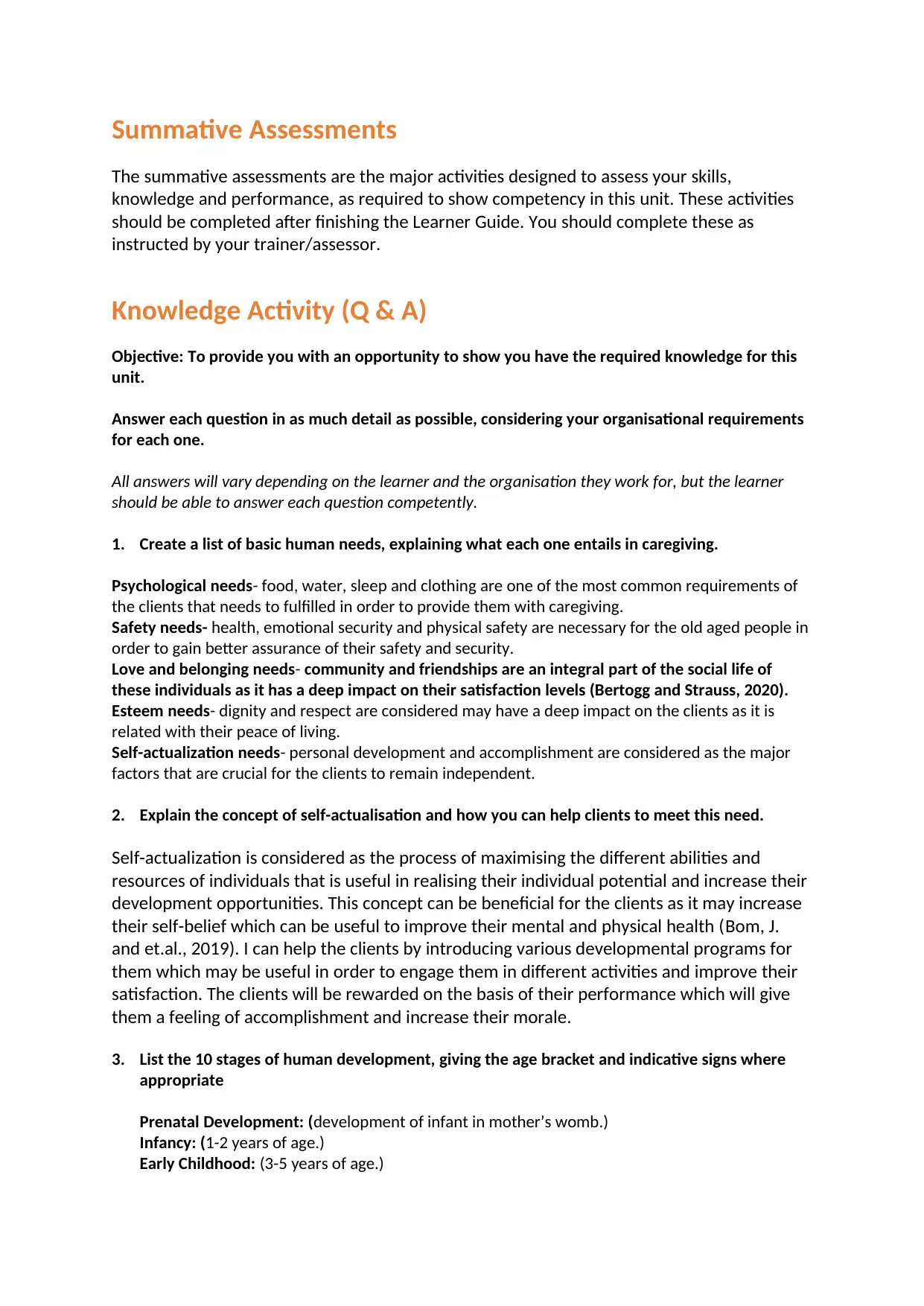
Summative Assessments
The summative assessments are the major activities designed to assess your skills,
knowledge and performance, as required to show competency in this unit. These activities
should be completed after finishing the Learner Guide. You should complete these as
instructed by your trainer/assessor.
Knowledge Activity (Q & A)
Objective: To provide you with an opportunity to show you have the required knowledge for this
unit.
Answer each question in as much detail as possible, considering your organisational requirements
for each one.
All answers will vary depending on the learner and the organisation they work for, but the learner
should be able to answer each question competently.
1. Create a list of basic human needs, explaining what each one entails in caregiving.
Psychological needs- food, water, sleep and clothing are one of the most common requirements of
the clients that needs to fulfilled in order to provide them with caregiving.
Safety needs- health, emotional security and physical safety are necessary for the old aged people in
order to gain better assurance of their safety and security.
Love and belonging needs- community and friendships are an integral part of the social life of
these individuals as it has a deep impact on their satisfaction levels (Bertogg and Strauss, 2020).
Esteem needs- dignity and respect are considered may have a deep impact on the clients as it is
related with their peace of living.
Self-actualization needs- personal development and accomplishment are considered as the major
factors that are crucial for the clients to remain independent.
2. Explain the concept of self-actualisation and how you can help clients to meet this need.
Self-actualization is considered as the process of maximising the different abilities and
resources of individuals that is useful in realising their individual potential and increase their
development opportunities. This concept can be beneficial for the clients as it may increase
their self-belief which can be useful to improve their mental and physical health (Bom, J.
and et.al., 2019). I can help the clients by introducing various developmental programs for
them which may be useful in order to engage them in different activities and improve their
satisfaction. The clients will be rewarded on the basis of their performance which will give
them a feeling of accomplishment and increase their morale.
3. List the 10 stages of human development, giving the age bracket and indicative signs where
appropriate
Prenatal Development: (development of infant in mother’s womb.)
Infancy: (1-2 years of age.)
Early Childhood: (3-5 years of age.)
The summative assessments are the major activities designed to assess your skills,
knowledge and performance, as required to show competency in this unit. These activities
should be completed after finishing the Learner Guide. You should complete these as
instructed by your trainer/assessor.
Knowledge Activity (Q & A)
Objective: To provide you with an opportunity to show you have the required knowledge for this
unit.
Answer each question in as much detail as possible, considering your organisational requirements
for each one.
All answers will vary depending on the learner and the organisation they work for, but the learner
should be able to answer each question competently.
1. Create a list of basic human needs, explaining what each one entails in caregiving.
Psychological needs- food, water, sleep and clothing are one of the most common requirements of
the clients that needs to fulfilled in order to provide them with caregiving.
Safety needs- health, emotional security and physical safety are necessary for the old aged people in
order to gain better assurance of their safety and security.
Love and belonging needs- community and friendships are an integral part of the social life of
these individuals as it has a deep impact on their satisfaction levels (Bertogg and Strauss, 2020).
Esteem needs- dignity and respect are considered may have a deep impact on the clients as it is
related with their peace of living.
Self-actualization needs- personal development and accomplishment are considered as the major
factors that are crucial for the clients to remain independent.
2. Explain the concept of self-actualisation and how you can help clients to meet this need.
Self-actualization is considered as the process of maximising the different abilities and
resources of individuals that is useful in realising their individual potential and increase their
development opportunities. This concept can be beneficial for the clients as it may increase
their self-belief which can be useful to improve their mental and physical health (Bom, J.
and et.al., 2019). I can help the clients by introducing various developmental programs for
them which may be useful in order to engage them in different activities and improve their
satisfaction. The clients will be rewarded on the basis of their performance which will give
them a feeling of accomplishment and increase their morale.
3. List the 10 stages of human development, giving the age bracket and indicative signs where
appropriate
Prenatal Development: (development of infant in mother’s womb.)
Infancy: (1-2 years of age.)
Early Childhood: (3-5 years of age.)
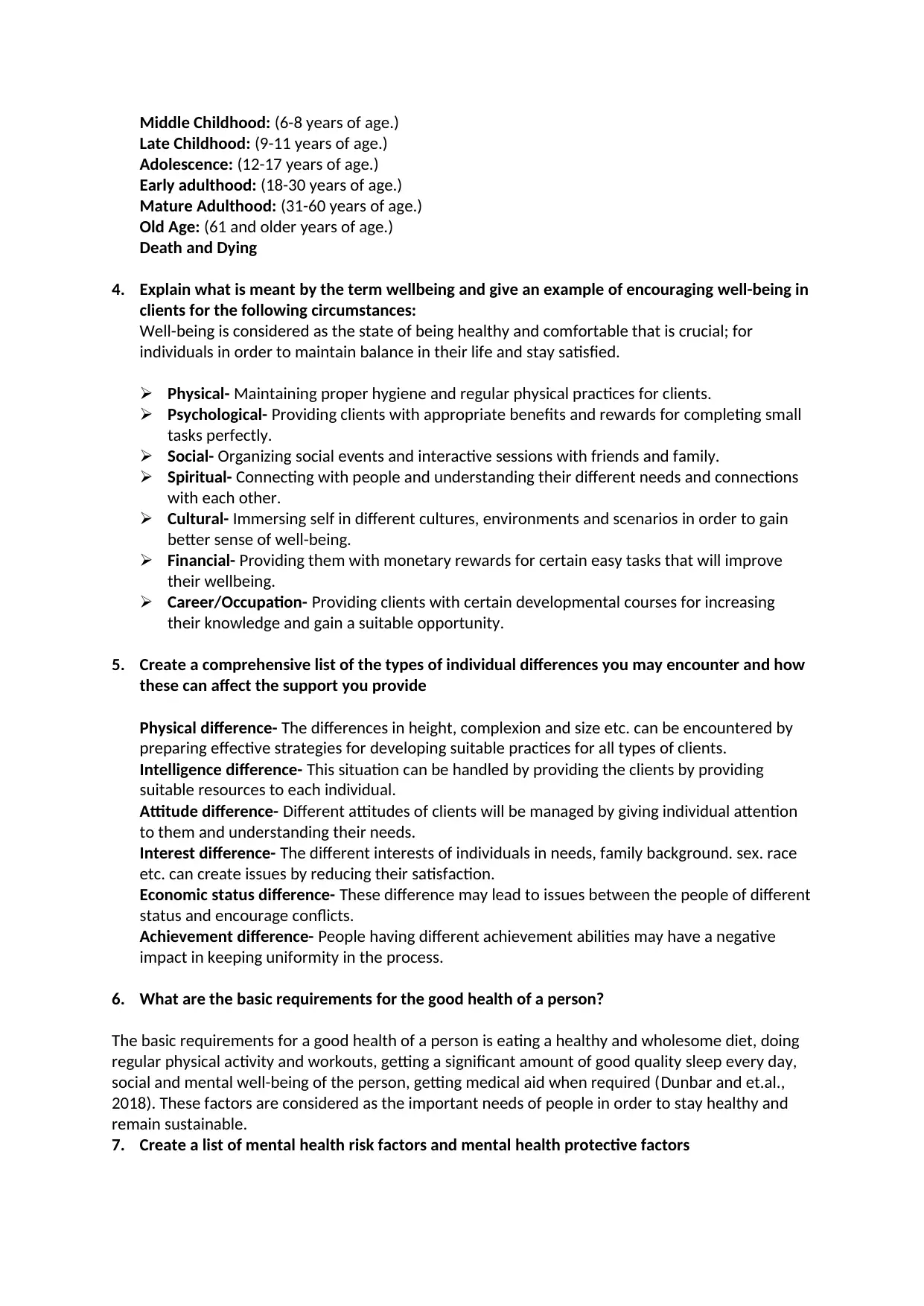
Middle Childhood: (6-8 years of age.)
Late Childhood: (9-11 years of age.)
Adolescence: (12-17 years of age.)
Early adulthood: (18-30 years of age.)
Mature Adulthood: (31-60 years of age.)
Old Age: (61 and older years of age.)
Death and Dying
4. Explain what is meant by the term wellbeing and give an example of encouraging well-being in
clients for the following circumstances:
Well-being is considered as the state of being healthy and comfortable that is crucial; for
individuals in order to maintain balance in their life and stay satisfied.
Physical- Maintaining proper hygiene and regular physical practices for clients.
Psychological- Providing clients with appropriate benefits and rewards for completing small
tasks perfectly.
Social- Organizing social events and interactive sessions with friends and family.
Spiritual- Connecting with people and understanding their different needs and connections
with each other.
Cultural- Immersing self in different cultures, environments and scenarios in order to gain
better sense of well-being.
Financial- Providing them with monetary rewards for certain easy tasks that will improve
their wellbeing.
Career/Occupation- Providing clients with certain developmental courses for increasing
their knowledge and gain a suitable opportunity.
5. Create a comprehensive list of the types of individual differences you may encounter and how
these can affect the support you provide
Physical difference- The differences in height, complexion and size etc. can be encountered by
preparing effective strategies for developing suitable practices for all types of clients.
Intelligence difference- This situation can be handled by providing the clients by providing
suitable resources to each individual.
Attitude difference- Different attitudes of clients will be managed by giving individual attention
to them and understanding their needs.
Interest difference- The different interests of individuals in needs, family background. sex. race
etc. can create issues by reducing their satisfaction.
Economic status difference- These difference may lead to issues between the people of different
status and encourage conflicts.
Achievement difference- People having different achievement abilities may have a negative
impact in keeping uniformity in the process.
6. What are the basic requirements for the good health of a person?
The basic requirements for a good health of a person is eating a healthy and wholesome diet, doing
regular physical activity and workouts, getting a significant amount of good quality sleep every day,
social and mental well-being of the person, getting medical aid when required (Dunbar and et.al.,
2018). These factors are considered as the important needs of people in order to stay healthy and
remain sustainable.
7. Create a list of mental health risk factors and mental health protective factors
Late Childhood: (9-11 years of age.)
Adolescence: (12-17 years of age.)
Early adulthood: (18-30 years of age.)
Mature Adulthood: (31-60 years of age.)
Old Age: (61 and older years of age.)
Death and Dying
4. Explain what is meant by the term wellbeing and give an example of encouraging well-being in
clients for the following circumstances:
Well-being is considered as the state of being healthy and comfortable that is crucial; for
individuals in order to maintain balance in their life and stay satisfied.
Physical- Maintaining proper hygiene and regular physical practices for clients.
Psychological- Providing clients with appropriate benefits and rewards for completing small
tasks perfectly.
Social- Organizing social events and interactive sessions with friends and family.
Spiritual- Connecting with people and understanding their different needs and connections
with each other.
Cultural- Immersing self in different cultures, environments and scenarios in order to gain
better sense of well-being.
Financial- Providing them with monetary rewards for certain easy tasks that will improve
their wellbeing.
Career/Occupation- Providing clients with certain developmental courses for increasing
their knowledge and gain a suitable opportunity.
5. Create a comprehensive list of the types of individual differences you may encounter and how
these can affect the support you provide
Physical difference- The differences in height, complexion and size etc. can be encountered by
preparing effective strategies for developing suitable practices for all types of clients.
Intelligence difference- This situation can be handled by providing the clients by providing
suitable resources to each individual.
Attitude difference- Different attitudes of clients will be managed by giving individual attention
to them and understanding their needs.
Interest difference- The different interests of individuals in needs, family background. sex. race
etc. can create issues by reducing their satisfaction.
Economic status difference- These difference may lead to issues between the people of different
status and encourage conflicts.
Achievement difference- People having different achievement abilities may have a negative
impact in keeping uniformity in the process.
6. What are the basic requirements for the good health of a person?
The basic requirements for a good health of a person is eating a healthy and wholesome diet, doing
regular physical activity and workouts, getting a significant amount of good quality sleep every day,
social and mental well-being of the person, getting medical aid when required (Dunbar and et.al.,
2018). These factors are considered as the important needs of people in order to stay healthy and
remain sustainable.
7. Create a list of mental health risk factors and mental health protective factors
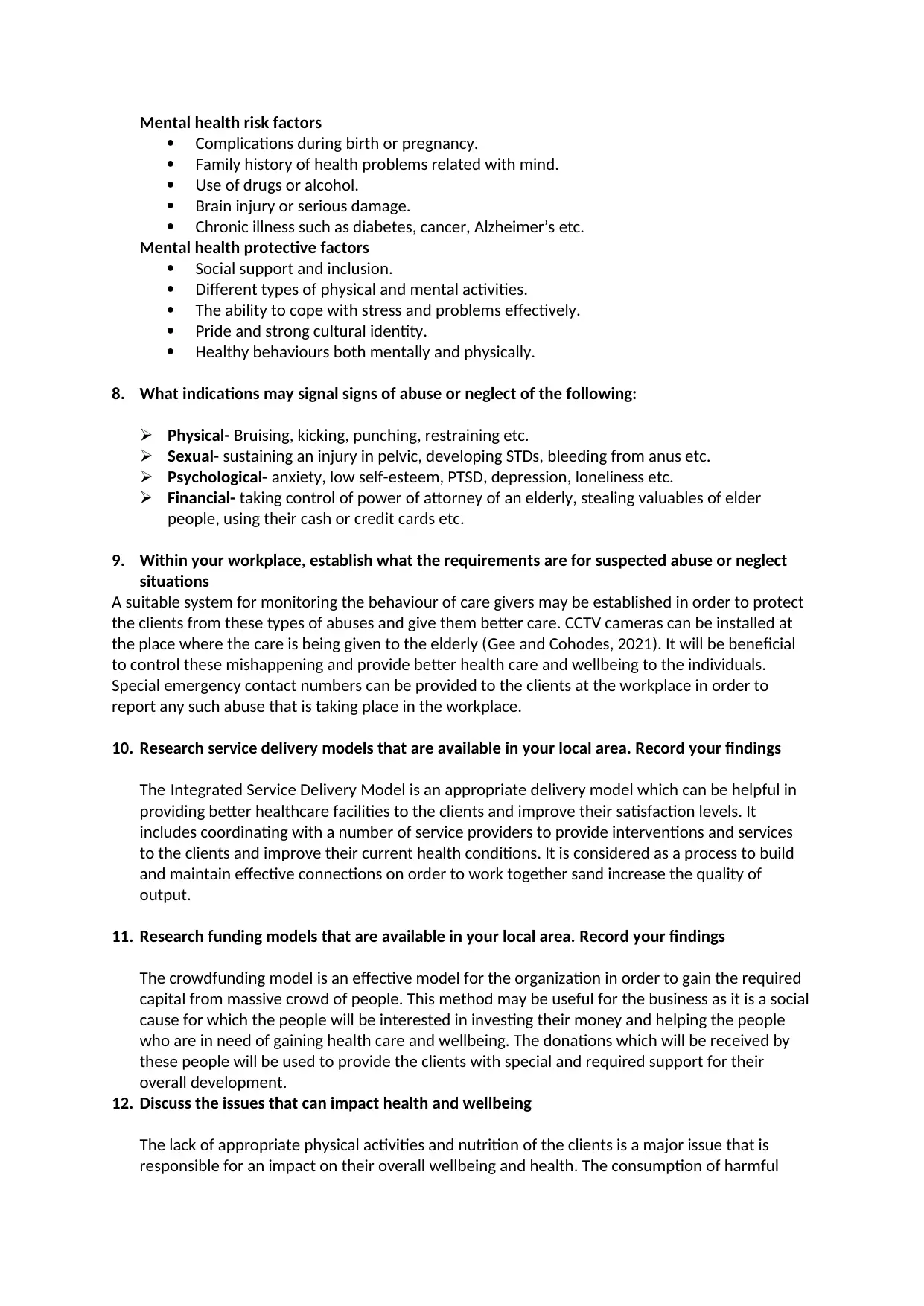
Mental health risk factors
Complications during birth or pregnancy.
Family history of health problems related with mind.
Use of drugs or alcohol.
Brain injury or serious damage.
Chronic illness such as diabetes, cancer, Alzheimer’s etc.
Mental health protective factors
Social support and inclusion.
Different types of physical and mental activities.
The ability to cope with stress and problems effectively.
Pride and strong cultural identity.
Healthy behaviours both mentally and physically.
8. What indications may signal signs of abuse or neglect of the following:
Physical- Bruising, kicking, punching, restraining etc.
Sexual- sustaining an injury in pelvic, developing STDs, bleeding from anus etc.
Psychological- anxiety, low self-esteem, PTSD, depression, loneliness etc.
Financial- taking control of power of attorney of an elderly, stealing valuables of elder
people, using their cash or credit cards etc.
9. Within your workplace, establish what the requirements are for suspected abuse or neglect
situations
A suitable system for monitoring the behaviour of care givers may be established in order to protect
the clients from these types of abuses and give them better care. CCTV cameras can be installed at
the place where the care is being given to the elderly (Gee and Cohodes, 2021). It will be beneficial
to control these mishappening and provide better health care and wellbeing to the individuals.
Special emergency contact numbers can be provided to the clients at the workplace in order to
report any such abuse that is taking place in the workplace.
10. Research service delivery models that are available in your local area. Record your findings
The Integrated Service Delivery Model is an appropriate delivery model which can be helpful in
providing better healthcare facilities to the clients and improve their satisfaction levels. It
includes coordinating with a number of service providers to provide interventions and services
to the clients and improve their current health conditions. It is considered as a process to build
and maintain effective connections on order to work together sand increase the quality of
output.
11. Research funding models that are available in your local area. Record your findings
The crowdfunding model is an effective model for the organization in order to gain the required
capital from massive crowd of people. This method may be useful for the business as it is a social
cause for which the people will be interested in investing their money and helping the people
who are in need of gaining health care and wellbeing. The donations which will be received by
these people will be used to provide the clients with special and required support for their
overall development.
12. Discuss the issues that can impact health and wellbeing
The lack of appropriate physical activities and nutrition of the clients is a major issue that is
responsible for an impact on their overall wellbeing and health. The consumption of harmful
Complications during birth or pregnancy.
Family history of health problems related with mind.
Use of drugs or alcohol.
Brain injury or serious damage.
Chronic illness such as diabetes, cancer, Alzheimer’s etc.
Mental health protective factors
Social support and inclusion.
Different types of physical and mental activities.
The ability to cope with stress and problems effectively.
Pride and strong cultural identity.
Healthy behaviours both mentally and physically.
8. What indications may signal signs of abuse or neglect of the following:
Physical- Bruising, kicking, punching, restraining etc.
Sexual- sustaining an injury in pelvic, developing STDs, bleeding from anus etc.
Psychological- anxiety, low self-esteem, PTSD, depression, loneliness etc.
Financial- taking control of power of attorney of an elderly, stealing valuables of elder
people, using their cash or credit cards etc.
9. Within your workplace, establish what the requirements are for suspected abuse or neglect
situations
A suitable system for monitoring the behaviour of care givers may be established in order to protect
the clients from these types of abuses and give them better care. CCTV cameras can be installed at
the place where the care is being given to the elderly (Gee and Cohodes, 2021). It will be beneficial
to control these mishappening and provide better health care and wellbeing to the individuals.
Special emergency contact numbers can be provided to the clients at the workplace in order to
report any such abuse that is taking place in the workplace.
10. Research service delivery models that are available in your local area. Record your findings
The Integrated Service Delivery Model is an appropriate delivery model which can be helpful in
providing better healthcare facilities to the clients and improve their satisfaction levels. It
includes coordinating with a number of service providers to provide interventions and services
to the clients and improve their current health conditions. It is considered as a process to build
and maintain effective connections on order to work together sand increase the quality of
output.
11. Research funding models that are available in your local area. Record your findings
The crowdfunding model is an effective model for the organization in order to gain the required
capital from massive crowd of people. This method may be useful for the business as it is a social
cause for which the people will be interested in investing their money and helping the people
who are in need of gaining health care and wellbeing. The donations which will be received by
these people will be used to provide the clients with special and required support for their
overall development.
12. Discuss the issues that can impact health and wellbeing
The lack of appropriate physical activities and nutrition of the clients is a major issue that is
responsible for an impact on their overall wellbeing and health. The consumption of harmful
Secure Best Marks with AI Grader
Need help grading? Try our AI Grader for instant feedback on your assignments.
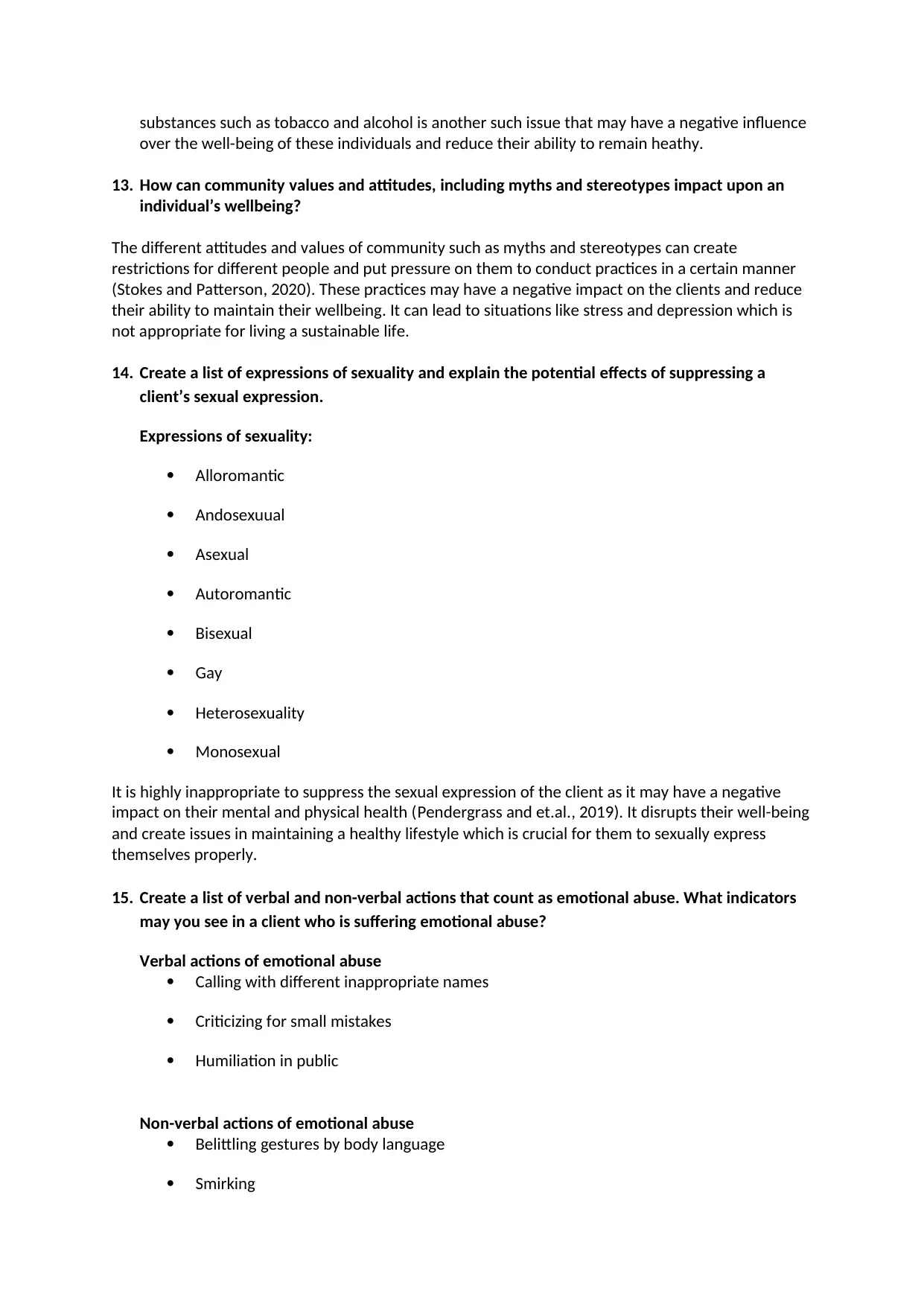
substances such as tobacco and alcohol is another such issue that may have a negative influence
over the well-being of these individuals and reduce their ability to remain heathy.
13. How can community values and attitudes, including myths and stereotypes impact upon an
individual’s wellbeing?
The different attitudes and values of community such as myths and stereotypes can create
restrictions for different people and put pressure on them to conduct practices in a certain manner
(Stokes and Patterson, 2020). These practices may have a negative impact on the clients and reduce
their ability to maintain their wellbeing. It can lead to situations like stress and depression which is
not appropriate for living a sustainable life.
14. Create a list of expressions of sexuality and explain the potential effects of suppressing a
client’s sexual expression.
Expressions of sexuality:
Alloromantic
Andosexuual
Asexual
Autoromantic
Bisexual
Gay
Heterosexuality
Monosexual
It is highly inappropriate to suppress the sexual expression of the client as it may have a negative
impact on their mental and physical health (Pendergrass and et.al., 2019). It disrupts their well-being
and create issues in maintaining a healthy lifestyle which is crucial for them to sexually express
themselves properly.
15. Create a list of verbal and non-verbal actions that count as emotional abuse. What indicators
may you see in a client who is suffering emotional abuse?
Verbal actions of emotional abuse
Calling with different inappropriate names
Criticizing for small mistakes
Humiliation in public
Non-verbal actions of emotional abuse
Belittling gestures by body language
Smirking
over the well-being of these individuals and reduce their ability to remain heathy.
13. How can community values and attitudes, including myths and stereotypes impact upon an
individual’s wellbeing?
The different attitudes and values of community such as myths and stereotypes can create
restrictions for different people and put pressure on them to conduct practices in a certain manner
(Stokes and Patterson, 2020). These practices may have a negative impact on the clients and reduce
their ability to maintain their wellbeing. It can lead to situations like stress and depression which is
not appropriate for living a sustainable life.
14. Create a list of expressions of sexuality and explain the potential effects of suppressing a
client’s sexual expression.
Expressions of sexuality:
Alloromantic
Andosexuual
Asexual
Autoromantic
Bisexual
Gay
Heterosexuality
Monosexual
It is highly inappropriate to suppress the sexual expression of the client as it may have a negative
impact on their mental and physical health (Pendergrass and et.al., 2019). It disrupts their well-being
and create issues in maintaining a healthy lifestyle which is crucial for them to sexually express
themselves properly.
15. Create a list of verbal and non-verbal actions that count as emotional abuse. What indicators
may you see in a client who is suffering emotional abuse?
Verbal actions of emotional abuse
Calling with different inappropriate names
Criticizing for small mistakes
Humiliation in public
Non-verbal actions of emotional abuse
Belittling gestures by body language
Smirking
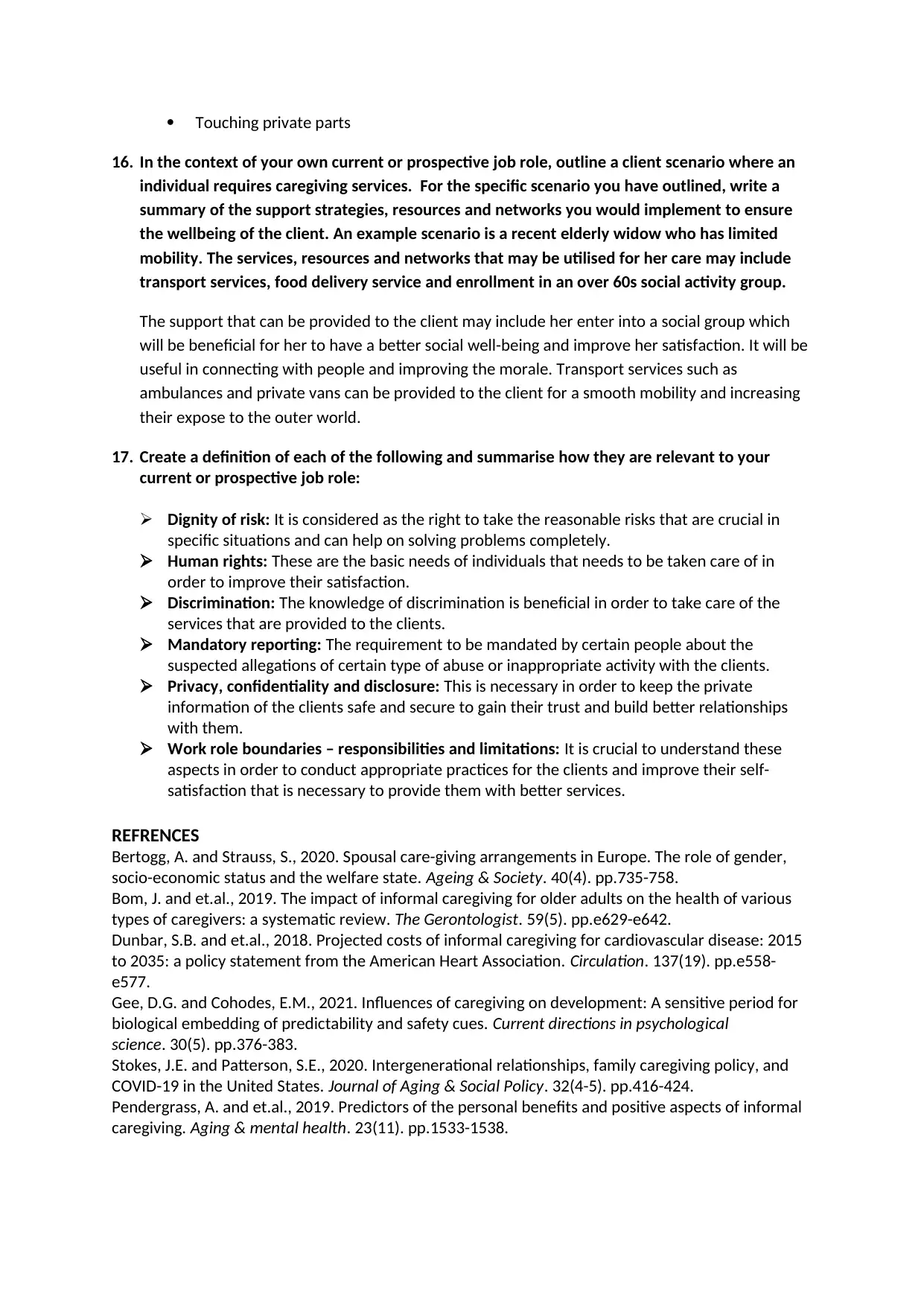
Touching private parts
16. In the context of your own current or prospective job role, outline a client scenario where an
individual requires caregiving services. For the specific scenario you have outlined, write a
summary of the support strategies, resources and networks you would implement to ensure
the wellbeing of the client. An example scenario is a recent elderly widow who has limited
mobility. The services, resources and networks that may be utilised for her care may include
transport services, food delivery service and enrollment in an over 60s social activity group.
The support that can be provided to the client may include her enter into a social group which
will be beneficial for her to have a better social well-being and improve her satisfaction. It will be
useful in connecting with people and improving the morale. Transport services such as
ambulances and private vans can be provided to the client for a smooth mobility and increasing
their expose to the outer world.
17. Create a definition of each of the following and summarise how they are relevant to your
current or prospective job role:
Dignity of risk: It is considered as the right to take the reasonable risks that are crucial in
specific situations and can help on solving problems completely.
Human rights: These are the basic needs of individuals that needs to be taken care of in
order to improve their satisfaction.
Discrimination: The knowledge of discrimination is beneficial in order to take care of the
services that are provided to the clients.
Mandatory reporting: The requirement to be mandated by certain people about the
suspected allegations of certain type of abuse or inappropriate activity with the clients.
Privacy, confidentiality and disclosure: This is necessary in order to keep the private
information of the clients safe and secure to gain their trust and build better relationships
with them.
Work role boundaries – responsibilities and limitations: It is crucial to understand these
aspects in order to conduct appropriate practices for the clients and improve their self-
satisfaction that is necessary to provide them with better services.
REFRENCES
Bertogg, A. and Strauss, S., 2020. Spousal care-giving arrangements in Europe. The role of gender,
socio-economic status and the welfare state. Ageing & Society. 40(4). pp.735-758.
Bom, J. and et.al., 2019. The impact of informal caregiving for older adults on the health of various
types of caregivers: a systematic review. The Gerontologist. 59(5). pp.e629-e642.
Dunbar, S.B. and et.al., 2018. Projected costs of informal caregiving for cardiovascular disease: 2015
to 2035: a policy statement from the American Heart Association. Circulation. 137(19). pp.e558-
e577.
Gee, D.G. and Cohodes, E.M., 2021. Influences of caregiving on development: A sensitive period for
biological embedding of predictability and safety cues. Current directions in psychological
science. 30(5). pp.376-383.
Stokes, J.E. and Patterson, S.E., 2020. Intergenerational relationships, family caregiving policy, and
COVID-19 in the United States. Journal of Aging & Social Policy. 32(4-5). pp.416-424.
Pendergrass, A. and et.al., 2019. Predictors of the personal benefits and positive aspects of informal
caregiving. Aging & mental health. 23(11). pp.1533-1538.
16. In the context of your own current or prospective job role, outline a client scenario where an
individual requires caregiving services. For the specific scenario you have outlined, write a
summary of the support strategies, resources and networks you would implement to ensure
the wellbeing of the client. An example scenario is a recent elderly widow who has limited
mobility. The services, resources and networks that may be utilised for her care may include
transport services, food delivery service and enrollment in an over 60s social activity group.
The support that can be provided to the client may include her enter into a social group which
will be beneficial for her to have a better social well-being and improve her satisfaction. It will be
useful in connecting with people and improving the morale. Transport services such as
ambulances and private vans can be provided to the client for a smooth mobility and increasing
their expose to the outer world.
17. Create a definition of each of the following and summarise how they are relevant to your
current or prospective job role:
Dignity of risk: It is considered as the right to take the reasonable risks that are crucial in
specific situations and can help on solving problems completely.
Human rights: These are the basic needs of individuals that needs to be taken care of in
order to improve their satisfaction.
Discrimination: The knowledge of discrimination is beneficial in order to take care of the
services that are provided to the clients.
Mandatory reporting: The requirement to be mandated by certain people about the
suspected allegations of certain type of abuse or inappropriate activity with the clients.
Privacy, confidentiality and disclosure: This is necessary in order to keep the private
information of the clients safe and secure to gain their trust and build better relationships
with them.
Work role boundaries – responsibilities and limitations: It is crucial to understand these
aspects in order to conduct appropriate practices for the clients and improve their self-
satisfaction that is necessary to provide them with better services.
REFRENCES
Bertogg, A. and Strauss, S., 2020. Spousal care-giving arrangements in Europe. The role of gender,
socio-economic status and the welfare state. Ageing & Society. 40(4). pp.735-758.
Bom, J. and et.al., 2019. The impact of informal caregiving for older adults on the health of various
types of caregivers: a systematic review. The Gerontologist. 59(5). pp.e629-e642.
Dunbar, S.B. and et.al., 2018. Projected costs of informal caregiving for cardiovascular disease: 2015
to 2035: a policy statement from the American Heart Association. Circulation. 137(19). pp.e558-
e577.
Gee, D.G. and Cohodes, E.M., 2021. Influences of caregiving on development: A sensitive period for
biological embedding of predictability and safety cues. Current directions in psychological
science. 30(5). pp.376-383.
Stokes, J.E. and Patterson, S.E., 2020. Intergenerational relationships, family caregiving policy, and
COVID-19 in the United States. Journal of Aging & Social Policy. 32(4-5). pp.416-424.
Pendergrass, A. and et.al., 2019. Predictors of the personal benefits and positive aspects of informal
caregiving. Aging & mental health. 23(11). pp.1533-1538.
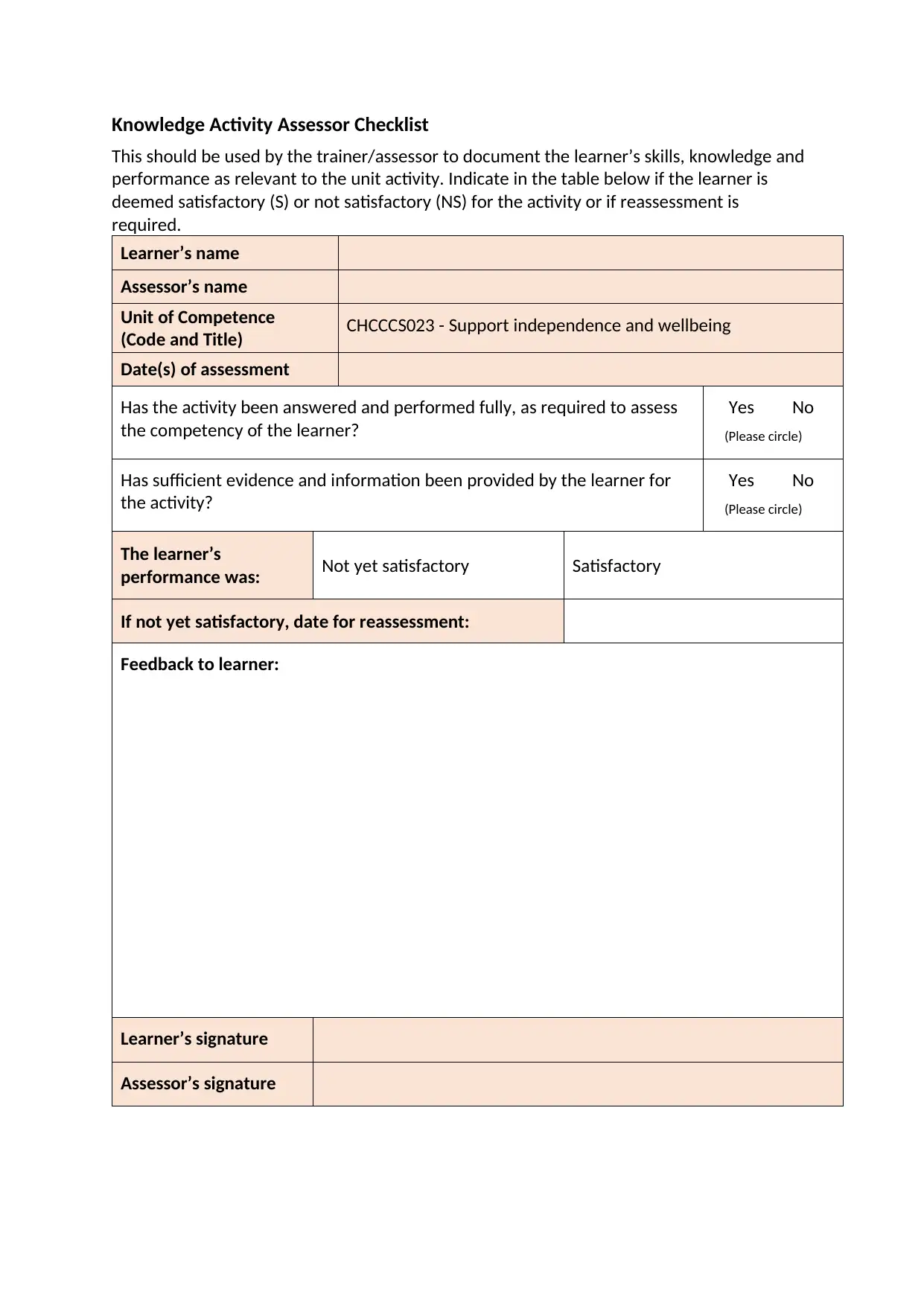
Knowledge Activity Assessor Checklist
This should be used by the trainer/assessor to document the learner’s skills, knowledge and
performance as relevant to the unit activity. Indicate in the table below if the learner is
deemed satisfactory (S) or not satisfactory (NS) for the activity or if reassessment is
required.
Learner’s name
Assessor’s name
Unit of Competence
(Code and Title) CHCCCS023 - Support independence and wellbeing
Date(s) of assessment
Has the activity been answered and performed fully, as required to assess
the competency of the learner?
Yes No
(Please circle)
Has sufficient evidence and information been provided by the learner for
the activity?
Yes No
(Please circle)
The learner’s
performance was: Not yet satisfactory Satisfactory
If not yet satisfactory, date for reassessment:
Feedback to learner:
Learner’s signature
Assessor’s signature
This should be used by the trainer/assessor to document the learner’s skills, knowledge and
performance as relevant to the unit activity. Indicate in the table below if the learner is
deemed satisfactory (S) or not satisfactory (NS) for the activity or if reassessment is
required.
Learner’s name
Assessor’s name
Unit of Competence
(Code and Title) CHCCCS023 - Support independence and wellbeing
Date(s) of assessment
Has the activity been answered and performed fully, as required to assess
the competency of the learner?
Yes No
(Please circle)
Has sufficient evidence and information been provided by the learner for
the activity?
Yes No
(Please circle)
The learner’s
performance was: Not yet satisfactory Satisfactory
If not yet satisfactory, date for reassessment:
Feedback to learner:
Learner’s signature
Assessor’s signature
Paraphrase This Document
Need a fresh take? Get an instant paraphrase of this document with our AI Paraphraser
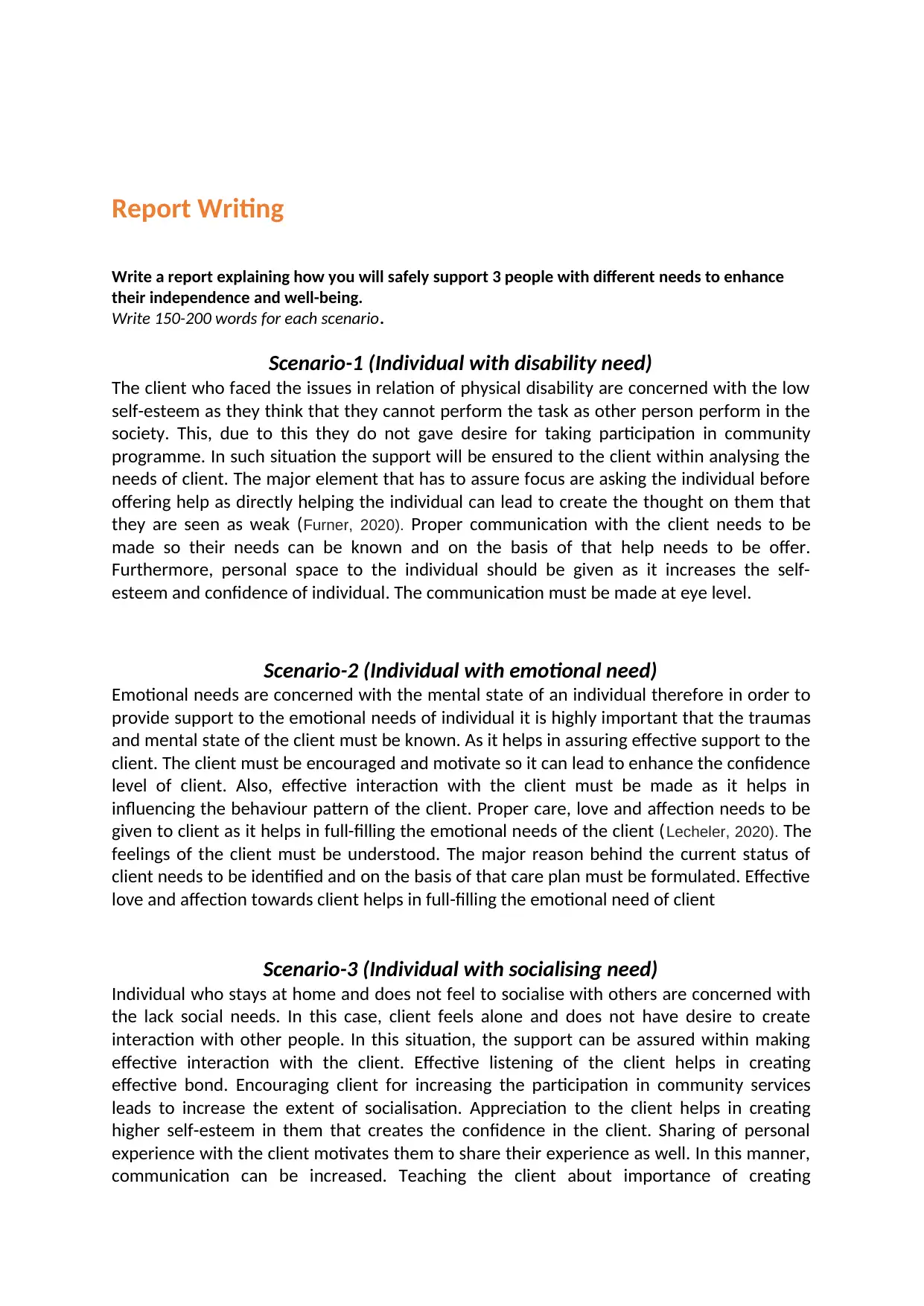
Report Writing
Write a report explaining how you will safely support 3 people with different needs to enhance
their independence and well-being.
Write 150-200 words for each scenario.
Scenario-1 (Individual with disability need)
The client who faced the issues in relation of physical disability are concerned with the low
self-esteem as they think that they cannot perform the task as other person perform in the
society. This, due to this they do not gave desire for taking participation in community
programme. In such situation the support will be ensured to the client within analysing the
needs of client. The major element that has to assure focus are asking the individual before
offering help as directly helping the individual can lead to create the thought on them that
they are seen as weak (Furner, 2020). Proper communication with the client needs to be
made so their needs can be known and on the basis of that help needs to be offer.
Furthermore, personal space to the individual should be given as it increases the self-
esteem and confidence of individual. The communication must be made at eye level.
Scenario-2 (Individual with emotional need)
Emotional needs are concerned with the mental state of an individual therefore in order to
provide support to the emotional needs of individual it is highly important that the traumas
and mental state of the client must be known. As it helps in assuring effective support to the
client. The client must be encouraged and motivate so it can lead to enhance the confidence
level of client. Also, effective interaction with the client must be made as it helps in
influencing the behaviour pattern of the client. Proper care, love and affection needs to be
given to client as it helps in full-filling the emotional needs of the client (Lecheler, 2020). The
feelings of the client must be understood. The major reason behind the current status of
client needs to be identified and on the basis of that care plan must be formulated. Effective
love and affection towards client helps in full-filling the emotional need of client
Scenario-3 (Individual with socialising need)
Individual who stays at home and does not feel to socialise with others are concerned with
the lack social needs. In this case, client feels alone and does not have desire to create
interaction with other people. In this situation, the support can be assured within making
effective interaction with the client. Effective listening of the client helps in creating
effective bond. Encouraging client for increasing the participation in community services
leads to increase the extent of socialisation. Appreciation to the client helps in creating
higher self-esteem in them that creates the confidence in the client. Sharing of personal
experience with the client motivates them to share their experience as well. In this manner,
communication can be increased. Teaching the client about importance of creating
Write a report explaining how you will safely support 3 people with different needs to enhance
their independence and well-being.
Write 150-200 words for each scenario.
Scenario-1 (Individual with disability need)
The client who faced the issues in relation of physical disability are concerned with the low
self-esteem as they think that they cannot perform the task as other person perform in the
society. This, due to this they do not gave desire for taking participation in community
programme. In such situation the support will be ensured to the client within analysing the
needs of client. The major element that has to assure focus are asking the individual before
offering help as directly helping the individual can lead to create the thought on them that
they are seen as weak (Furner, 2020). Proper communication with the client needs to be
made so their needs can be known and on the basis of that help needs to be offer.
Furthermore, personal space to the individual should be given as it increases the self-
esteem and confidence of individual. The communication must be made at eye level.
Scenario-2 (Individual with emotional need)
Emotional needs are concerned with the mental state of an individual therefore in order to
provide support to the emotional needs of individual it is highly important that the traumas
and mental state of the client must be known. As it helps in assuring effective support to the
client. The client must be encouraged and motivate so it can lead to enhance the confidence
level of client. Also, effective interaction with the client must be made as it helps in
influencing the behaviour pattern of the client. Proper care, love and affection needs to be
given to client as it helps in full-filling the emotional needs of the client (Lecheler, 2020). The
feelings of the client must be understood. The major reason behind the current status of
client needs to be identified and on the basis of that care plan must be formulated. Effective
love and affection towards client helps in full-filling the emotional need of client
Scenario-3 (Individual with socialising need)
Individual who stays at home and does not feel to socialise with others are concerned with
the lack social needs. In this case, client feels alone and does not have desire to create
interaction with other people. In this situation, the support can be assured within making
effective interaction with the client. Effective listening of the client helps in creating
effective bond. Encouraging client for increasing the participation in community services
leads to increase the extent of socialisation. Appreciation to the client helps in creating
higher self-esteem in them that creates the confidence in the client. Sharing of personal
experience with the client motivates them to share their experience as well. In this manner,
communication can be increased. Teaching the client about importance of creating
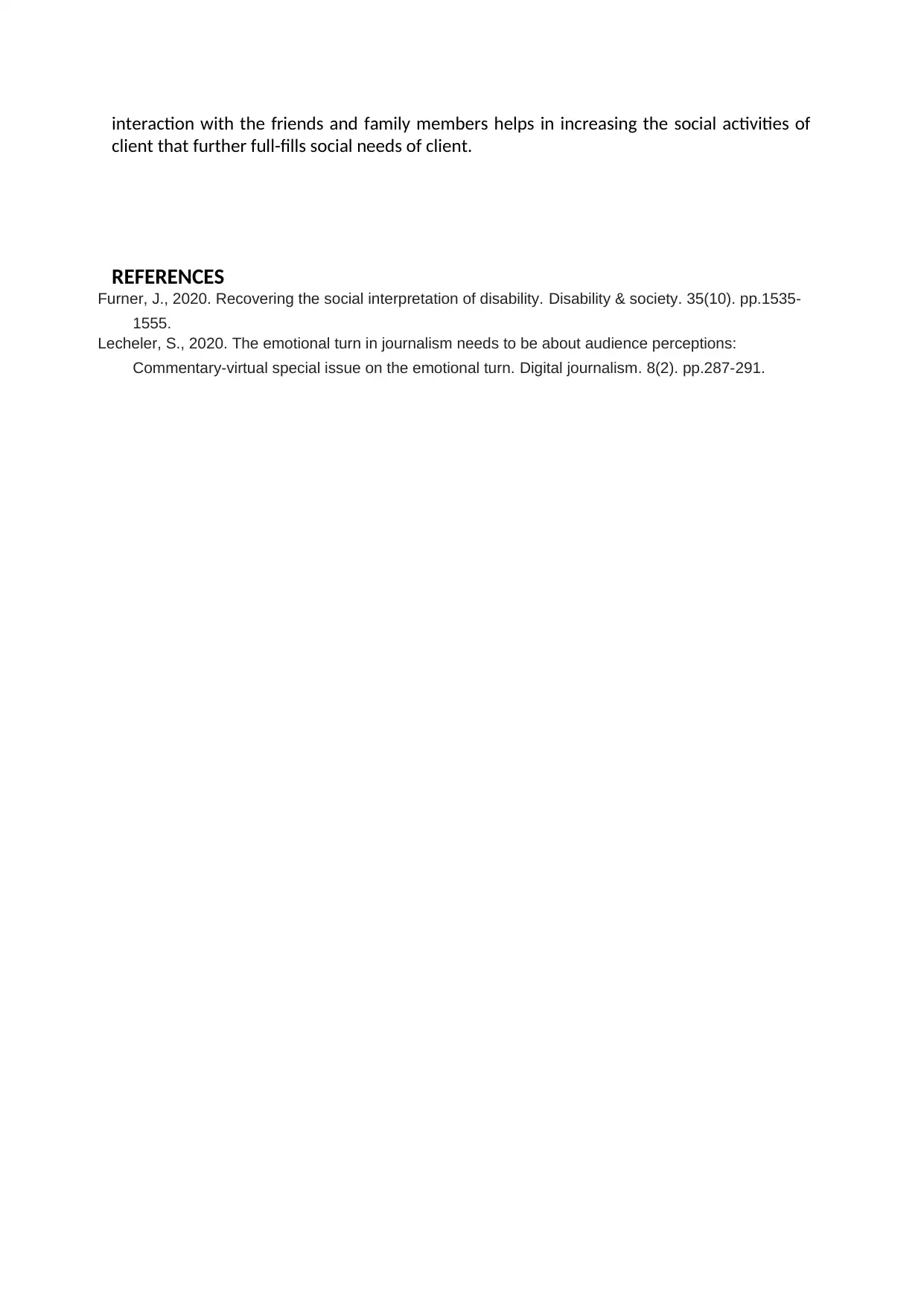
interaction with the friends and family members helps in increasing the social activities of
client that further full-fills social needs of client.
REFERENCES
Furner, J., 2020. Recovering the social interpretation of disability. Disability & society. 35(10). pp.1535-
1555.
Lecheler, S., 2020. The emotional turn in journalism needs to be about audience perceptions:
Commentary-virtual special issue on the emotional turn. Digital journalism. 8(2). pp.287-291.
client that further full-fills social needs of client.
REFERENCES
Furner, J., 2020. Recovering the social interpretation of disability. Disability & society. 35(10). pp.1535-
1555.
Lecheler, S., 2020. The emotional turn in journalism needs to be about audience perceptions:
Commentary-virtual special issue on the emotional turn. Digital journalism. 8(2). pp.287-291.
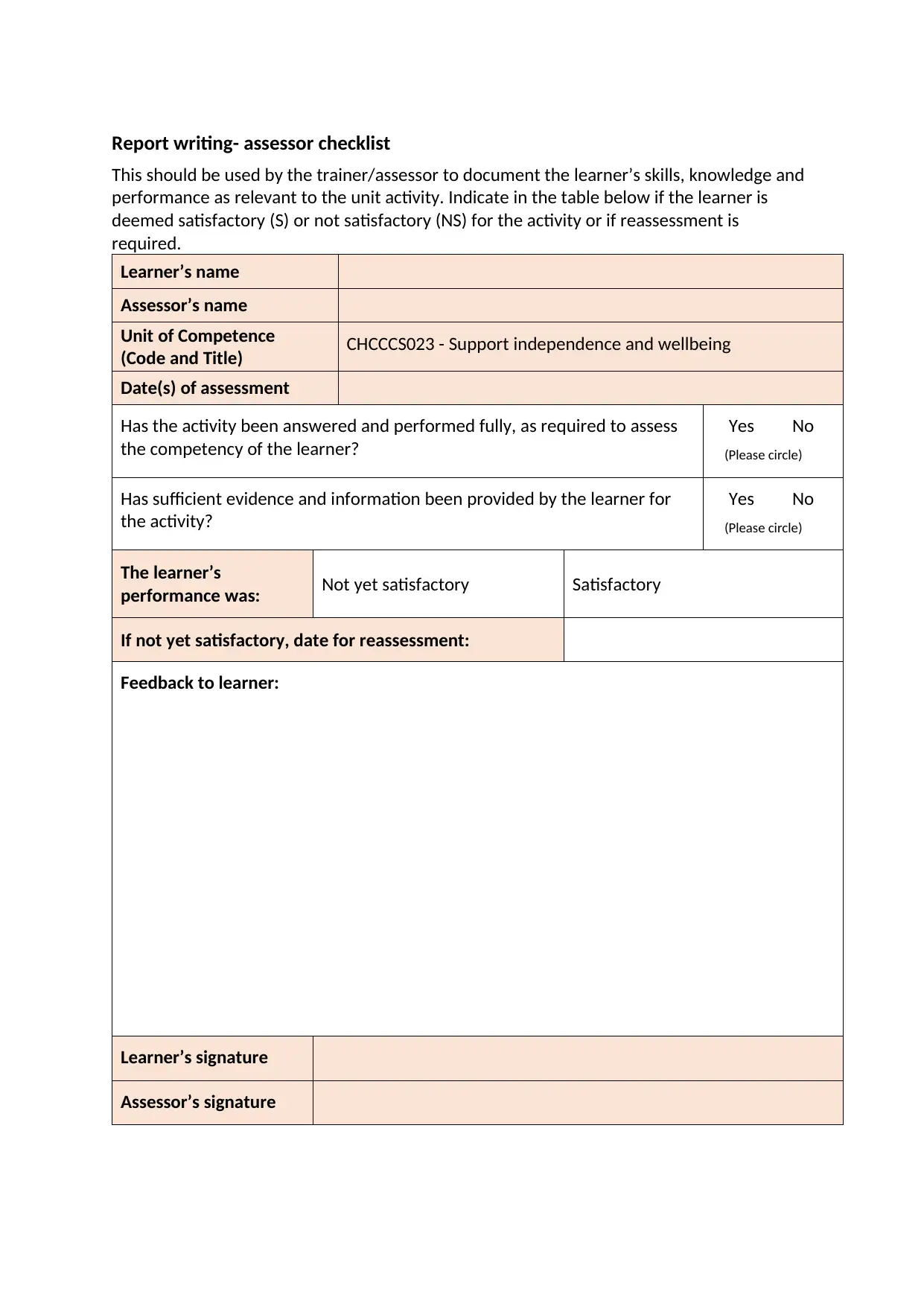
Report writing- assessor checklist
This should be used by the trainer/assessor to document the learner’s skills, knowledge and
performance as relevant to the unit activity. Indicate in the table below if the learner is
deemed satisfactory (S) or not satisfactory (NS) for the activity or if reassessment is
required.
Learner’s name
Assessor’s name
Unit of Competence
(Code and Title) CHCCCS023 - Support independence and wellbeing
Date(s) of assessment
Has the activity been answered and performed fully, as required to assess
the competency of the learner?
Yes No
(Please circle)
Has sufficient evidence and information been provided by the learner for
the activity?
Yes No
(Please circle)
The learner’s
performance was: Not yet satisfactory Satisfactory
If not yet satisfactory, date for reassessment:
Feedback to learner:
Learner’s signature
Assessor’s signature
This should be used by the trainer/assessor to document the learner’s skills, knowledge and
performance as relevant to the unit activity. Indicate in the table below if the learner is
deemed satisfactory (S) or not satisfactory (NS) for the activity or if reassessment is
required.
Learner’s name
Assessor’s name
Unit of Competence
(Code and Title) CHCCCS023 - Support independence and wellbeing
Date(s) of assessment
Has the activity been answered and performed fully, as required to assess
the competency of the learner?
Yes No
(Please circle)
Has sufficient evidence and information been provided by the learner for
the activity?
Yes No
(Please circle)
The learner’s
performance was: Not yet satisfactory Satisfactory
If not yet satisfactory, date for reassessment:
Feedback to learner:
Learner’s signature
Assessor’s signature
Secure Best Marks with AI Grader
Need help grading? Try our AI Grader for instant feedback on your assignments.
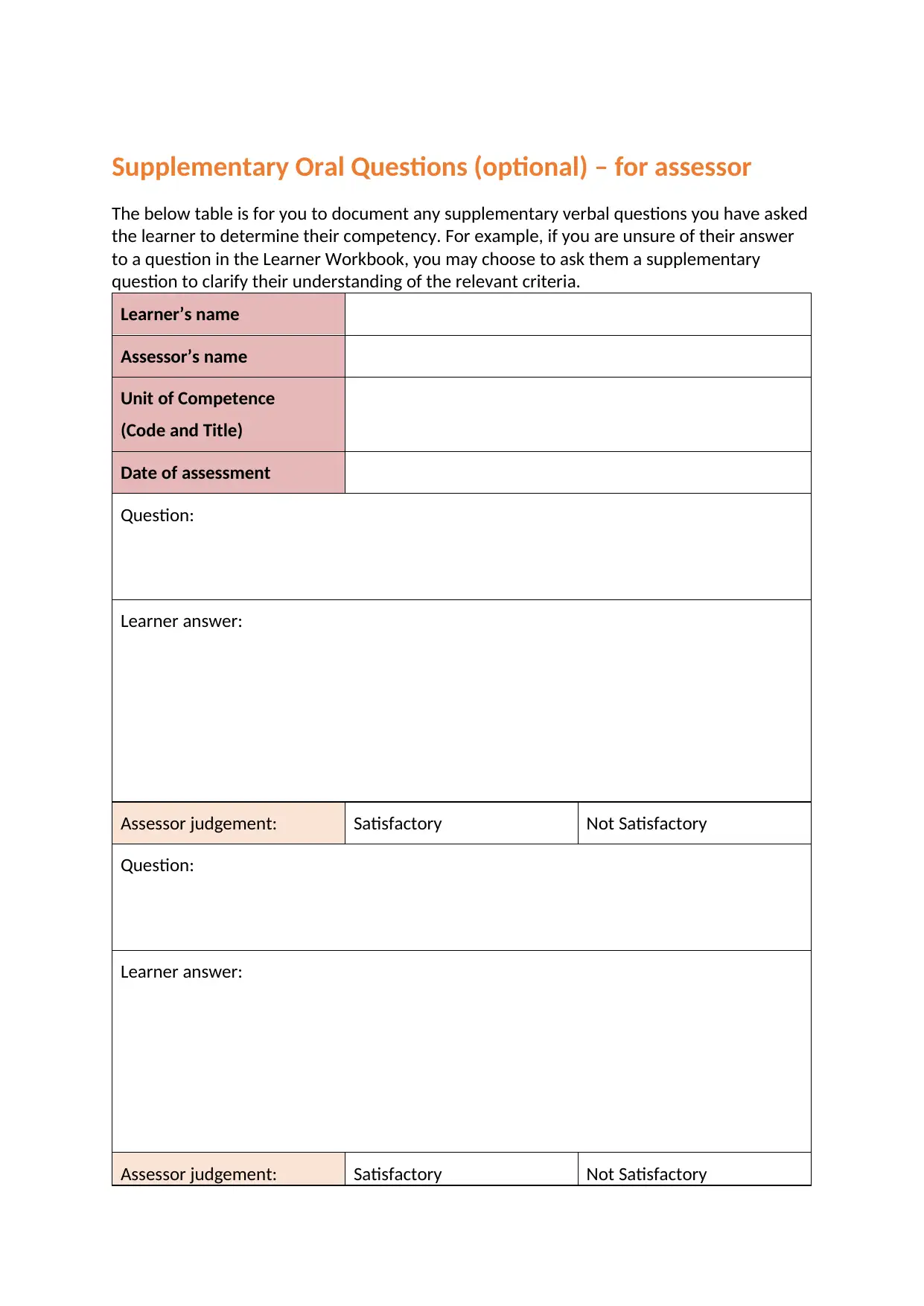
Supplementary Oral Questions (optional) – for assessor
The below table is for you to document any supplementary verbal questions you have asked
the learner to determine their competency. For example, if you are unsure of their answer
to a question in the Learner Workbook, you may choose to ask them a supplementary
question to clarify their understanding of the relevant criteria.
Learner’s name
Assessor’s name
Unit of Competence
(Code and Title)
Date of assessment
Question:
Learner answer:
Assessor judgement: Satisfactory Not Satisfactory
Question:
Learner answer:
Assessor judgement: Satisfactory Not Satisfactory
The below table is for you to document any supplementary verbal questions you have asked
the learner to determine their competency. For example, if you are unsure of their answer
to a question in the Learner Workbook, you may choose to ask them a supplementary
question to clarify their understanding of the relevant criteria.
Learner’s name
Assessor’s name
Unit of Competence
(Code and Title)
Date of assessment
Question:
Learner answer:
Assessor judgement: Satisfactory Not Satisfactory
Question:
Learner answer:
Assessor judgement: Satisfactory Not Satisfactory

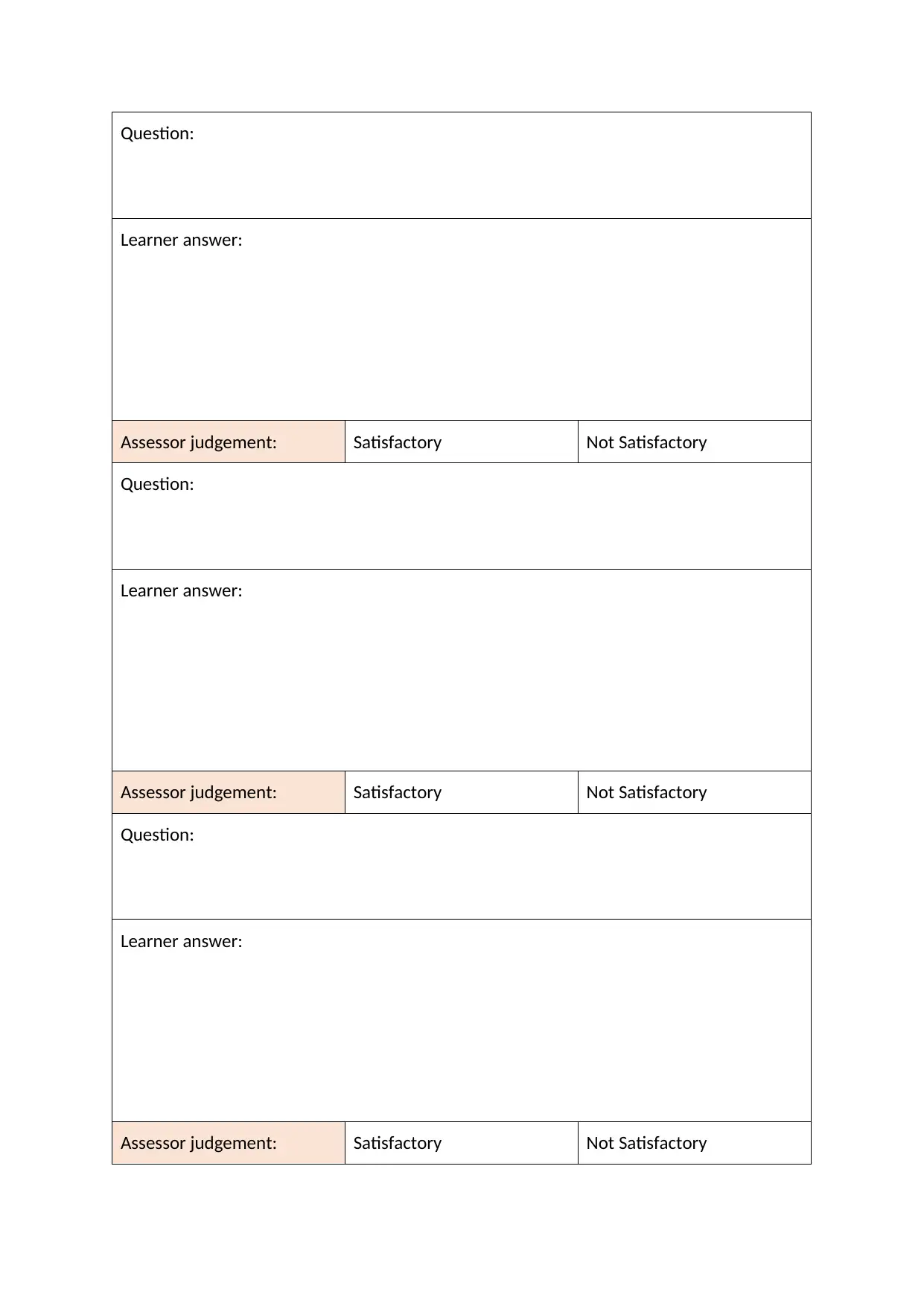
Question:
Learner answer:
Assessor judgement: Satisfactory Not Satisfactory
Question:
Learner answer:
Assessor judgement: Satisfactory Not Satisfactory
Question:
Learner answer:
Assessor judgement: Satisfactory Not Satisfactory
Learner answer:
Assessor judgement: Satisfactory Not Satisfactory
Question:
Learner answer:
Assessor judgement: Satisfactory Not Satisfactory
Question:
Learner answer:
Assessor judgement: Satisfactory Not Satisfactory
Paraphrase This Document
Need a fresh take? Get an instant paraphrase of this document with our AI Paraphraser
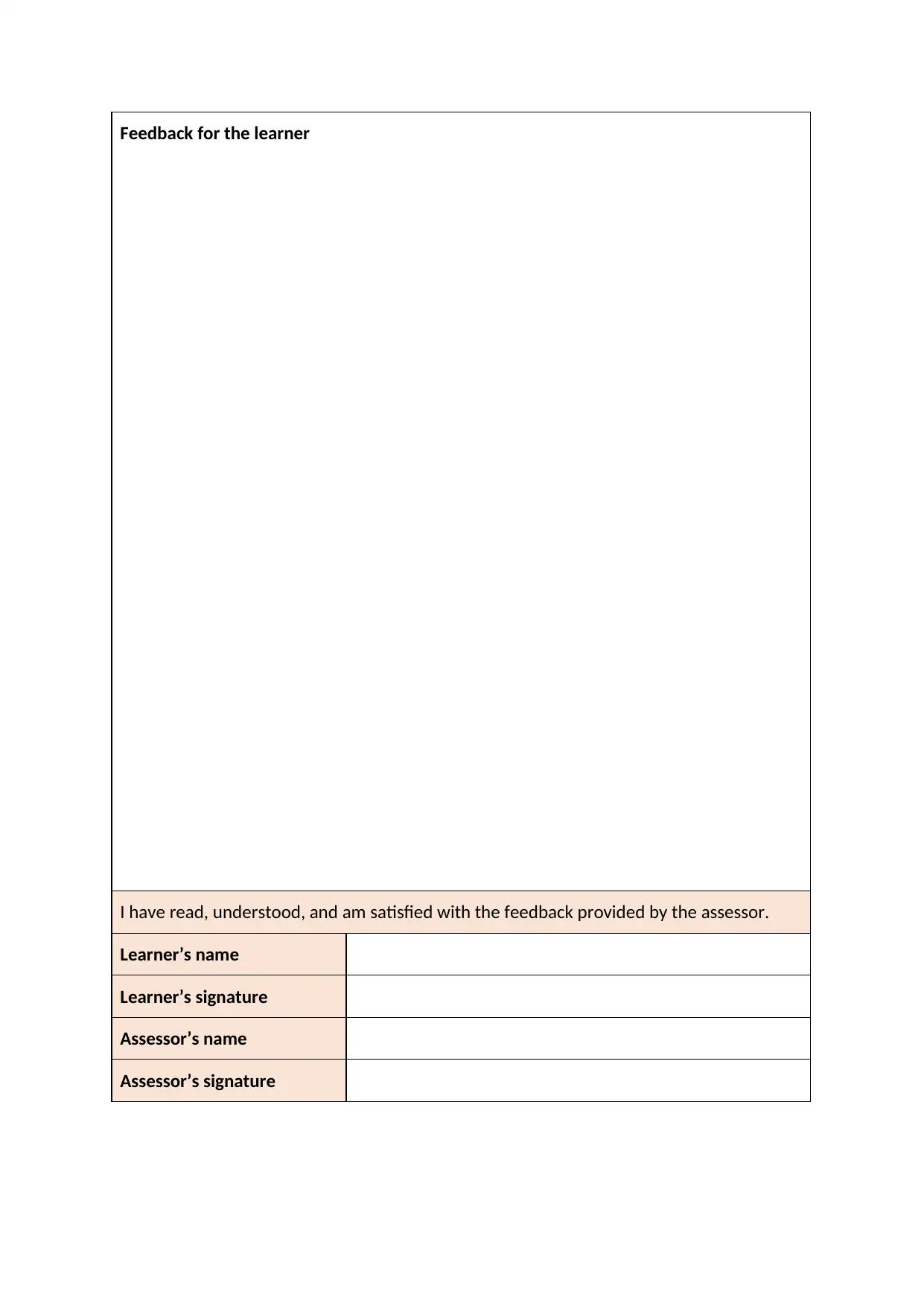
Feedback for the learner
I have read, understood, and am satisfied with the feedback provided by the assessor.
Learner’s name
Learner’s signature
Assessor’s name
Assessor’s signature
I have read, understood, and am satisfied with the feedback provided by the assessor.
Learner’s name
Learner’s signature
Assessor’s name
Assessor’s signature
1 out of 56
Related Documents
Your All-in-One AI-Powered Toolkit for Academic Success.
+13062052269
info@desklib.com
Available 24*7 on WhatsApp / Email
![[object Object]](/_next/static/media/star-bottom.7253800d.svg)
Unlock your academic potential
© 2024 | Zucol Services PVT LTD | All rights reserved.



